Categories
Subjects
Authors
Artists
Venues
Locations
Calendar
Filter
Done
July 10, 2024 – Review
Gabriel Chaile’s “Los jóvenes olvidaron sus canciones o Tierra de Fuego”
Filipa Ramos
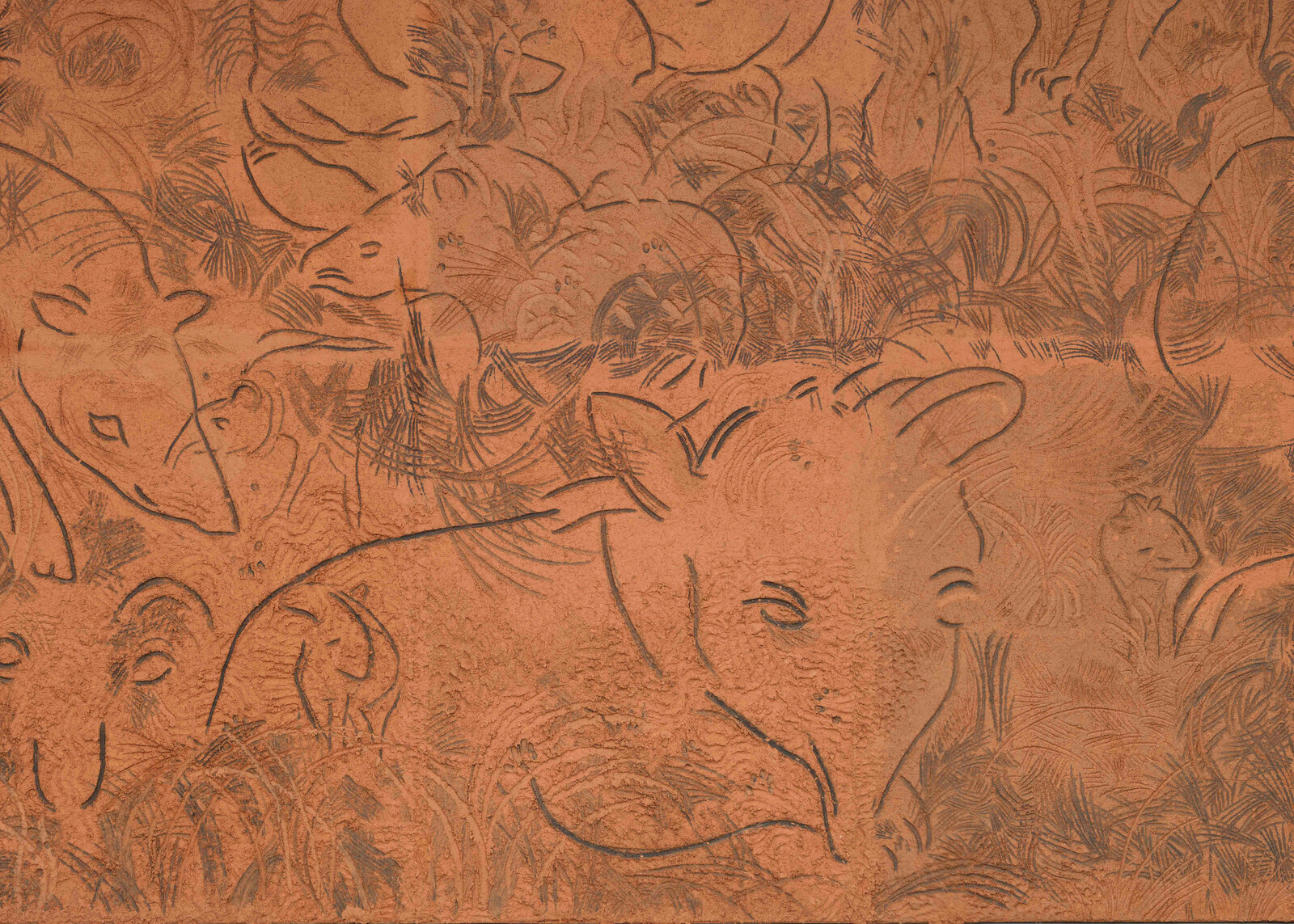
Humans became human by representing themselves and others. By painting images on cave walls of animals that mimicked those they chased, early humans produced the imaginaries and traditions that define us as a species. With their drawings, they invented past and future and connected memory to desire, remembrance to anticipation, trauma to anxiety. The images on those walls might be still, but the stories they told were in motion, animated by the light cast by flickering fires. As such, it could be said that the history of cinema predates written history. Cinema emerged from the animals whose images, engraved in their own blood and hair, expressed motion through time and space, and moved their audiences.
This awareness of the archaic nature of cinema, and its relationship to nature, is at the base of Gabriel Chaile’s memorable installation Selva Tucumana [Tucumán Jungle] (2024), which signals an important change in his artistic vocabulary away from the large-scale adobe figures for which he is best known. Born in San Miguel de Tucumán in 1985, the Lisbon-based artist has often sought inspiration in land and kin. His characteristic anthropomorphic sculptures—whose aesthetics echo the precolonial creations of his birthplace—are both private and public. Connected to …
June 17, 2024 – Review
“Patterns of (In)Security II”
Nina Chkareuli-Mdivani

Taking its name from Michel Houellebecq’s 2005 novel The Possibility of an Island, this artist-run space in Berlin’s Mitte neighborhood hosts the second iteration of a dual exhibition that hints at the possibility of establishing a space of refuge between divergent positions. Extending a collaboration that began in Tbilisi last year, Sabine Hornig and Tamuna Chabashvili seek to establish some common ground between idealism and pragmatism, collective and individual, order and freedom.
Hornig presents a sculpture and photograph engaging with the sustainability of democracy as it is accosted on all sides by populism, chauvinism, and realpolitik. Wahlkabine (2024) is a freestanding metal structure, the grids of which are patterned like bricks, inspired by Tbilisi balconies. In Georgia, these private-turned-public structures are markers of the turbulent 1990s, when citizens of a fledgling democracy were trying to carve out spaces for themselves in the new post-socialist reality. The architectural structure creates two small rooms that can only be entered from different sides.
Translating as “voting booth,” the sculpture observes you as you observe it. There are small mirrored tables in each of the divided sections, reminding the visitor of their personal responsibilities. In its evocation of the wall that once stood …
February 28, 2024 – Review
Tania Bruguera’s “Where Your Ideas Become Civic Actions (100 Hours Reading The Origins of Totalitarianism)”
Eugene Yiu Nam Cheung

In Germany’s increasingly censorious intellectual climate, Berlin’s Hamburger Bahnhof staged the Cuban artist Tania Bruguera’s “Where Your Ideas Become Civic Actions (100 Hours Reading The Origins of Totalitarianism)” inside its main hall. This participatory public reading of—and discussion around—Hannah Arendt’s The Origins of Totalitarianism (1951) was spread across four days, featuring the artist alongside writers such as Masha Gessen and Deborah Feldman, prominent artists in Berlin including Candice Breitz, and people from “the museum’s neighborhood.”
Speakers—mostly solo, sometimes in a trio, and even as a chorus—addressed the audience amid a spare scenography: a single rattan-upholstered rocking chair, illuminated from above by a beam of golden light. Hospital-gray bean bags and cardboard stools were strewn before it, stretching out towards the entrance of the museum and luring visitors into a collectivized consideration of “power and violence, plurality and morality, politics and truth.”
Microphones were connected to a sound system scattered haphazardly around the space, and synchronized with speakers outside the institution facing Invalidenstraße, a thoroughfare leading to Berlin’s central station, a few hundred meters away. Like the work’s title, Bruguera’s sonic gesture felt prescriptive—as if it were the artist’s duty to break Arendt out of the institution and onto the …
January 25, 2024 – Review
“As Though We Hid the Sun in a Sea of Stories”
Olexii Kuchanskyi
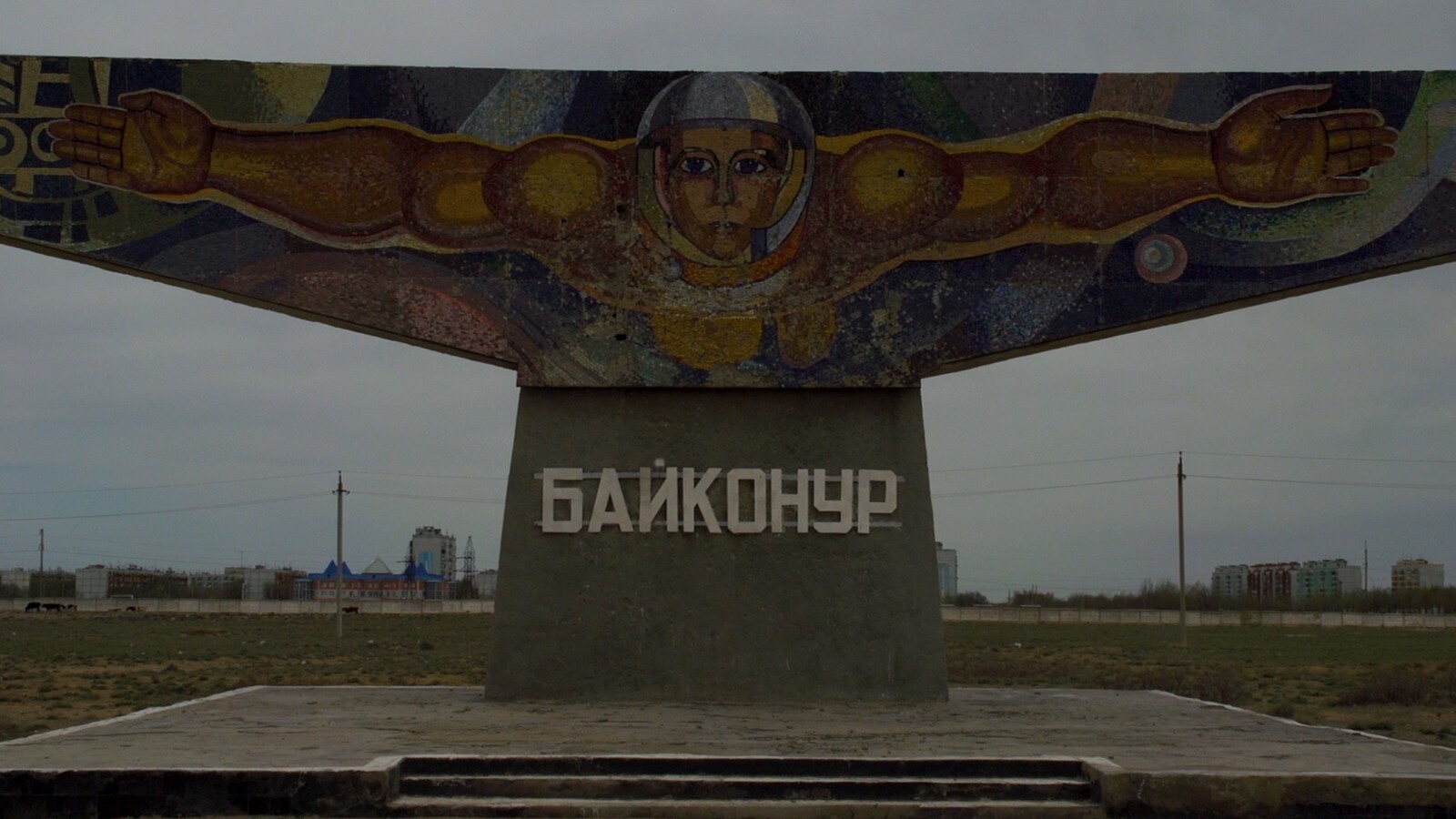
Against a backdrop of constant territorial changes in the former Soviet countries and the ongoing war in Ukraine, “As Though We Hid the Sun in a Sea of Stories” explores the “geopoetics of North Eurasia.” The term denotes heterogeneous, yet tightly interconnected, political and cultural contexts under oppressive regimes, ranging from the Russian Empire to contemporary Russian imperialism via Soviet colonialism. Framed in the handout by HKW’s director, Bonaventure Soh Bejeng Ndikung, as a way of “being and seeing the world through the prism of the Global East,” the show tries to avoid any “totalizing vision” in favor of multiple subjectivities and geographies.
To achieve this, the show’s curators—Cosmin Costinaș, Iaroslav Volovod, Nikolay Karabinovych, Saodat Ismailova, and Kimberly St. Julian-Varnon—have scattered the artworks across the museum in a way that foregrounds their discreteness, each piece separately lit and surrounded by empty space. Stories of colonialism, resistance, and artistic experimentation are encapsulated in these “monads,” yet the aversion to a “totalizing vision” extends to the bewildering absence of wall texts from the galleries (viewers hoping for context must flip through the handbook, which lacks a general plan of the show, to find a work description).
The exhibition’s main space is filled …
October 24, 2023 – Review
Coco Fusco’s “Tomorrow, I Will Become an Island”
JS Tennant

It comes as no surprise that “Tomorrow, I Will Become an Island” opens with documentation of Coco Fusco’s Two Undiscovered Amerindians Visit the West (1992–94): her justly famous performance with Guillermo Gómez-Peña, staged at the moment the world was tussling over how best to commemorate, or denigrate, the 500th anniversary of Columbus’s so-called “discovery” of the Americas. A prime benefit of the Cuban-American artist’s first major retrospective—curated by Léon Kruijswijk and Anna Gritz—is to be able to trace the arc of suggestive continuities within her impressive thirty-year body of work.
In Two Undiscovered Amerindians, Fusco and Gómez-Peña toured the world in a cage where they were displayed as “natives” of a recently discovered Caribbean island. A subsequent film, The Couple in the Cage: A Guatinaui Odyssey (1993), captures this performance and reactions from the public, its footage intercut with a montage of real-life circus sideshows, world fairs, and racist “ethnographic” dioramas. Attendants, acting as ringmasters, invite passersby to interact with the couple, who speak no English. Bananas are fed to them through the bars; the “female” can be made to dance; five dollars grants a titillating fondle of the “male specimen’s” genitalia. The island’s name, Guatinau, would be pronounced, in …
October 16, 2023 – Review
Lin May Saeed’s “The Snow Falls Slowly in Paradise”
Jesi Khadivi
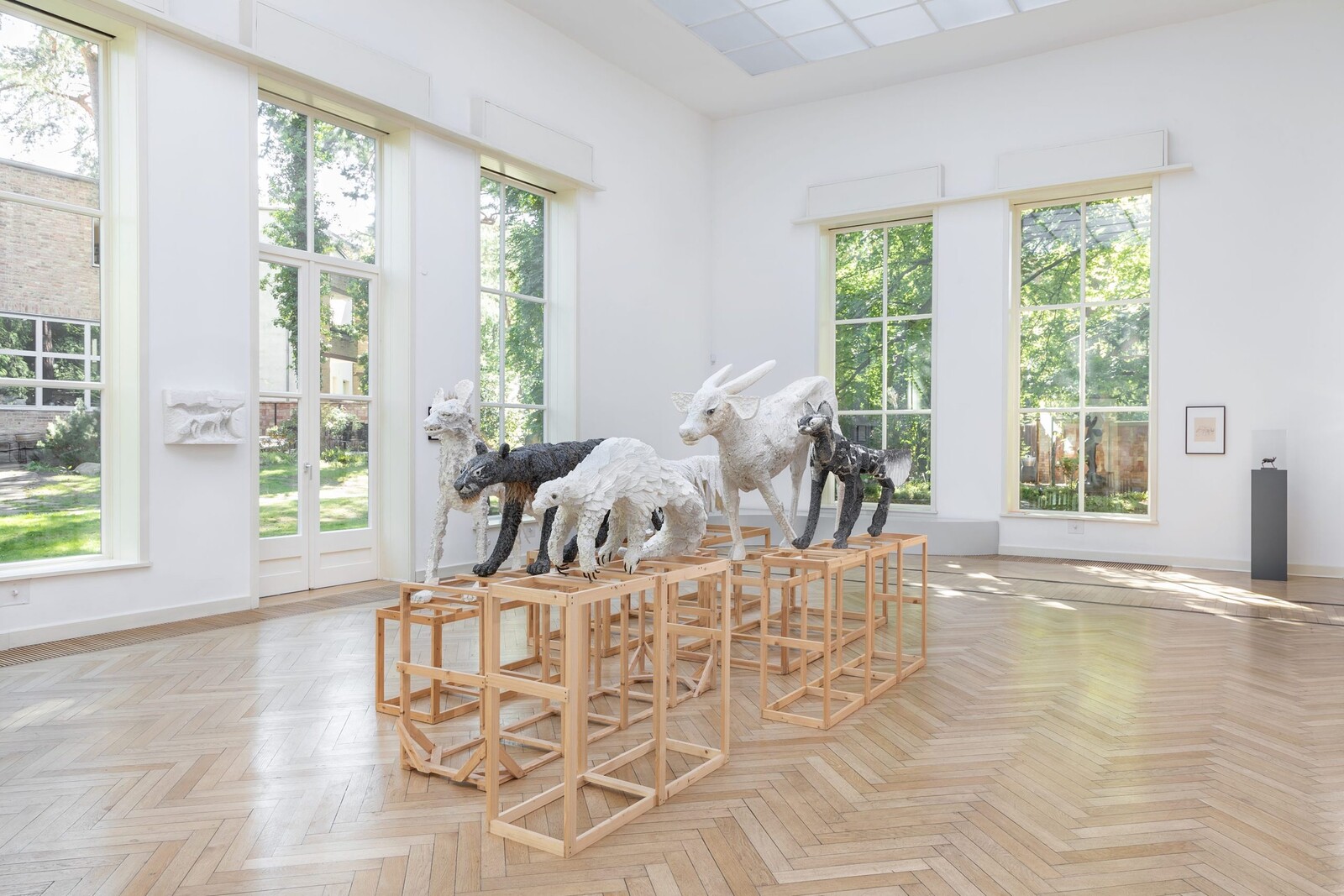
In What is Philosophy? (1991), Deleuze and Guattari write that “art is continually haunted by the animal.” Looking back through millennia of artistic production, we see representations of our beastly counterparts everywhere: as companions, deities, workers, or raw material. Likewise, John Berger has argued that “the parallelism of their similar/dissimilar lives allowed animals to provoke some of the first questions and offer answers.” Yet a life in common, and the reciprocal gaze that humans and animals once shared, was lost in the West with the development of nineteenth-century capitalism. The practice of German-Iraqi artist Lin May Saeed brings the image of the animal from the periphery back to the center.
Saeed devoted her life, sadly cut short by brain cancer at the age of fifty last month, to the cause of animal liberation. Her work avoids agit-prop depictions of animal suffering and instead draws on myths, stories, and fables so that we might “imagine a kind of time travel with a focus on the human-animal relationship” and “think about our common future” by looking at the past. “The Snow Falls Slowly in Paradise,” in which Styrofoam sculptures and reliefs, figurative wall works, drawings, and videos are shown alongside animal sculptures …
October 11, 2023 – Review
Jota Mombaça’s “A CERTAIN DEATH/THE SWAMP”
Harry Burke
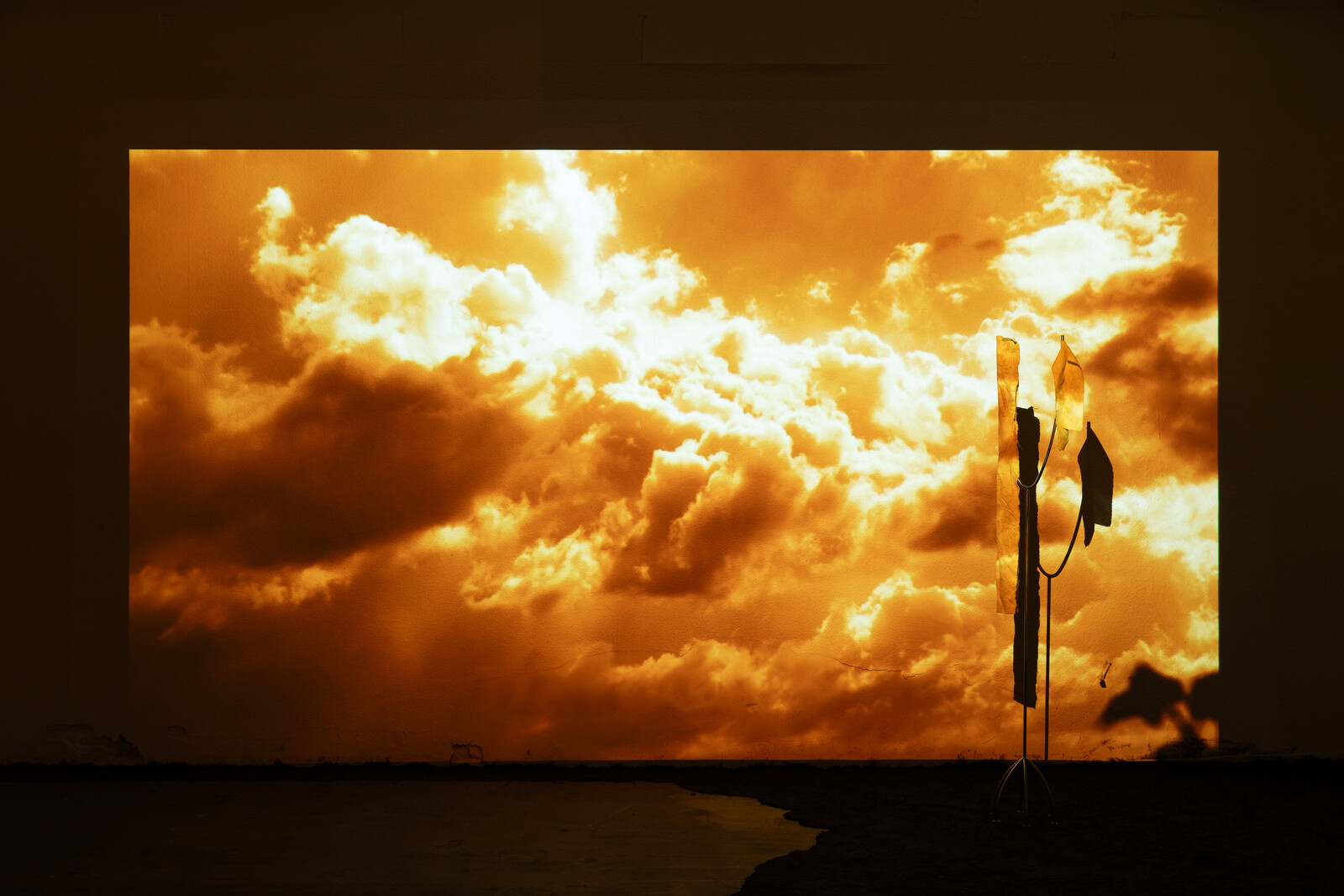
In the final chapter of her 2016 book In the Wake, Christina Sharpe meditates on the weather, which for her signifies the “pervasive climate” of antiblackness in the modern world. Her argument is shaped by the insight that “new modes of writing, new modes of making-sensible” are needed to account for the quotidian violence of the colonial present. Jota Mombaça’s “A CERTAIN DEATH/THE SWAMP” builds on these contentions through a series of artworks that address the weather and, when viewed together, make up an atmosphere.
While preparing for the show, Mombaça researched the disastrous flash floods that struck western Germany and neighboring countries in 2021, as well as Berlin’s origins as swampland, drained in the 1700s. What would it mean, the artist asked herself, for cities to turn back into swamps? until the last morning (2023), made in collaboration with Anti Ribeiro, Darwin Marinho, and Luana Peixe, is her oblique answer to this. The looping, fourteen-minute video studies the mangroves and marshlands of Pará in her native Brazil. Its long, pensive shots of clouds recall John Constable’s cloud studies of the 1820s. For the Romantic painter, clouds exteriorized emotions and symbolized modernity’s scientific advances. To today’s eye, they also refract …
July 19, 2023 – Review
Aziz Hazara’s “No Dress Code”
Edwin Nasr
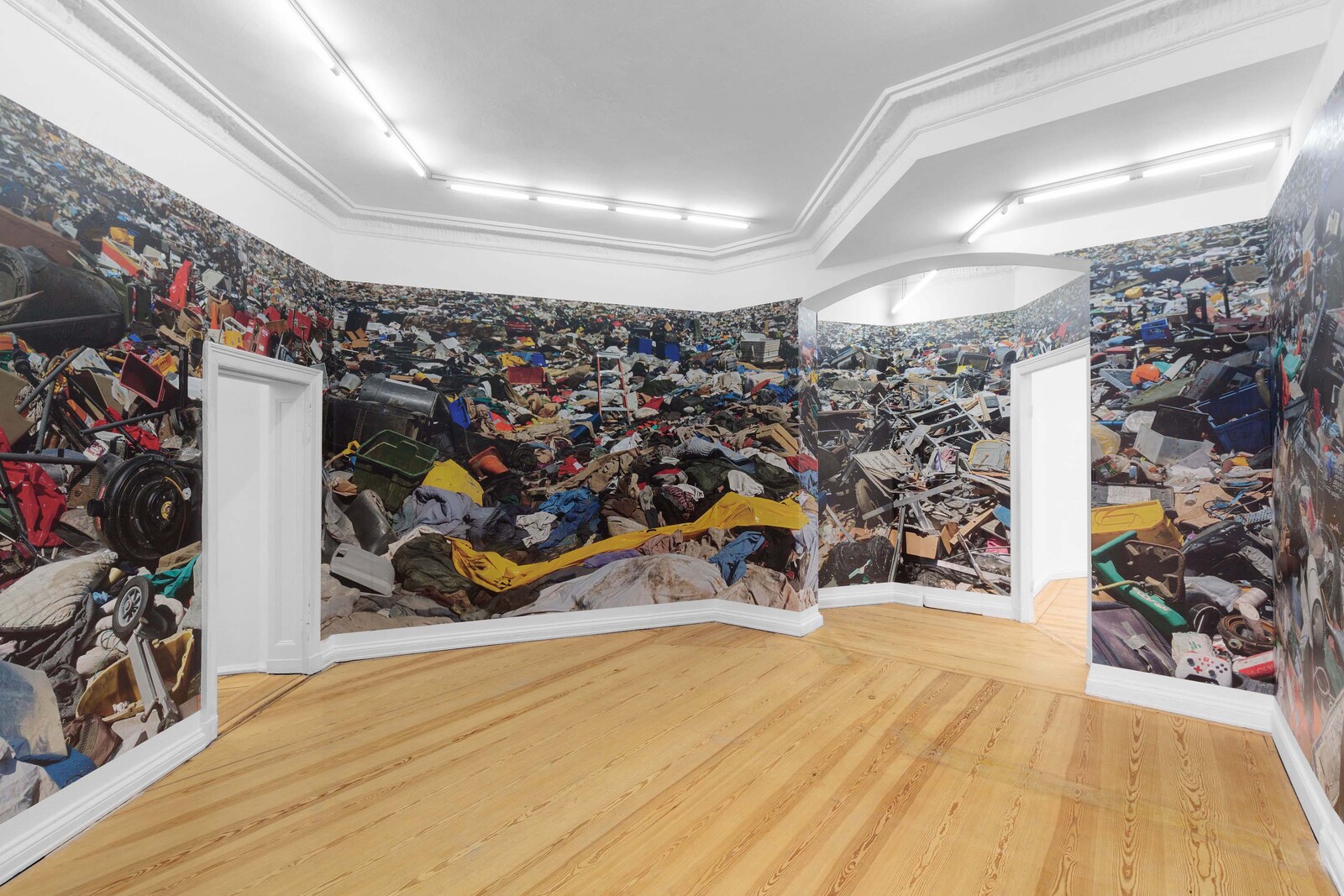
“How then can we clean centuries’ worth of waste?” asks Françoise Vergès, reflecting on the devastation wrought by imperial conquests in the Global South. The question hangs over “No Dress Code,” artist Aziz Hazara’s affronting solo exhibition at Berlin’s PSM Gallery, which reflects upon the US military occupation of his native Afghanistan through the prism of trash.
Speakers housed in four modified, bright yellow–plastic jerrycans play soundscapes recorded by the artist over the past decade across Kabul. The title of this sound installation, Bushka Bazi (2023), is the Afghani name for these containers; together with the soundscapes, they conjure a distinct sense of place, but also of context. Introduced to the country through international aid cargos, they have been put to numerous uses since—from water carriers in peri-urban areas suffering from poor infrastructure to petrol-filled explosive devices used by the Taliban.
I am looking for you like a drone, my love (2021–22) is a large-scale photograph of colossal heaps of discarded material, sweepingly installed in a panoramic layout so as to cover the walls of the gallery’s central space. At first glance indistinguishable from the type of imagery disseminated by climate advocates to draw attention to environmental degradation, the …
July 14, 2023 – Review
“O Quilombismo”
Jesi Khadivi
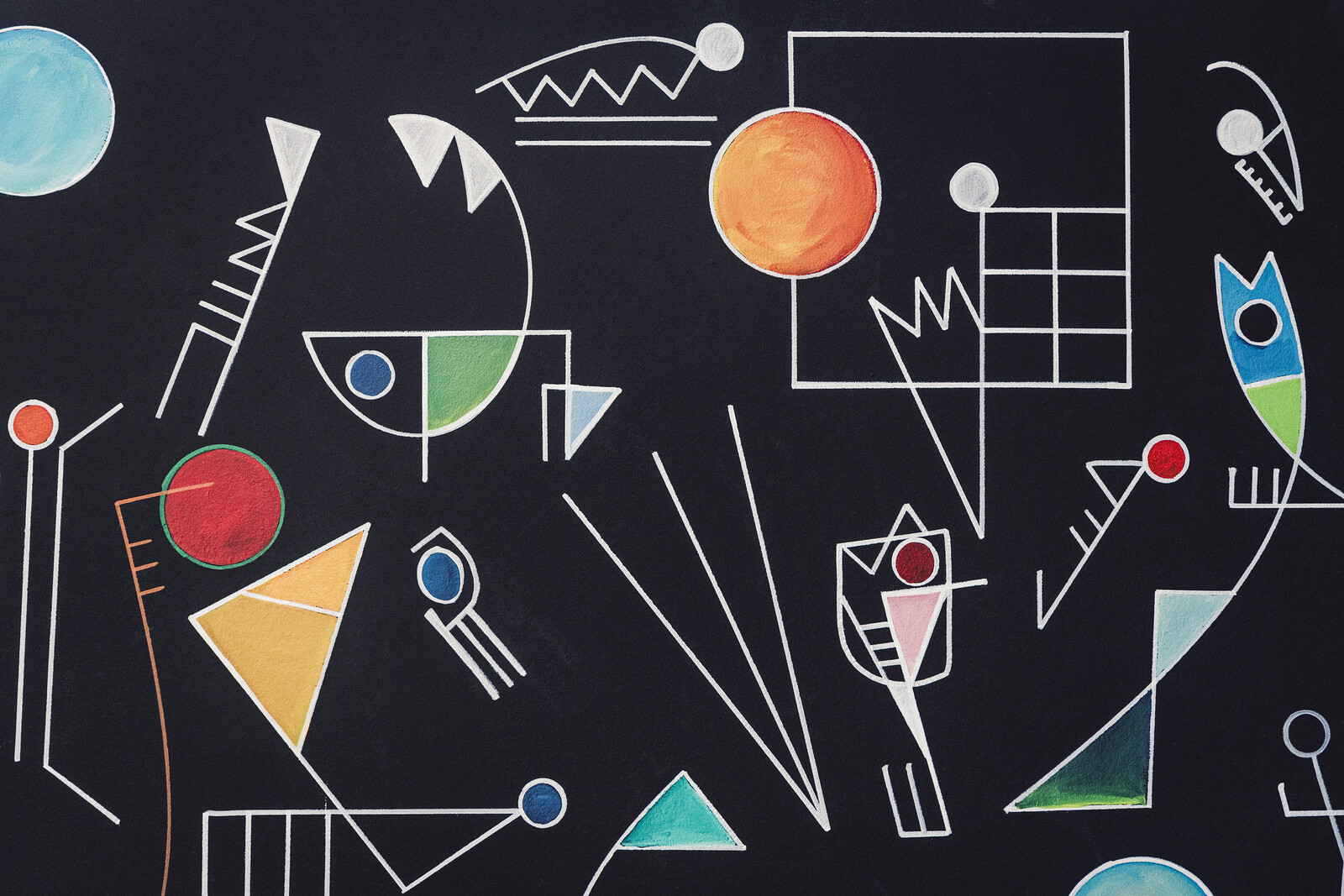
The reopening of Berlin’s Haus der Kulturen der Welt was marked by three days of performances, concerts, lectures, readings, rituals, and blessings under the banner “Acts of Opening Again: A Choreography of Conviviality.” Those familiar with incoming director Bonaventure Soh Bejeng Ndikung’s program at Savvy Contemporary, which he founded in 2009 and quickly established as a forum for deliberation, experimentation, and sociability, will recognize a continuation of its ethos of conviviality and hospitality as an integral aspect of institution-building. Yet how might such values transition to the larger scale of a bureaucratic German institution, which operates according to different metrics than more fluidly structured art spaces? How does a curatorial stance of cultivating intimate spaces within institutions ultimately expand the channels through which we can engage with art and with each other? How does an invisible curatorial material like intimacy manifest itself within an exhibition? And finally, how might such a politics of conviviality be enacted within what Ndikung has referred to as “the belly of the beast”? These questions pervaded my thinking about “O Quilombismo,” a show whose concept and content are entirely entangled with the act of thinking how to “institute.”
The inaugural exhibition in HKW’s new program …
June 27, 2023 – Review
María Magdalena Campos-Pons’s “Liminal Circularity”
Kimberly Bradley
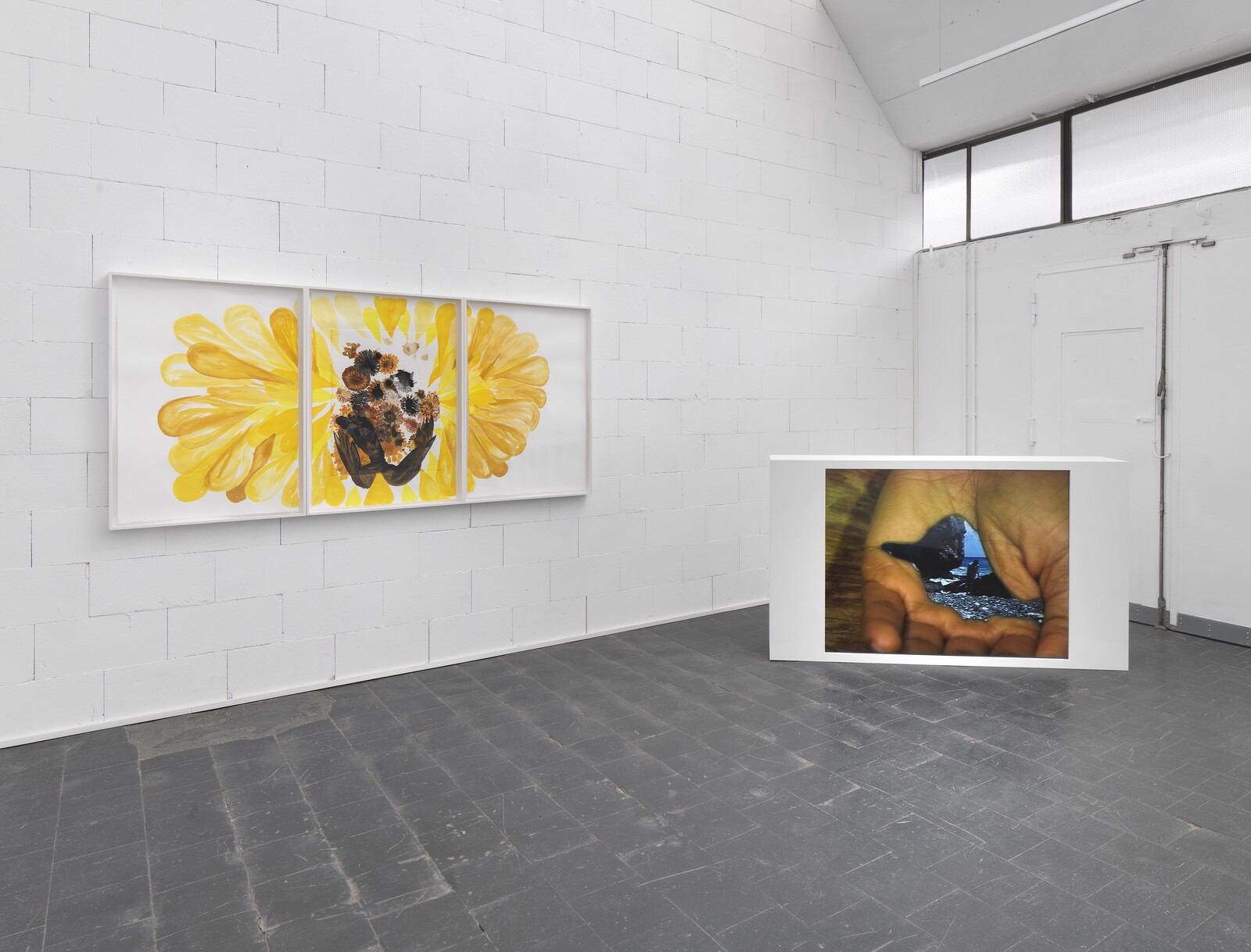
According to Yoruba myth, only one of the seventeen deities sent by the supreme being Olodumare to populate the earth could do so. After her sixteen male co-divinities failed, Oshun, the goddess of water, fertility, love, and protection, used her sweet waters to revive Earth and create its creatures. At Galerie Barbara Thumm, María Magdalena Campos-Pons pays homage to Oshun with the vibrant gouache triptych Untitled (2021). The artist was born in Cuba in 1959, the year the Cuban Revolution succeeded; Oshun is an important figure in Santeria practices, integrated into Latin American and Caribbean belief systems via the slave trade. Here, a female figure’s outstretched arms cradle a burst of dark-brown blooms, framed by yellow petals—a stylized sunflower spilling over three framed pieces. The sunflower is a symbol of Oshun, and the piece, an invocation of sorts, exudes generosity, abundance, and hope.
Campos-Pons—whose ancestry is Yoruba and Chinese as well as Cuban—is experiencing her own burst of recognition. She’s been known, shown, and studied since the 1980s, but institutional exhibitions in both the Global North and Global South have since 2020 arrived in a rush like the flowing waters she often depicts in her multimedia work. While this reflects …
May 19, 2023 – Review
“Retrotopia: Design for Socialist Spaces”
Sierra Komar
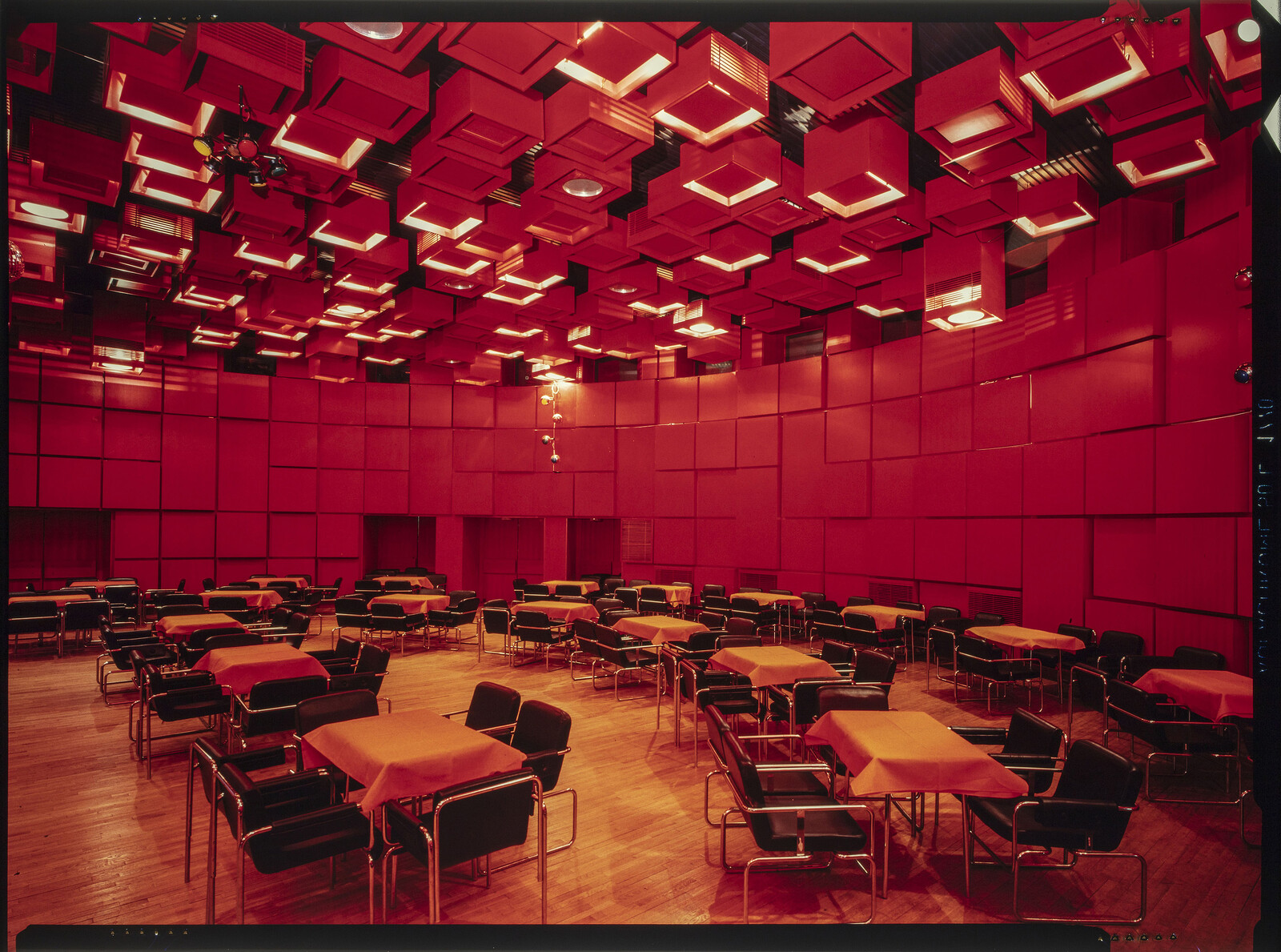
To turn left upon entering the darkened exhibition hall of “Retrotopia: Design for Socialist Spaces” is to encounter a motley, utterly heterogeneous collection of objects ranging from the decorative to the domestic to the medical. Nestled against one wall is Cosmic Fantasy (1965): an experimental public sculpture work by Lithuanian artist Algimantas Stoškus consisting of luminescent slabs of stained glass arranged, Tetris-like, on a series of suspended geometrical forms. Adjacent to this is a mint condition Saturnas vacuum cleaner—the ultimate kitschy fusion of lofty, celestial aspirations and household banality—complete with orbiting moon wheels and ring. In a vitrine just opposite the Saturnas is the least recognizable item of the group: a tubular, vaguely biomorphic form that appears to be woven out of some sort of textile. This, it turns out, is one of the first vascular prostheses ever made: a specific model of artificial aorta manufactured in 1960s Lithuania using re-engineered German ribbon-weaving machines. Selected by Lithuanian curator Karolina Jakaitė, this eclectic assemblage of objects and artworks (along with contributions from other Lithuanian creators like sculptor Teodoras Kazimieras Valaitis and architect Vytautas Edmundas Čekanauskas) is one of eleven unique “capsules” that comprise the collaboratively curated “Retrotopia.” In its simultaneous diversity …
April 5, 2023 – Review
73rd Berlin International Film Festival, “Forum Expanded”
Asia Bazdyrieva
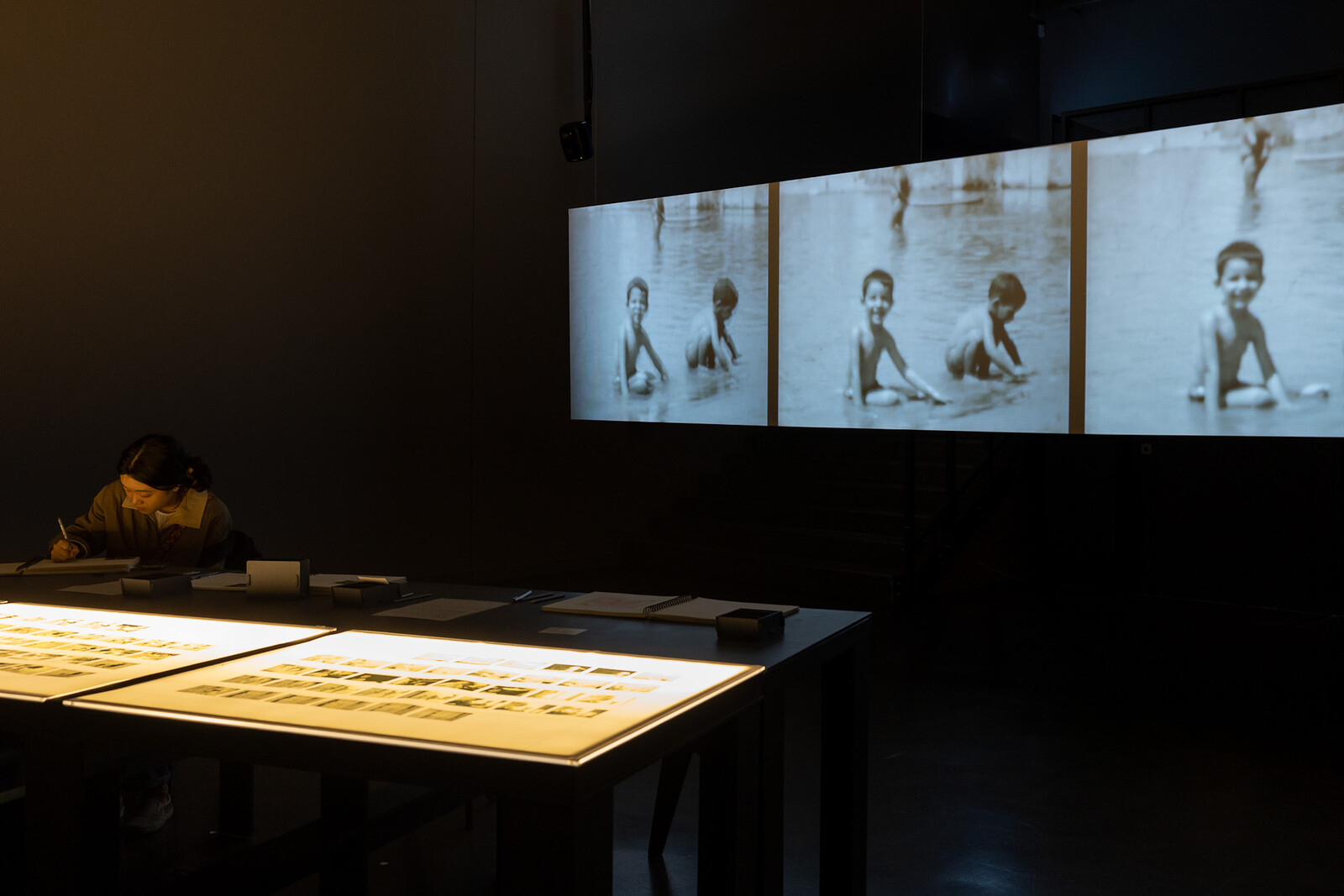
The “Forum Expanded” section of the Berlinale, an assemblage of exhibitions distributed across three venues and any number of screens, charts the points at which cinema meets the visual arts. This year’s edition, titled “An Atypical Orbit,” aimed to set in motion “fluctuating proximities—political and personal legacies which often lie in shambles” and to “challenge the status quo through exhibiting works that redefine cinema.” In attempting to solve two problems—to host a platform for political articulation, and to critically engage with moving images and media as such—the Forum Expanded faced a conundrum: its archival and historiographic approach, as well as the aesthetic and political emphases in the overall selection of works and conversations, induced a certain lethargy: a sense of being unwilling or unable to respond to those current emergencies which do not yet have established narratives.
In Betonhalle’s entrance corridor, Tenzin Phuntsog’s Dreams (2022) set up the exhibition’s dream-like ambience. The work portrays a sleeping couple— immigrants from Tibet to the US—floating in space against a quiet, blueish monochrome background. The pair reappear in a two-channel video, Pala Amala (2022), posing silently in nondescript settings. These large-screen, meditative works sat in contrast to the small, phone-like screens which …
March 22, 2023 – Review
Martin Wong’s “Malicious Mischief”
Mitch Speed
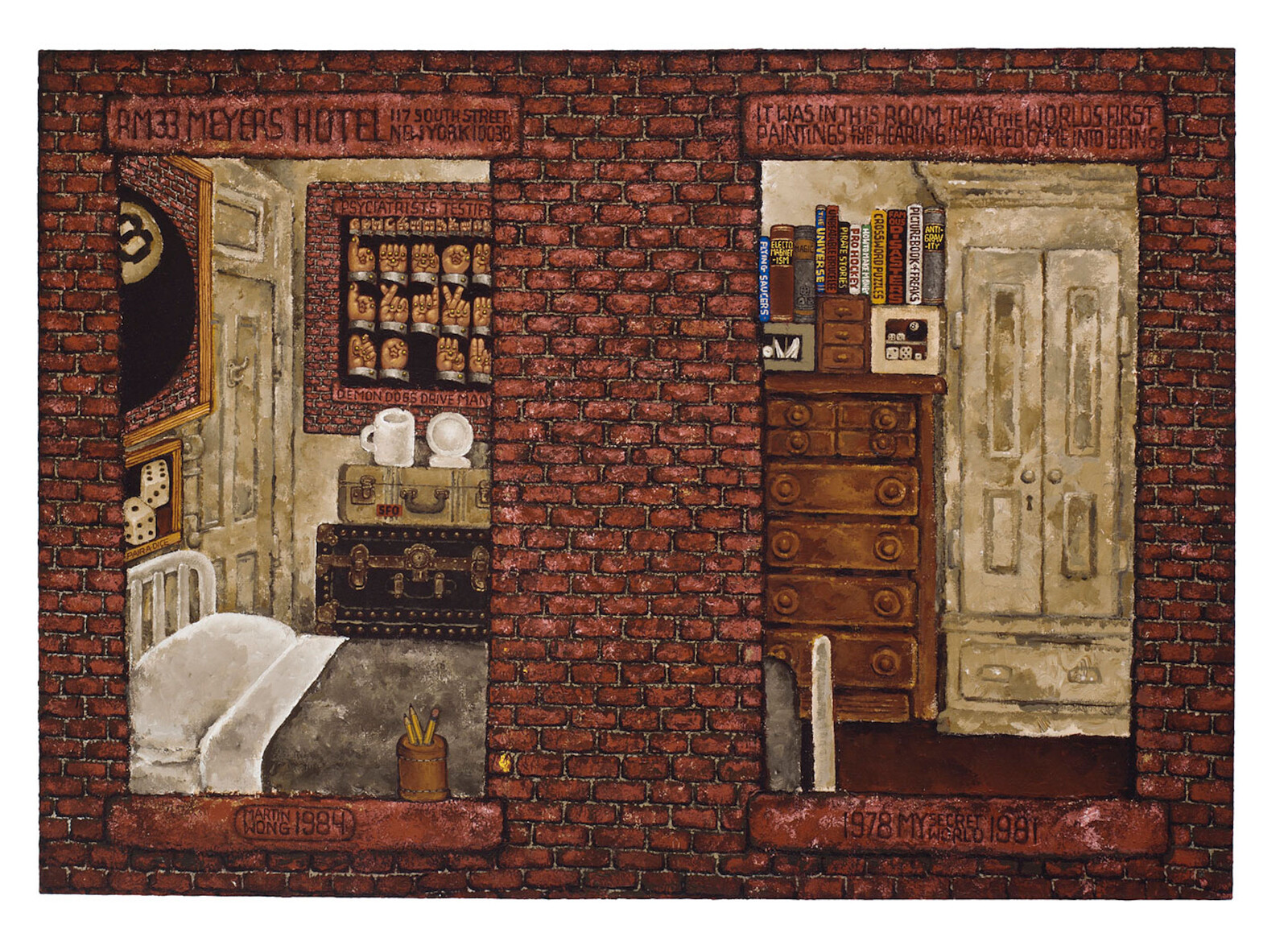
In a 1988 catalog essay, the poet and critic John Yau sketched out the social dimension of Martin Wong’s painting and sculpture. A self-styled “representative of an economically oppressed urban class consisting largely of Blacks, Hispanics and Asians,” the American artist had been snubbed by curators and critics. A quarter-century after Wong’s death, this injustice has been corrected, and this Berlin retrospective of his antic, steamy, humane, and superlatively accessible take on Chinatown San Francisco and New York, from the 1970s to the ’90s, has been lauded. But there’s an anxiety buried in this enthusiasm. In depicting a disappeared America, Wong’s retrospective holds a mirror to the lost world which surrounds KW itself.
“Even now,” Wong wrote in a hand-calligraphed 1986 press release, “it’s like the moment in these paintings never existed.” His home cities—his subject—were being gentrified to oblivion. In 1984, New York Magazine wrote of Wong’s downtown Manhattan: “nowhere have the tensions and dramas of [gentrification] been more starkly displayed.” Set aside the differences between the cities and eras, and the same has recently been true of Mitte, the Berlin district in which KW is situated.
Nocturne at Ridge Street and Stanton (1987) shows an unpeopled but warm …
October 14, 2022 – Review
“Queering the Crip, Cripping the Queer”
Anne Finger
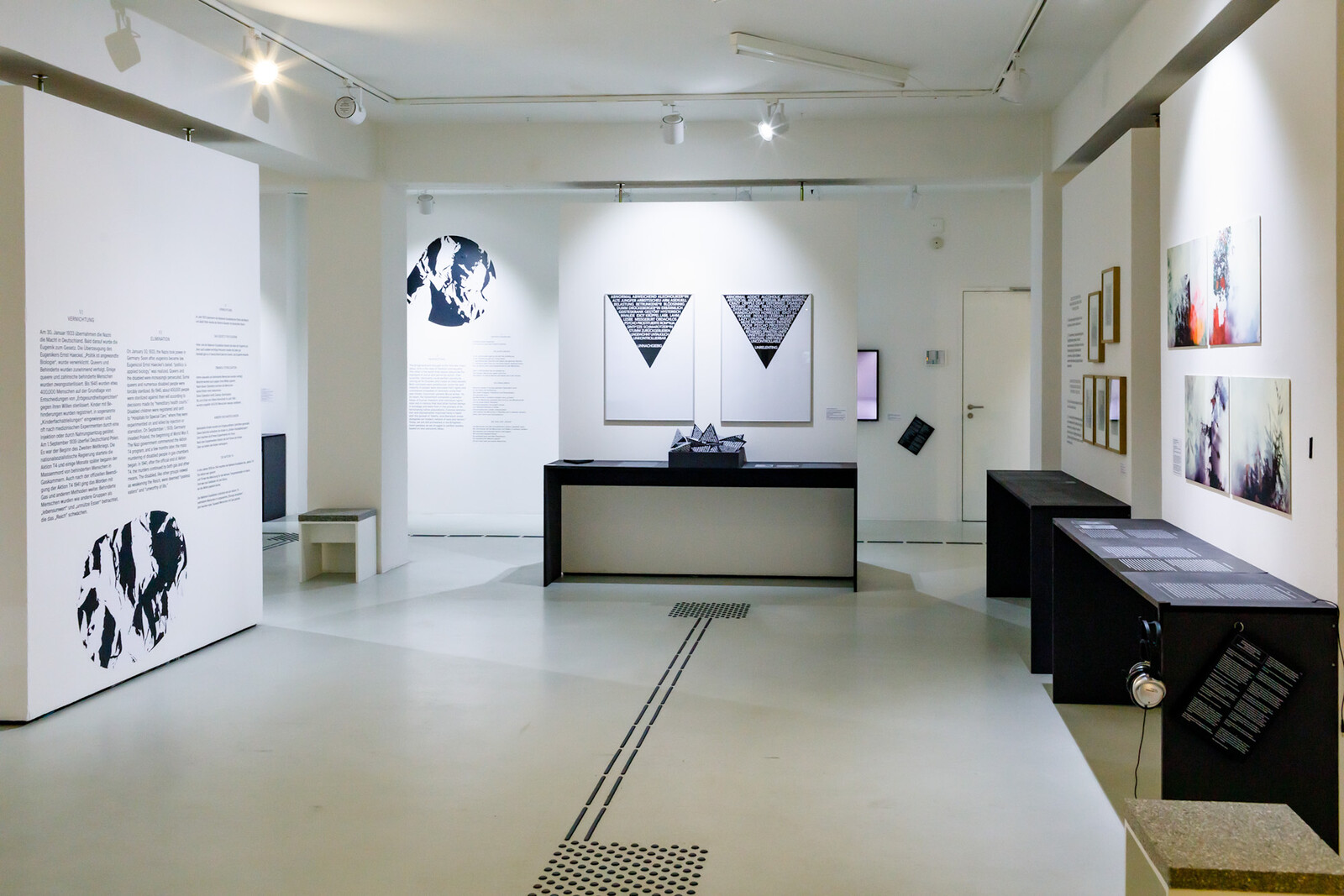
In 2015, the disabled American writer Kenny Fries gave a reading as part of the program for “Homosexuality_ies,” an exhibition jointly sponsored by the Deutsches Historisches Museum and the Schwules Museum. During it, he posed a question: Where, he asked, was disability in this wide-ranging exhibit? Why had access for disabled people been ignored? The response to that challenge is “Queering the Crip, Cripping the Queer” at the Schwules Museum. Co-curated by Fries, Birgit Bosold, and Kate Brehme, it is one of the first international exhibitions to explore the artistic, political, and historical links between queerness and disability. It presents disability as sexy, provocative, tough, and a source of artistic strength—not a black hole of suffering and blankness.
Access is at the heart of the show. Seated in my wheelchair, I could actually experience the art. Nearly always when I enter a museum (sometimes after having been assured that a show is “completely accessible”) I am able to see only a fraction of what is on display, and I am left wondering: “What does that wall text, too high for me to read, say?” I might be able see diaries, letters, magazines in a display case, but the height …
June 15, 2022 – Review
12th Berlin Biennale, “Still Present!”
Jesi Khadivi
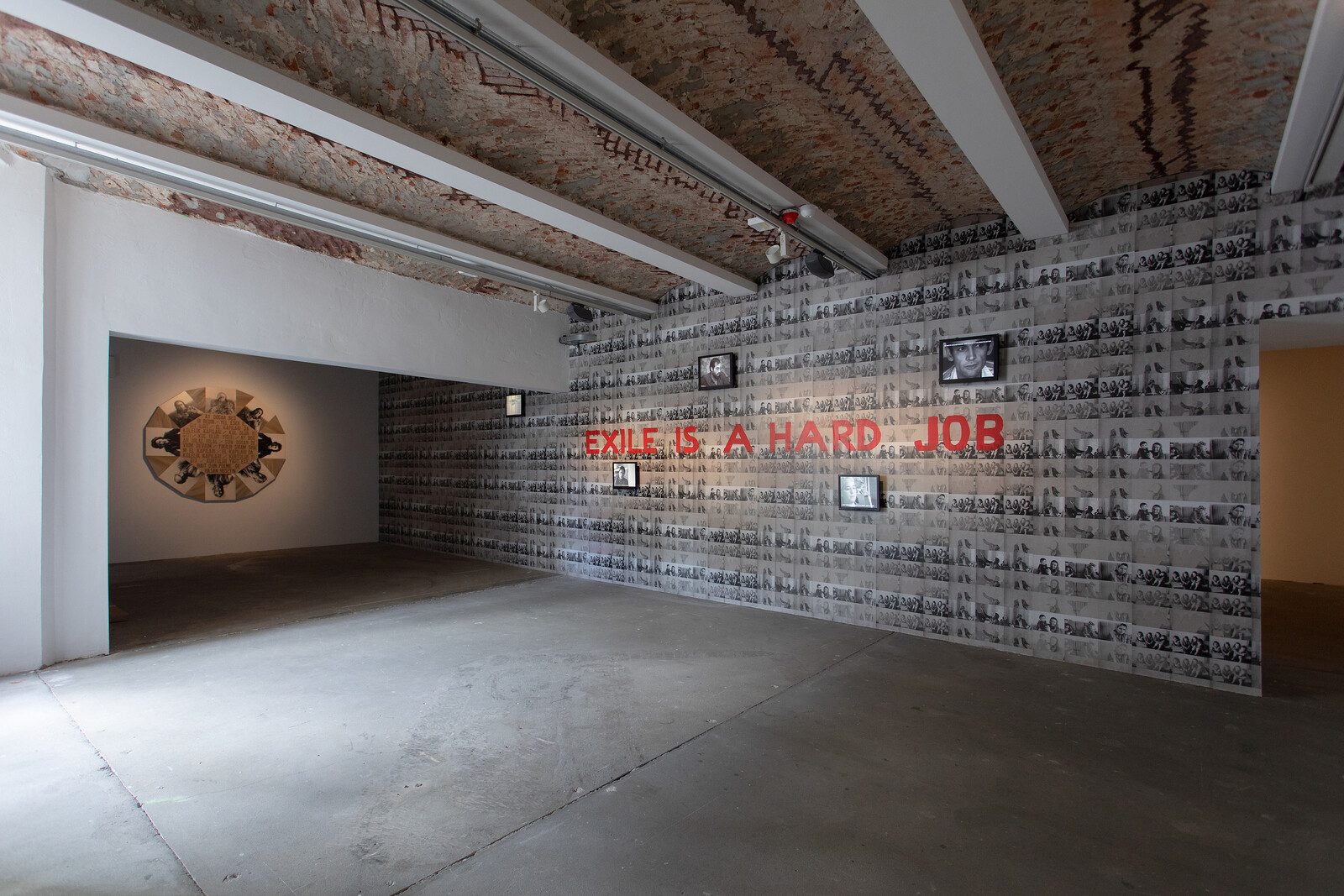
As curator of the twelfth edition of the Berlin Biennale, Kader Attia continues his ongoing engagement with notions of injury and repair. There is precedent for this in his own artistic practice: the sprawling installation The Repair from Occident to Extra-Occidental Cultures (2012) staged reconstructed artifacts from ethnological collections that clearly reveal their stitching and staples, drawing a contrast with Western approaches to restoration that conceal an object’s damage and thereby silence the many stories it might tell. In the series “Repaired Broken Mirror” (2013–21), Attia sutured nondescript fractured mirrors with crude materials like staples or copper wire, a gesture of repair which appeared no less brutal than the act of breaking. The visible scars and reflective surface feel emblematic of this exhibition’s aspirations to hold a mirror to the legacies of colonialism and imperialism, sweeping environmental destruction, racism, sexism, and forced displacement due to war and climate change—and to propose ways forward.
Through works by 82 artists and collectives displayed across six venues, Attia endeavors to foster spaces of “collective speech and reflection” that respond to the accumulated, unhealed wounds that have been rendered invisible by discourses of expansionism, algorithmic governance, and 24/7 capitalism. Working against the universalist claims of …
April 19, 2022 – Review
Rabih Mroué’s “Under the Carpet”
Jayne Wilkinson

“One of the main weapons is the image itself.” So proclaims Rabih Mroué in his 2018 lecture-performance Sand in the Eyes. With trademark brevity, his statement articulates the complex recurring strategies—analyzing images as weapons, conflating theatricality with war, reading revolutions through pixels—that underlie Mroué’s multidisciplinary projects as a visual artist, actor, playwright, and director. This mid-career survey, surprisingly also his first solo exhibition in Berlin, brings together two decades of work and, incredibly, eight new commissions produced largely during the pandemic.
In design and execution, its ambitions are staggering. A non-linear constellation of video projections, installations, collages, and archival material are structured around a two-story vertical video that can be seen from all corners of the exhibition’s two floors. With so many video and audio works, the sound bleeds (a plinky xylophone suggestive of a film score’s anxious denouement, punctuations of gunfire and explosions that arrive unexpectedly, the noisy insistence of a film projector) effectively recall the sonic chaos of war while still creating an integrated audio environment.
The imposing central work, Images Mon Amour (2021), loops through imagery culled from Lebanese newspapers, with the benday dots of analog print enlarged and visible. Weaponry, …
April 15, 2022 – Review
Zoe Leonard’s “A View from the Levee”
Jesi Khadivi
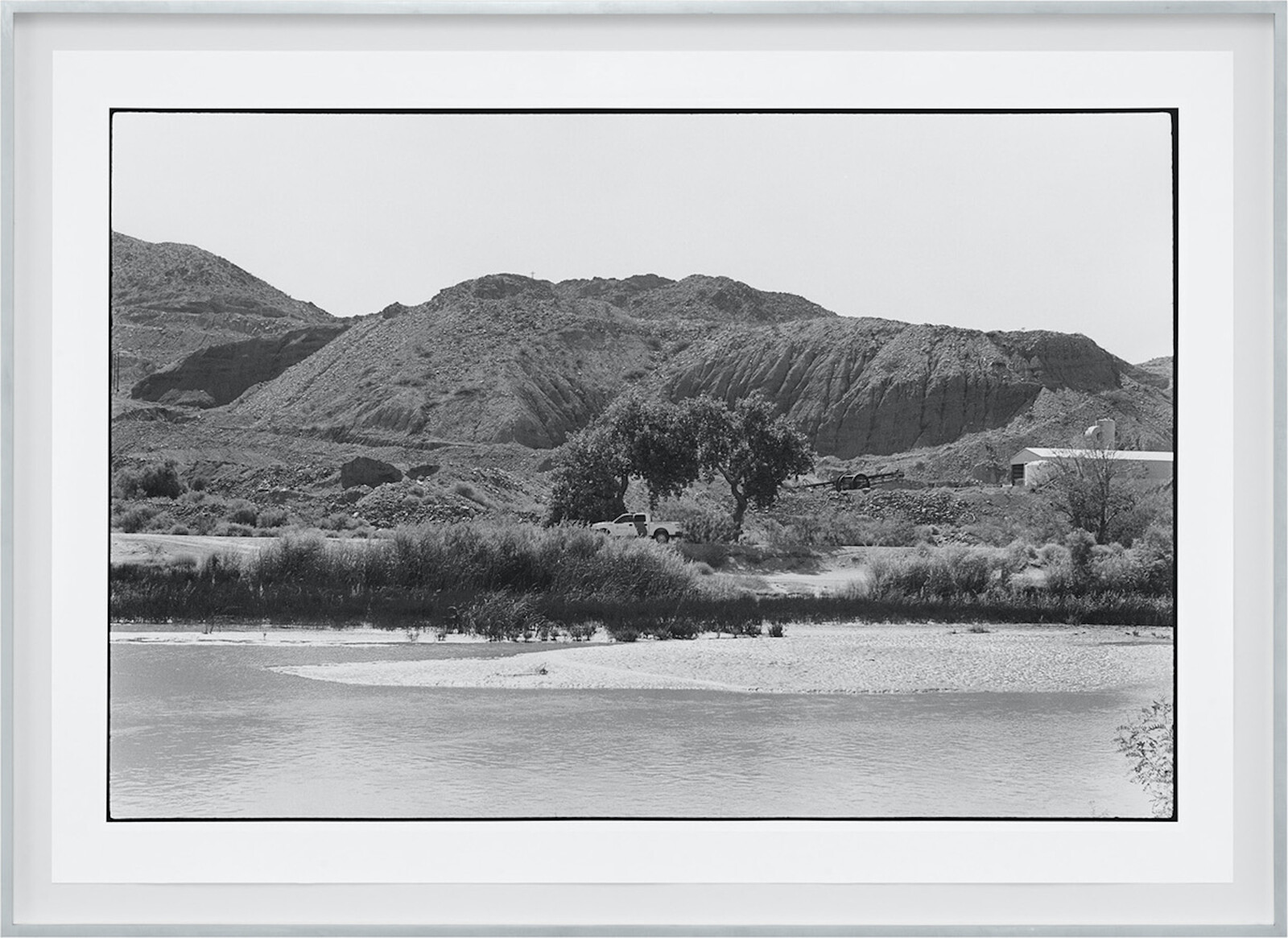
Art historian Darby English describes humans’ relationship to the natural world as “an interchange of flow and force,” a phrase that also evokes the way geological forces are harnessed to mark political boundaries. Zoe Leonard’s epic photographic work Al río / To the River, created between 2016 and 2022, comprises approximately 500 black-and-white and 50 color photographs of the river that marks the border between the United States of America and Estados Unidos Mexicanos. Called the Rio Grande by Americans and the Rio Bravo by Mexicans, the numerous violent modifications the river has undergone testify to this entanglement of flow and force: over the last century engineers have forcibly straightened and shortened its meandering natural course by nearly 67 miles, lining its base in concrete so that it may never shift its channel again. The river’s edge is alternately home to cities, towns, border patrols and facilities, grazing animals, and open expanses. In some places it flows wide and mighty, while in others no water runs through, and its cement embankments form what scholar C. J. Alvarez describes as “a massive trapezoidal canvas for graffiti.”
Before Leonard zooms out to capture this interchange, she zooms in. Upon entering “A View …
October 8, 2021 – Review
“The Cool and the Cold”
Ryan Ruby
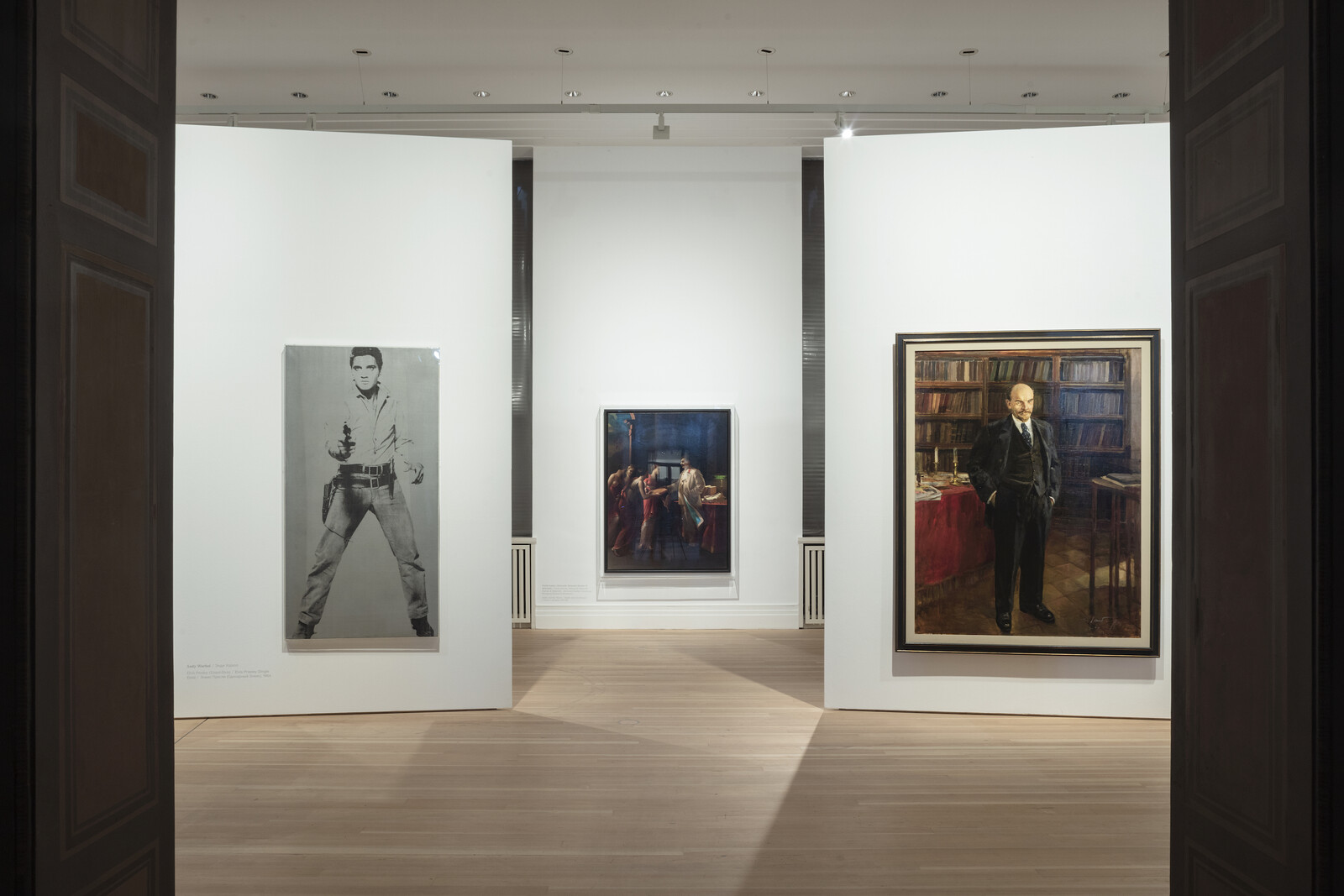
I am standing in front of two full-length portraits, each just over 200 centimeters tall. The one on the left is a gray-scale screen print; in it, a man in a billowy shirt with a popped collar, jeans, and cowboy boots has emerged from the void to draw a revolver from the holster at his hip, which he points at the viewer. The one on the right is painted in thick, dark oils; it shows a man in a black three-piece suit and polka dot tie, his hands in his trouser pockets, standing in his study, before wall-to-wall, floor-to-ceiling bookshelves and a desk covered in a red, tasseled table cloth, on which the viewer can make out two candlesticks and a set of miscellaneous papers. The subject of the first painting is Elvis Presley. The subject of the second: Vladimir Lenin.
These two portraits—Andy Warhol’s Elvis Presley (Single Elvis) (1964) and Dmitriy Nalbandyan’s Lenin (1980–82) respectively—flank the entrance of “The Cool and the Cold: Painting in the USA and the USSR 1960-1990,” a selection of over 125 pieces from the collection of the late chocolate manufacturer and art historian Peter Ludwig and his wife Irene, now on view at the Gropius …
April 27, 2021 – Review
“A Fire in My Belly”
Alan Murrin
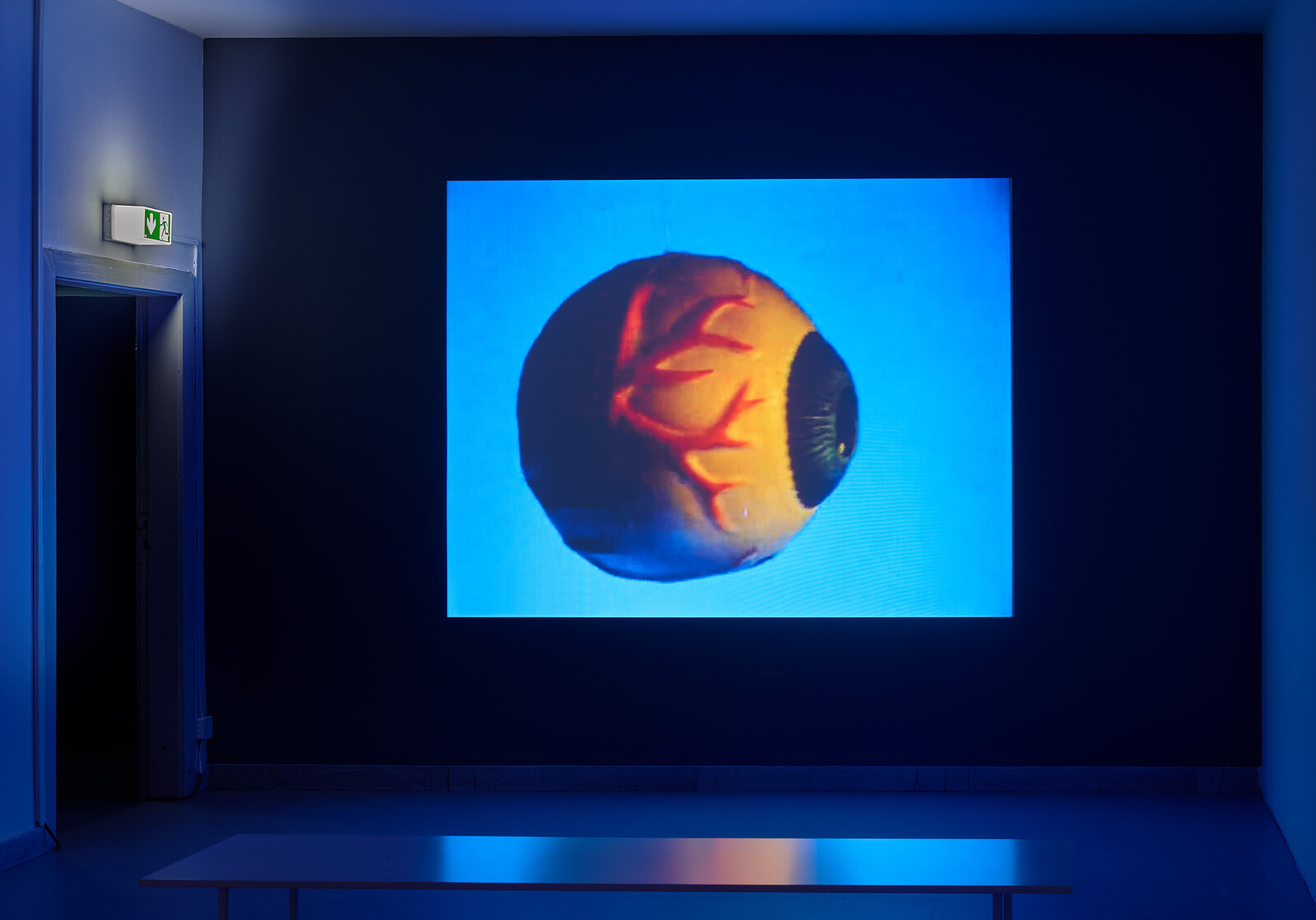
This show of 47 works by 36 artists—41 drawn from Julia Stoschek’s collection, augmented by six loans—explores the effects of violence, physical and psychological, on the body and the body politic. The earliest work on display is Karl Wilhelm Diefenbach’s Capri (1911), an oil painting showing a sunset burning out over a darkening coastline; the most recent is Anne Imhof’s Untitled (Wave) (2021), a thirty-minute video wherein a lone figure stands on a shoreline, beating back the oncoming tide with a whip. The show is filled with careful pairings, its emotional register ranging from despair to hope, from the abject to the sublime. It takes its title from David Wojnarowicz’s 1986–87 montage of spinning eyeballs and sewn flesh, mummified corpses and ants crawling over a figurine of the crucified Jesus; on the opposite wall hangs Zoe Leonard’s Untitled Aerial (1998/2008), a photograph of a vast landscape with a river wending through it like a strip of silver ribbon. The two sit in silent communion, the naked landscape a counterbalance to the corporeal concerns of Wojnarowicz’s work. As is so often the case with this show, the wound inflicted by one piece is salved by the next.
On entering the space, …
September 29, 2020 – Review
“Studio Berlin”
Alan Murrin
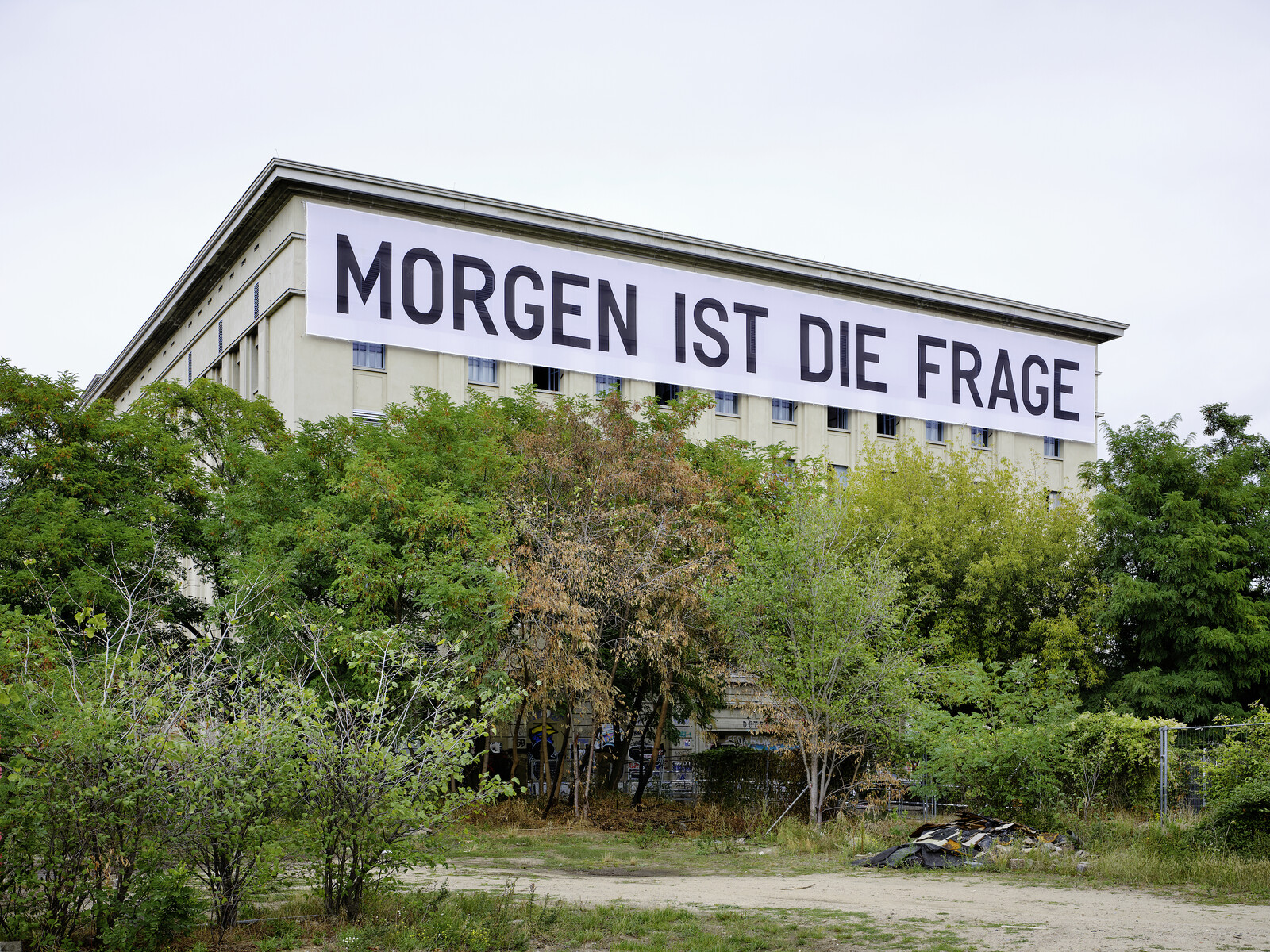
“Morgen ist die Frage”—tomorrow is the question—reads the banner by Rirkrit Tiravanija which swathes the top floor of Berghain’s façade. The statement seems antithetical to the philosophy of the most famous techno club in the world. Before lockdown began and ravers were forced to find their fun at illegal parties in the parks of Berlin and the forests of Brandenburg, Berghain was where you went to forget about tomorrow. If you could brave the lengthy queue and possible rejection by the club’s notoriously mercurial door staff, days of hedonism lay ahead. But for now, the 3,500-square-metre venue, first a power plant and then a nightclub, has become an exhibition space.
When Covid-19 forced clubs and galleries to close in March, Berghain’s owners approached Karen and Christian Boros about mounting an exhibition to provide a platform for artists who live and work in the city. Funded by a 250,000 euro grant from the Berlin Senate, the show does not feature work from the Boros Collection—housed in a World War Two bunker in central Berlin that was itself once a techno club that hosted fetish parties—but they and Juliet Kothe, director of the Boros Foundation, are listed as co-organizers. As an overarching …
September 14, 2020 – Review
11th Berlin Biennale, “The Crack Begins Within”
Jörg Heiser
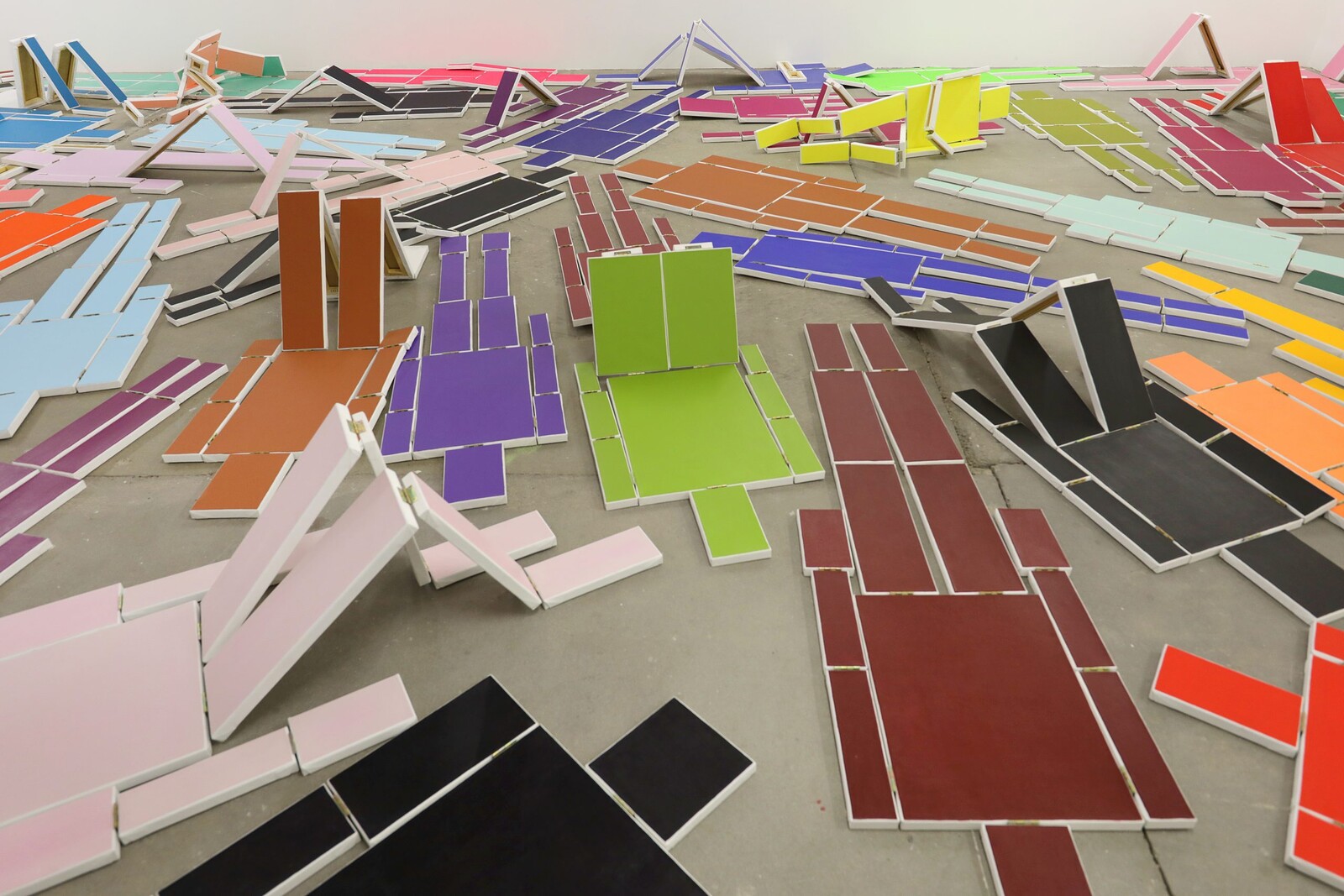
“Here, the concept of ownership is abstracted until it disappears.” This is the official slogan of ExRotaprint: a former print-press factory collectively run as a mix of art studios, workshops, and community initiatives in Wedding, north Berlin, and one of four venues for the 11th Berlin Biennale. For about a year leading up to the exhibition’s opening, the curatorial team—María Berríos, Renata Cervetto, Lisette Lagnado, and Agustín Pérez Rubio—hosted a series of readings, screenings, workshops, and performances here which set the tone. Though interrupted in March by the pandemic that prompted the show’s postponement from June to September, the approach could be summarized as: “Here, the concept of curatorial heroics is abstracted until it disappears.”
Which is to say: this Biennale foregrounds work that addresses socio-political traumas past and present, and the effects of violence inflicted on the marginalized. (This is also how I understand the title “The Crack Begins Within,” borrowed from a line by poet Iman Mersal.) Despite curatorial texts that occasionally wax a little too poetic, the team circumvents the usual pitfalls of self-congratulatory gesturing and puffed-up wokeness that reduce artists and their works to issue-tokens or neo-ethnographic trophies. The works at ExRotaprint point towards the basso …
June 16, 2020 – Review
Erica Baum’s “A Method of a Cloak”
Martin Herbert
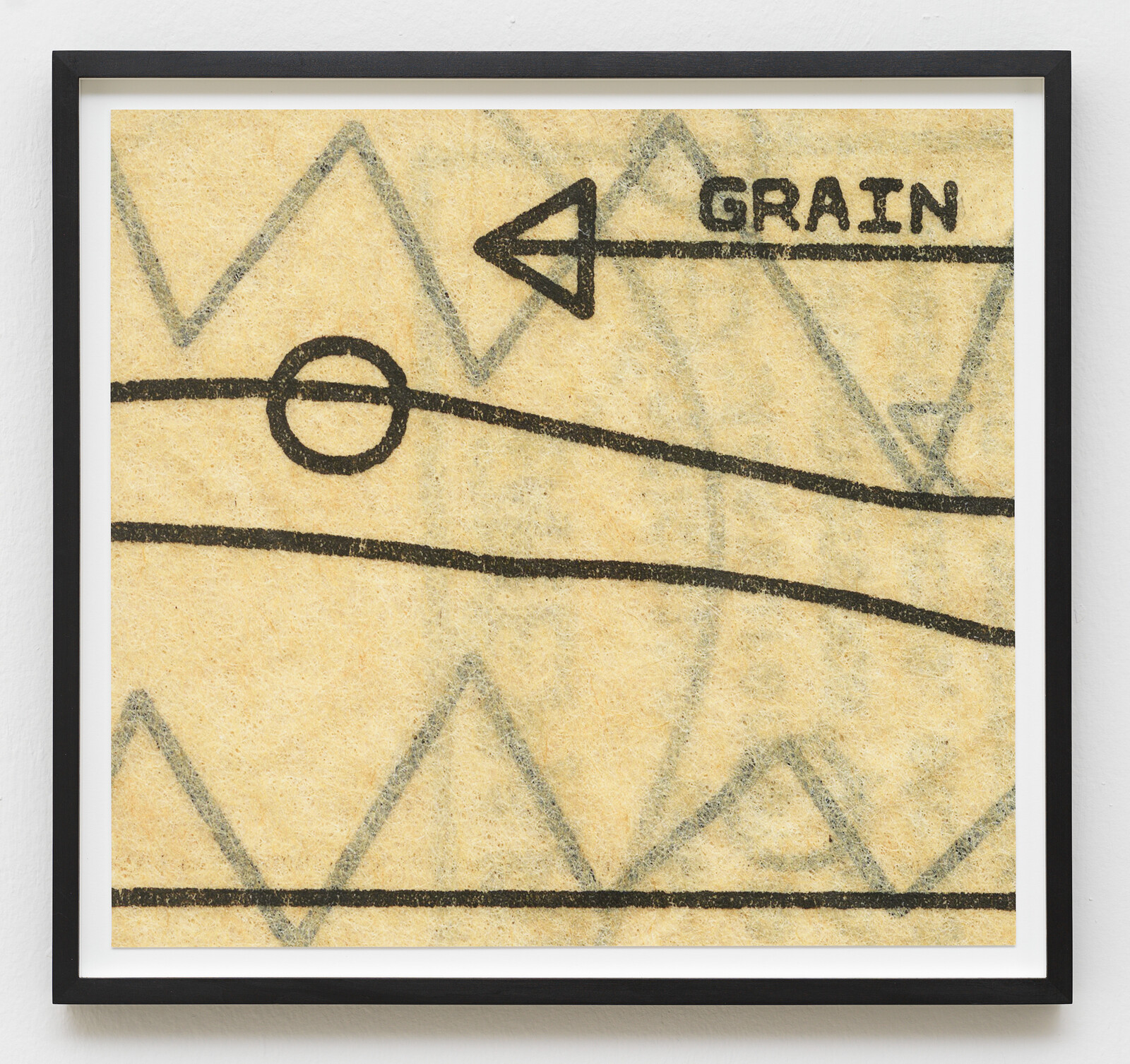
Since the mid-1990s, Erica Baum has been coaxing a fragmented poetry from the unlikeliest places, quarantining found snippets of text that never aspired to great significance and dilating both their scale and their associative potential. Early on, the New York-based artist moved her camera close to half-erased classroom chalkboards (“Blackboards,” 1994–96), releasing details of equations, diagrams, and language from the burden of signifying and making them simultaneously abstract and allusive (e.g. the slyly reflexive smidgen of chalked text “TO DEPTH”). Since then, Baum has focused primarily on worldly printed matter; in “The Naked Eye” (2008—ongoing) she took stipple-edged trade paperbacks from the sixties and seventies and photographed them side on, scraps of illustration and text peeking chancily through tightly formalized verticals. For all her scrambling, though, the conceptual dynamic feels legible. A second-wave wrangler of Pictures Generation insights, Baum aims to illuminate a covert, sometimes incriminating largesse in the discarded and to purposefully collapse together not only high and low, as we once called them, but visual and verbal, banal diagram and highfalutin abstraction, the Apollonian and the edgeless.
So she has a furrow and she’s ploughing it diligently, or, to extend the spatial metaphor, Baum …
March 22, 2020 – Review
Leila Hekmat’s “CROCOPAZZO!”
Alan Murrin
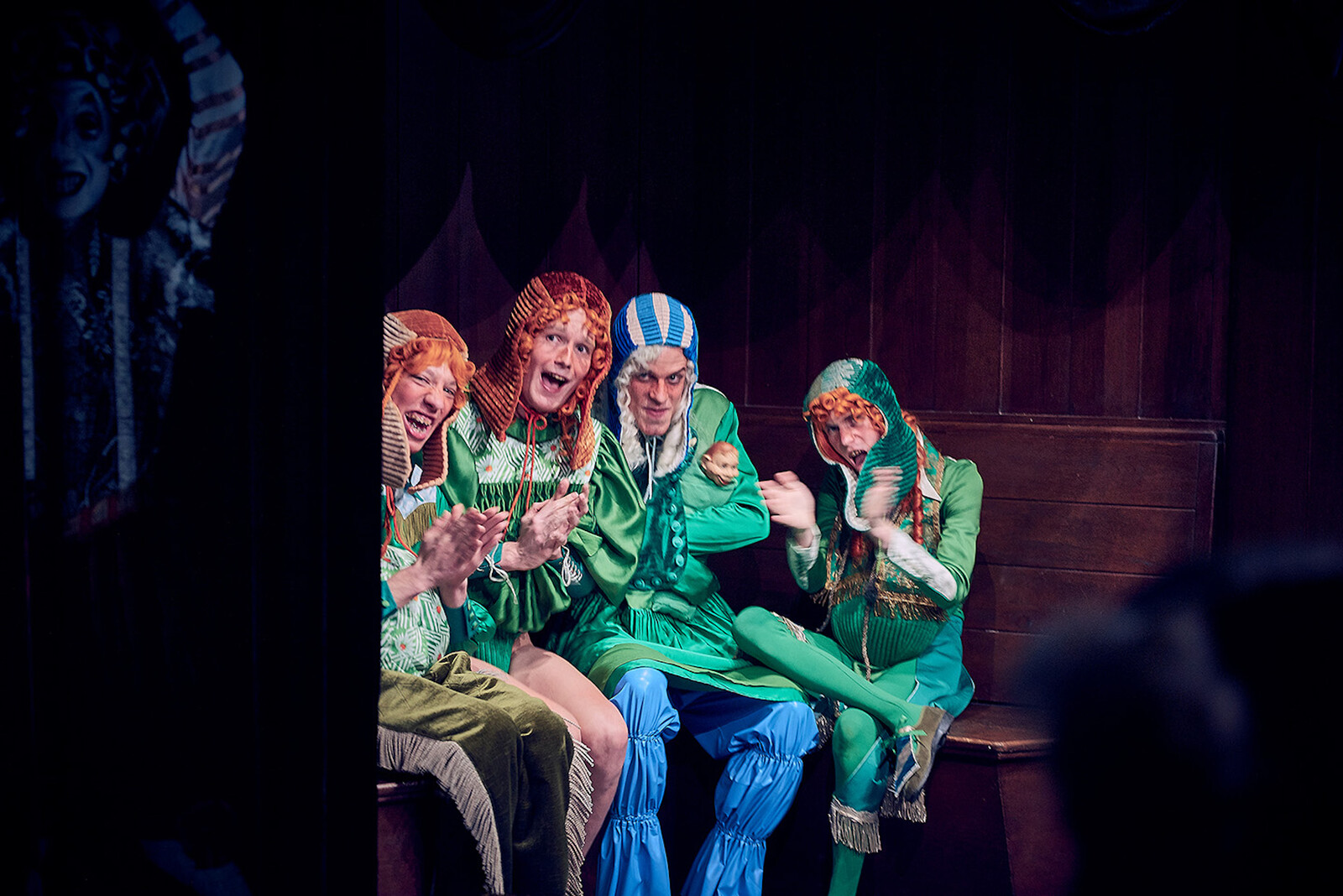
Individualistic societies are driven by the belief that happiness is to be found by accessing our “best” and most “authentic” selves, and that this can be achieved by spending money. Therapeutic practices ranging from the seemingly benign to the dangerously experimental enforce the psychological norms that uphold that system. But what happens if we relinquish control of our drives and desires, rather than trying to make them cohere? And what happens if that process is presented as entertainment? Leila Hekmat’s carnivalesque exhibition—prematurely closed as people are forced into their houses by Covid-19—conducts a dangerous experiment of its own: can a family induce psychosis in one member by forcing that individual to bear the weight of their collective dysfunction?
Hekmat writes, directs, and creates costumes for highly aestheticized experimental theatre pieces performed in intimate spaces. Her previous exhibition, “I Was Not Invited” (2018, co-presented by Bortolozzi and Duddell’s Hong Kong), took inspiration from Franz Schubert’s Winterreisse (1828), the poetry of Stéphane Mallarmé, and Roland Barthes’s A Lover’s Discourse (1977), and—like this show—found humor in suffering. “CROCOPAZZO!” is split across three rooms, the first filled with eight mannequins posed as if interrupted mid-dialogue. One figure raises its palms in an attitude of …
March 17, 2020 – Review
70th Berlin International Film Festival, “Forum Expanded”
Leo Goldsmith
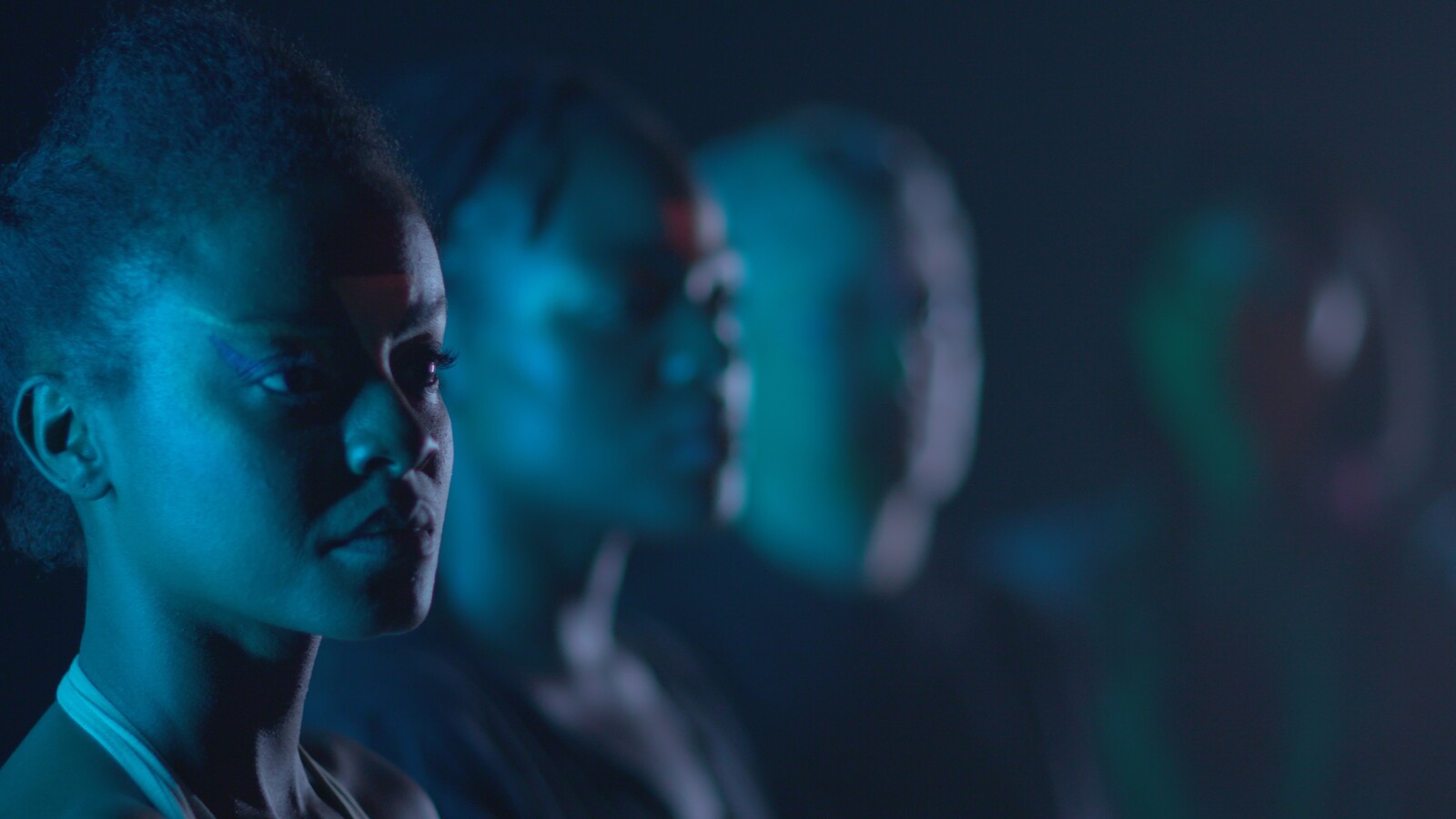
Finding space for exhibitions within the sprawling architecture of a major film festival is a tricky affair. Berlinale’s packed schedule and multiple sidebars do not easily accommodate excursions to far-flung locations to see an assemblage of works of different lengths and modes of reception. Trickier still is the act of importing into a film festival context those discourses that are currently trending in the art world—at least in any way that doesn’t seem like a cynical bid for political relevancy. This year’s edition visibly wrestled with these problems, hosting three exhibitions that struggled to find coherence within the format of the larger festival—or to break free of it.
For the last 15 editions, Berlinale has housed exhibition work under the aegis of Forum Expanded—itself a subsection of the International Forum for New Cinema, which has been organized by Arsenal–Institute for Film and Video Art since 1971. Taking as its remit “experimental film and video art for both cinema and exhibition contexts,” Forum Expanded presents a dozen or so theatrically presented film programs, panels, and exhibition works, which offers a certain contrast with the gala premieres and red-carpet photo-ops elsewhere in the festival.
This year’s edition of Forum Expanded featured three …
June 14, 2019 – Review
Sol Calero’s “Archivos Olvidados”
Sofia Lemos
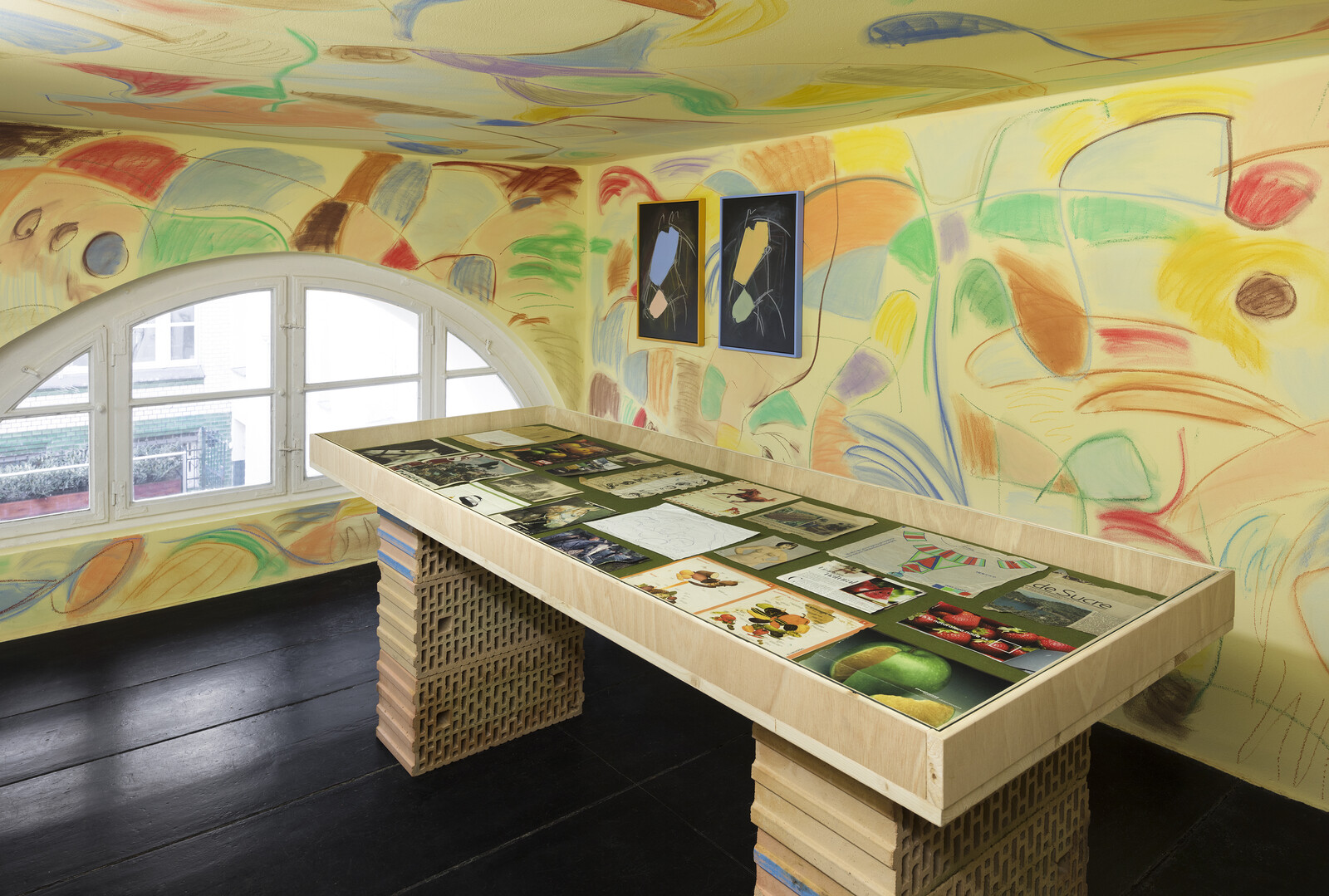
For her first exhibition at Berlin gallery ChertLüdde, Sol Calero transformed the typical German altbau into a luminous and colorful family home inspired by the artist’s grandmother’s farmhouse in Los Llanos, Venezuela, a grassland plain south of Caracas, where Calero and her cousins spent the summer months.
In Jesús Martín-Barbero’s seminal study of the role of media in the formation of national cultures in Latin America, social memory emerges as vivid mise-en-scène where popular iconography and labor struggles are ambiguously combined, creating a new social sensibility predicated on access to forms of expression. Experiencing and expressing the world becomes a matter of public fiction, wherein moments of systemic muting and glossing over the collective archive grow deeply entwined with class imaginaries. In this recurring scenario, oral histories, with their warranted omissions and excesses, reclaim an important effort in tracing personal and social routes. For Calero, the turn from personal archive to social space lays the foundation for “Archivos Olvidados” [Forgotten Archives], a thoughtful tribute to the fluidity of memory, childhood anxieties, and the artist’s late grandmother, the painter Luisa Hernandez, lovingly referred to as “Abuli.”
As a widow, Hernandez raised six children, studied fine art in Caracas, and returned to Los Llanos …
February 26, 2019 – Review
Daniel Pflumm
Kirsty Bell
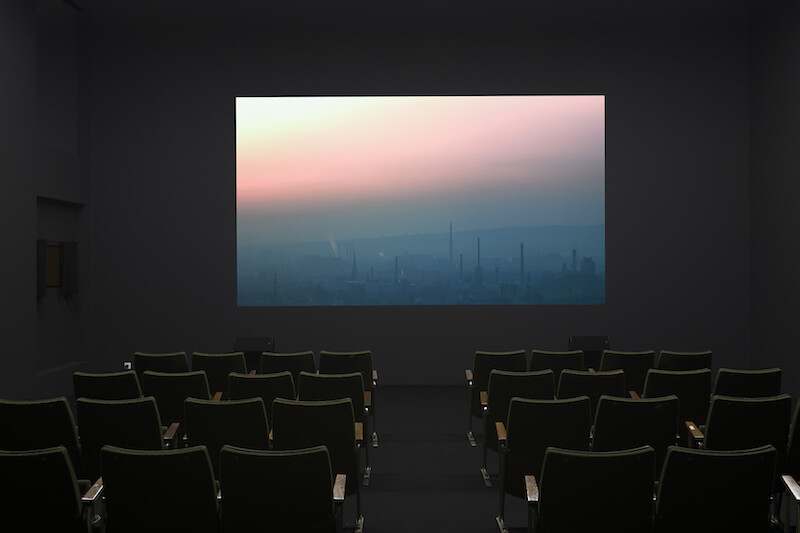
A cloud of stale smoke still hangs in the air the day after the opening of Daniel Pflumm’s exhibition at Galerie Neu, a throwback to another time—15 years ago, perhaps, when Pflumm had his last show at his hometown gallery and smoking indoors was still the norm. This new exhibition not only recalls the 1990s techno scene from which Pflumm’s work emerged, but also an ambivalence toward the art-world context in which it came to find itself. The commercial gallery trappings have been removed: reception desk and gallery assistant replaced by a shiny metal clothes rack with a sign, red on white, reading “SPECIAL” and two mirrors framed on the wall. Inside, the gallery has been transformed into an intimate cinematheque, with GDR-era folding chairs and portable metal ashtrays. Two dark windows offering clandestine views back into the reception reveal those mirrors to be two-way glass. Pflumm’s two new video works have all the harsh relentlessness of his early ones: as sharply edited as they are critical.
While in Pflumm’s previous videos, content was usually derived from, and shown on, a TV screen, the main work here, Hallo TV – FFM (2019), is a luxuriously large projection in the cinema/gallery that …
February 4, 2019 – Review
Raphaela Vogel’s "Son of a Witch"
Aoife Rosenmeyer
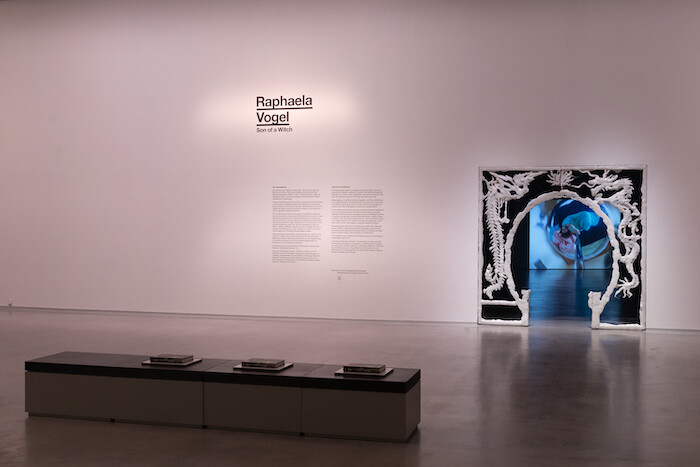
Raphaela Vogel turns her chaotic, insistent, and reflexive gaze on religion in her video installation “Son of a Witch,” presented at the Berlinische Galerie as part of the 10th anniversary celebration of the Videoart at Midnight Festival. After walking through a portal delicately molded from white plastic and featuring dragons and a phoenix, viewers enter a dark gallery spanned by two huge metal frames used in agricultural tunnels. These nested structures resemble a complex ribcage, yet the space has the feel of a church. Viewers are drawn to Sequenz (2018), a video projected on a large screen at the far end, where the church’s apse would be. Spinning, round motifs fill the screen: for much of the video, the artist films herself lying in a circular bed, staring into the camera. Both watching and watched, she lures the camera closer before presenting her sweatpants-clad bottom and slapping it with her hands. On the soundtrack, a classical motif is picked out slowly on a keyboard. There is a choral piece by Benjamin Britten, a brief blast of Low Deep T singing “Please don’t / stay with me / go home”—then the screen goes blank.
The architecture and symbols of most places of …
January 31, 2019 – Review
“The New Alphabet — Opening Days”
Nick Currie
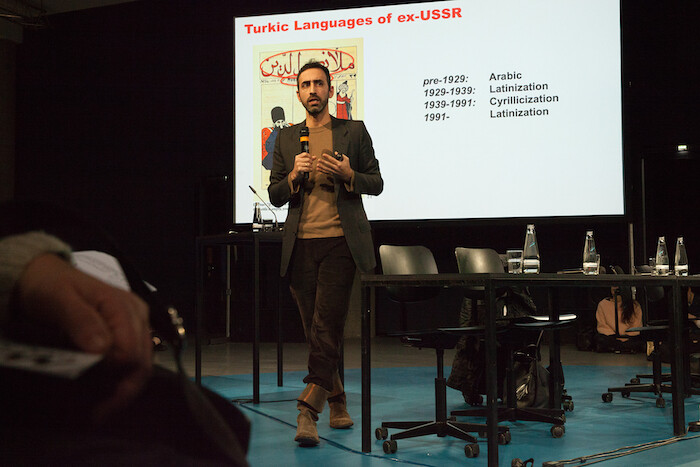
A city with an institution like the Haus der Kulturen der Welt (HKW)—Berlin’s House of World Cultures, a cantilevered cockle shell sitting on the Spree River beside the chancellery buildings that fund it—is a happy city indeed, for it can boast a progressive intellectual hub, a cultural engine spitting with vigor and restless curiosity. HKW is a bulwark against commercial logic, the surging tides of populism, and the threat of Western “endarkenment.” Massive subsidy is required, of course. Offered here by the Kulturstiftung des Bundes, the German state culture fund, that subsidy is neutral enough to allow the institution’s directors to strike the right balance between affirmation and contestation, observation and critique.
Events like “The New Alphabet — Opening Days,” a four-day launch for a program of events that will run for the next two years, exploring cultural, political, and critical approaches to alphabets and code, do not play to empty rooms. Berlin supplies an audience of culturally active people filled with enthusiasm for questions that might strike the citizens of more pragmatic, phlegmatic towns as heavy and pretentious. The blurb for “The New Alphabet” begins with three such questions: “Is it possible to imagine an overabundance of multifarious fields of …
July 5, 2018 – Review
Louise Bourgeois’s "The Empty House"
Kimberly Bradley
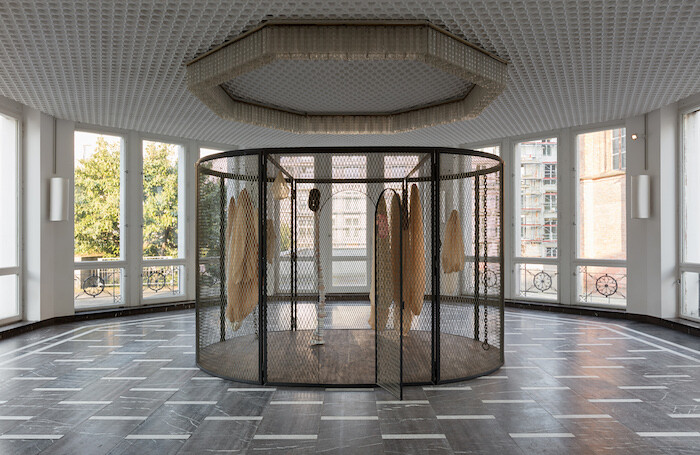
It’s intimidating to review the work of an artist the stature of Louise Bourgeois, about whom so much has been written, to whom so much has been ascribed. Bourgeois’s life spanned nearly the entire twentieth century and helped redefine what a (feminist) artistic practice can be, how art can intertwine with life. Her legacy is outsized, but Berlin’s Schinkel Pavillon—a nonprofit art space in a GDR-era structure, run since 2007 by artist Nina Pohl—has put together a portrait of Bourgeois’s late work that is accessible and intimate.
The pavilion’s main space, an octagonal room with floor-to-ceiling windows, hosts a single work: one of the “cells” that Bourgeois began making in the early 1990s. Peaux de Lapins, Chiffons Ferrailles a Vendre [Rabbit skins, Scrap Rags for Sale] (2006) is an oval metal cage in the room’s center containing other sculptures: two humanoid figures, hand-sewn in dark fabric, hang upside-down like voodoo dolls from an apparatus attached to the cell’s ceiling. Also suspended are textile sacks, mostly in shades of beige and cream (one is hot pink), arranged in flock-like groups. A thin stack of white marble stones ascends from the cell’s wood floor—atop this elegantly curved “spine” hangs an old-fashioned fur headband. …
June 11, 2018 – Review
10th Berlin Biennale, “We Don’t Need Another Hero”
Patrick J. Reed
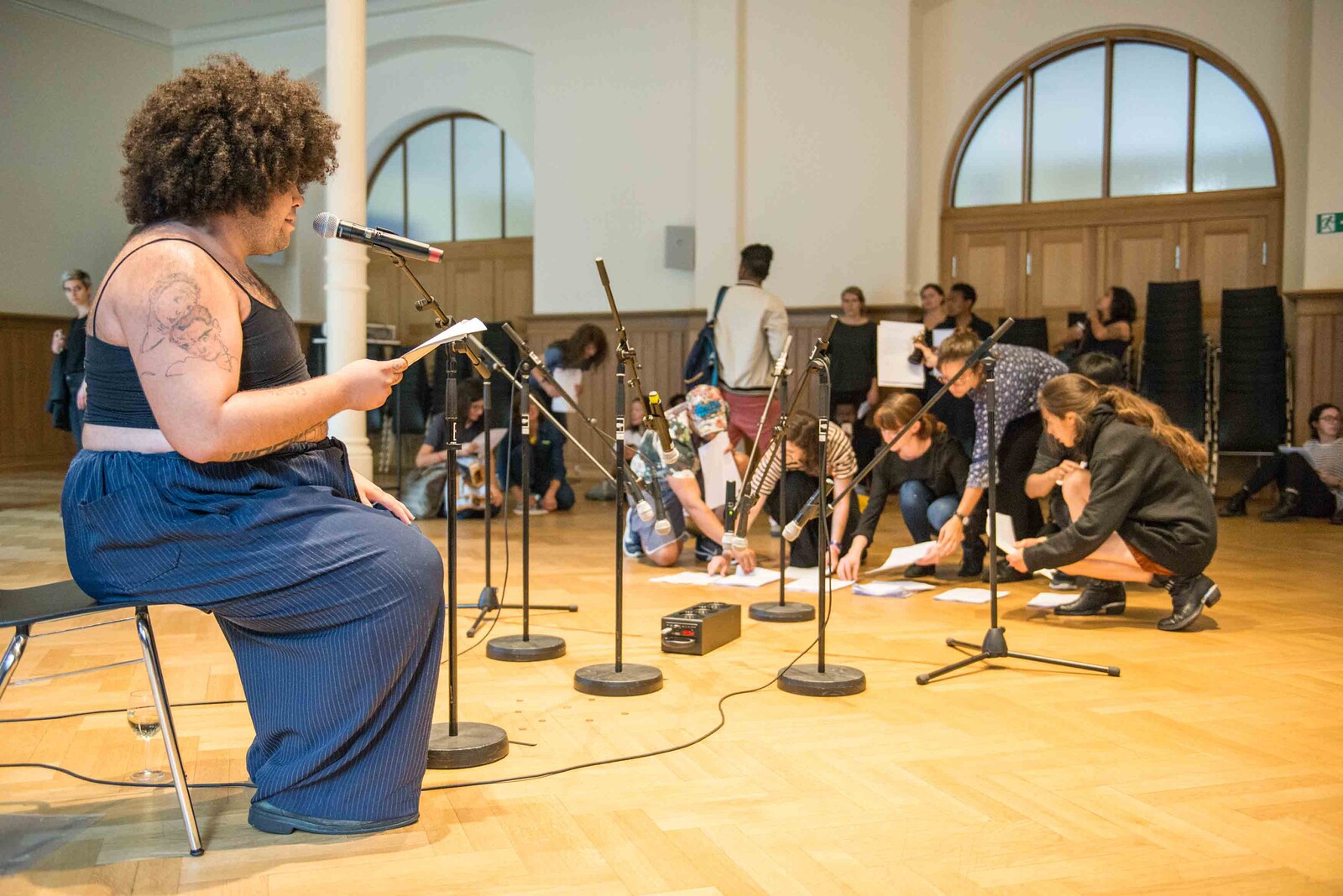
During the press conference for the 10th Berlin Biennale, henceforth snappily referred to as “BBX,” the attendees were given the opportunity to contemplate Hakuin Ekaku’s lesser-known koan—“what is the sound of one person’s inappropriately timed clapping?”
The lone applauder, whose ruckus died away with all the glory afforded a deflating balloon, was prompted by Yvette Mutumba’s statement that, unlike her fellow curatorial team members, who were speaking English, she would be making her opening comments in German. Respect for a host country’s mother tongue notwithstanding, the clapping was a blunder considering the strong international representation in the room and the curators’ refusal “to be seduced by unyielding knowledge systems and historical narratives that contribute to the creation of toxic subjectivities.” Language, of course, is one such system.
For curator Gabi Ngcobo, BBX is entrenched in a war against oppression—and, as the abovementioned faux pas confirms, there are landmines everywhere. It is therefore unsurprising that the accompanying exhibition texts read as though written with an awareness that each word is potentially lethal to their curatorial cause. The authorial challenge was doubtless intensified by the biennale’s sweeping thesis: to ignite “a conversation with artists and contributors who think and act beyond art as they …
May 2, 2018 – Review
Gallery Weekend Berlin
Filipa Ramos
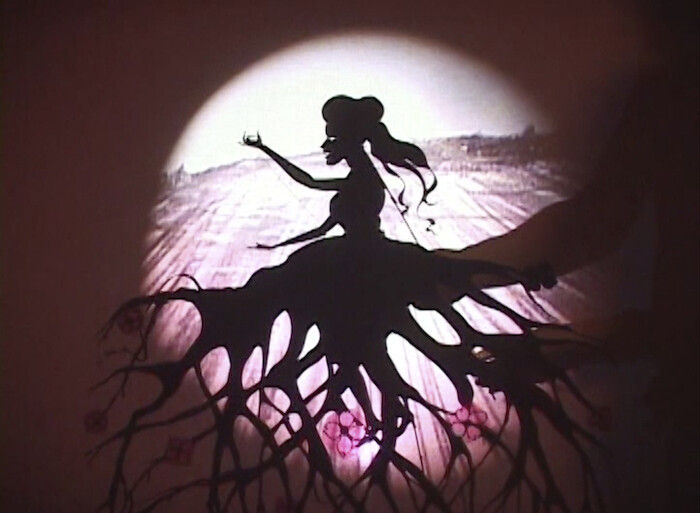
There are occasions in which the multifaceted shape of time becomes obvious. Occasions in which the concentration of similar initiatives, aimed at similar audiences and presenting similar outcomes, attest to the different moments in which organizations, individuals, and their mentalities are situated: how, despite coexisting simultaneously, collective mindsets aren’t contemporary to one another. Aimed at showing trendsetting cultural production and hosted in such a temporally dysfunctional city as Berlin—located in a permanent identity crisis between its haunting past and its daunting ahistorical future—the Gallery Weekend provides a good example of the heterogeneous configuration of this non-time called the present and how art participates in it. The present seems to be constituted by retrospective and anticipatory instances and institutions: individuals, objects, and imaginaries that live in parallel timeframes, either looking back or forward.
Sometimes, these temporal gaps are so large that different centuries span across the more than 50 exhibitions that opened during the Gallery Weekend. While some address the events and concerns that shaped the twentieth century, others look ahead, imagining the future. The moving image-based shows of two North American artists—Kara Walker and Ian Cheng, presented respectively at Sprüth Magers gallery and at the Berlin venue of the Julia Stoschek …
February 9, 2018 – Review
Transmediale, "face value"
Patrick J. Reed
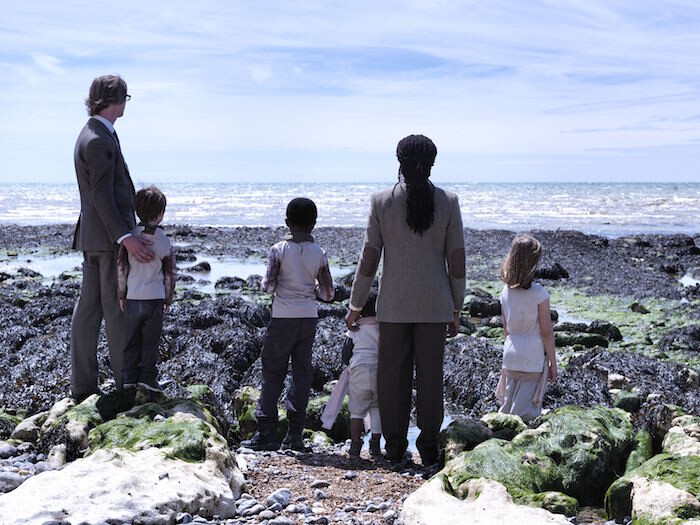
To my left the casual love of mismatched hearts is expiring. The American woman says, “you’re sad,” and the Frenchman nods. She tells him to calm down. It is breathtakingly awkward. They resign themselves to stillness until a grinding electronic drone heralds their graceless end. She makes a break for the cash bar, and he, with less determination, joins the nearest crowd. He stares with them in solidarity at a webcam feed showing empty winter highways projected large, and finds solace.
This is transmediale, Berlin’s premier art/media/technology festival and sometimes boneyard for feckless romance. Over three decades it has showcased ideas by those working at the forefront of digital aesthetics and theory. Its mandate, by its own decree, “…aim(s) at fostering a critical understanding of contemporary culture and politics as saturated by media technologies.”
“Face value” is this year’s umbrella motif, and, like past themes, it is highly accommodating. Spanning five days, the lectures, exhibitions, conversations, and screenings investigate the power of surfaces, from the origins of “face value” as economics lingo to its application by racist ideologies within the mediasphere. With so many experiences to be had and shared here, both visitor and contributor are apt to become lost in the …
January 29, 2018 – Review
“That, Around Which The Universe Revolves: Chapter V: Berlin”
Mitch Speed
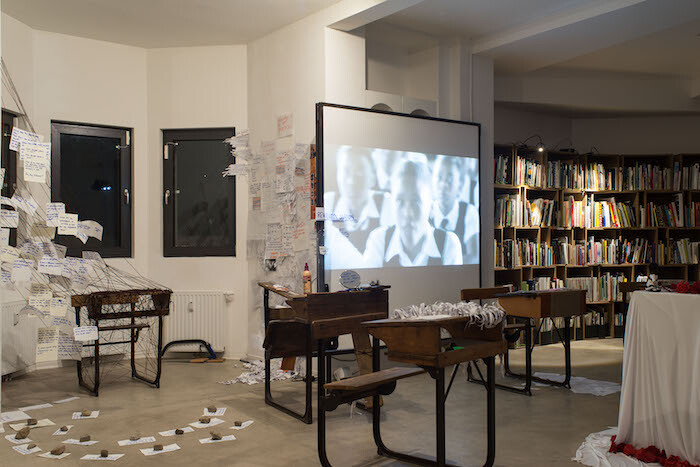
In the basement of a former Berlin crematorium, a small brass instrument sputters and hisses. The sculpture—Vartan Avakian’s Composition With A Recurring Sound (2016)—could be the baby cousin to a trumpet or saxophone. It is also the closest this group exhibition about rhythm gets to danceability. No surprise there. SAVVY is a space that emphasizes colloquy, meaning that its exhibitions and programs often seem less concerned with a central subject than that subject’s relation to a lived world. This exhibition concludes a program that extended into Berlin’s HAU theater and in 2016–2017 to Lagos, Düsseldorf, Harare, and Hamburg. It suggests an ad-hoc social nervous system, situating a willing viewer between the uncertainty of thinking and the affirmation of feeling.
The exhibition’s conceit is that artists can elucidate the unseen rhythms that structure life, while the rest of us—by implication—are bewitched by so many abstractions and constructs: work, finance, love… Not suffering from humility, this theme becomes modestly obliging in function: a discursive matrix interlinking the work. IQhiya—a collective of South African women artists—has modeled the possibility of questioning power through lines of free-association inquiry that one might liken to beats in social space. Monday (2017) is made from school desks covered …
January 17, 2018 – Review
"in search of characters…"
Patrick J. Reed
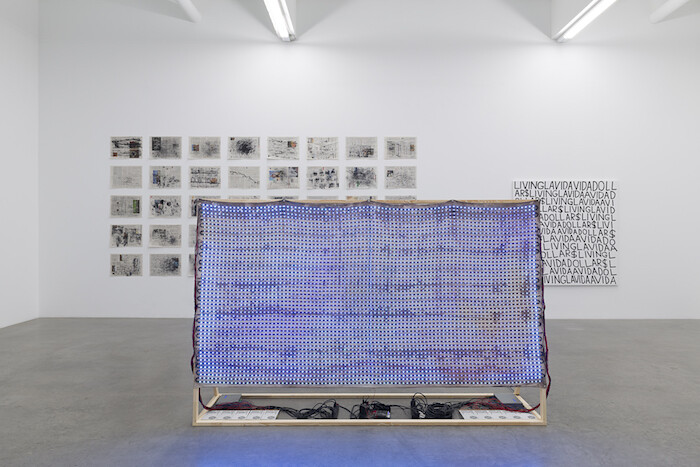
When the clock struck twelve in Berlin, “in search of characters…” transitioned from Galerie Neu’s final offering of 2017 into its first of the new year. Twenty-two works by fourteen artists comprise the exhibition exploring “questions of artistic identity/ies, authorship, and authority,” per the gallery press release. These perennial investigations take on various forms, but whether a painting or a minibar, all are aerated by two mischievous thoughts.
The gallery text conveniently articulates one: a rendition of the Duchampian “readymade” concept that, in 1914, crumbled the menhir of originality into the gravel upon which conceptualism has been driving in donuts ever since. At Galerie Neu, the most obvious benefactor of this tradition is Pubblicitá, pubblicitá, a 1988 advertisement designed for Philippe Thomas’s elusive faux company called “readymades belong to everyone ®.” Appearing as a poster and a postcard, it promotes the company’s initiative for a “total revision of authorial rights,” providing on-demand readymades ripe for inclusion among “all the best museums, galleries, and private collections.” Once in hand, the readymade product is in the custody of the buyer, who becomes its “sole and absolute author” (and art history’s exclusive canon becomes oversaturated with consumer anarchists). Sujet à discrétion (Subject to discretion) …
December 5, 2017 – Review
“The Undercover Economist”
Stefan Heidenreich
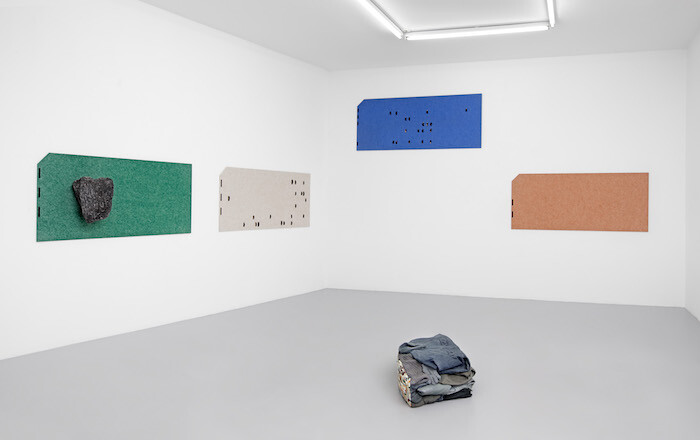
For some people, economy is mostly about money. But that is stupid: economy is actually about something else. Money is just the medium conventionally assigned to all tasks understood as economic. In the end, money is just a medium. For all those who firmly believe that the medium is the message, this might resolve the issue. In general I tend to count myself among these late McLuhanians, but when it comes to economy, I beg to disagree. Economy is not about money. It’s about distribution. And at this task, money performs worse and worse, as we know.
This misalignment hasn’t served the art world badly so far, at least for a small chunk of it. Maybe in a near future we will learn to read much of contemporary art’s output as an undercover service to this weird cult of liquidity.
The group show “The Undercover Economist” is centered around a sculpture by Liz Magor, titled Carton III (2006). Seen from the entrance of the gallery, it looks like a pile of old workers’ clothes. Shoes at the bottom, some trousers, a thick woollen pullover, and a heavy gray shirt on top, all neatly folded. Now, as if carried from one place to …
October 25, 2017 – Review
Katinka Bock’s “Smog”
Simone Menegoi
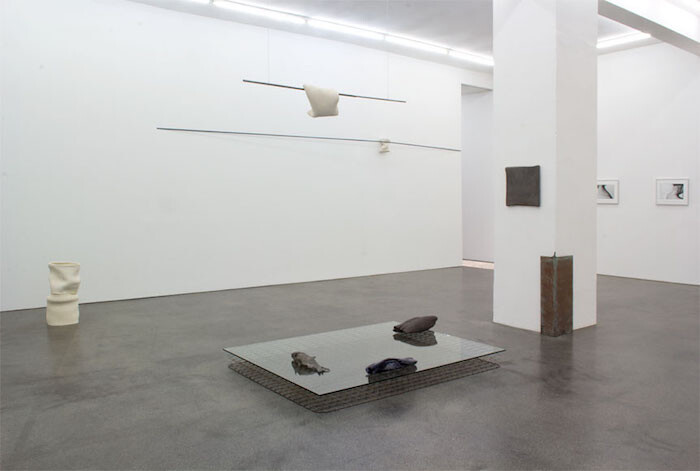
Katinka Bock compares works to words and exhibitions to texts. The analogy explains the relationship between the two aspects of the Franco-German artist’s work: the sculptures, silver prints, and occasional films, on the one hand, and the sophisticated displays that she creates out of them, whose value is greater than the sum of their parts, on the other. These correspond to two ways of reading Bock’s practice: to focus on the single work, with its delicate material qualities, or to embrace the whole, with its syntactic properties.
If Bock’s exhibitions are texts then “Smog,” her third solo show at Berlin’s Meyer Riegger, is particularly poetic. Two rooms are arranged as if they were two long sentences, rich in subordinate clauses and parentheses; sentences that could have been written by Marcel Proust, full of internal symmetries, of repetitions and variations, aimed at pursuing a nuance of perception or memory. The first room revolves around Grosse Liegende (2017), which is made out of several elements: a horizontal support (an old mattress coil topped by a glass pane), upon which the artist has placed the metal mold of a fish, a matte brown ceramic sculpture, and another ceramic sculpture with abraded blue enamel. The …
September 18, 2017 – Review
Art Berlin
Stefan Kobel
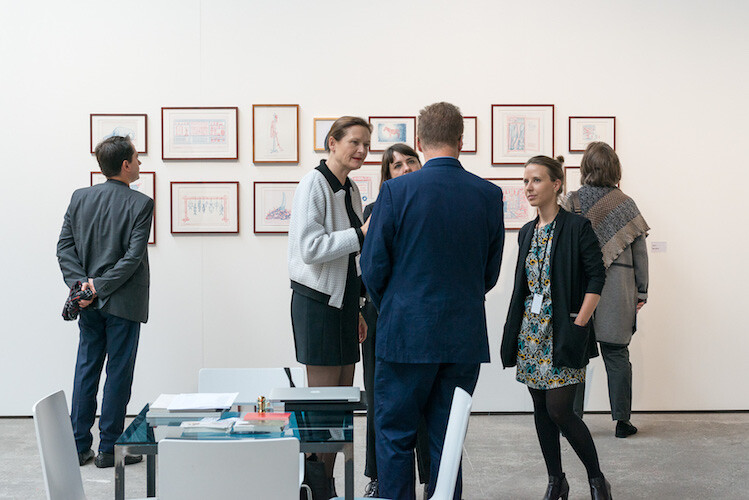
Can the German art market support four art fairs? The battle over market share is in full swing. Art Karlsruhe is a bit out of the game. Although it seems like a major event with more than 200 exhibitors, it can only cater to the country’s southwestern local audience due to its weak contemporary section. The two traditional strongholds of the market—Cologne and Berlin—are experiencing a major shake-up. The world’s oldest still-running fair for contemporary art, Art Cologne, faces a new competitor with Art Düsseldorf, set to open in November, less than an hour’s drive north. Set up by a company that had successfully run a low-level art fair in Cologne, the new fair has found support from MCH Group. The company owns Art Basel, which took a minority share in Art Düsseldorf as part of a strategy to boost its international activity in regional art fairs—with the option to take over the whole enterprise. So far the success seems somewhat dubious, not least because of the track record of Art Düsseldorf’s two founders, who in 2008 failed in establishing an international art fair in Cologne’s rival city under the name “dc.” So far only 9 galleries from Düsseldorf and …
June 29, 2017 – Review
“2 or 3 Tigers”
Ana Teixeira Pinto
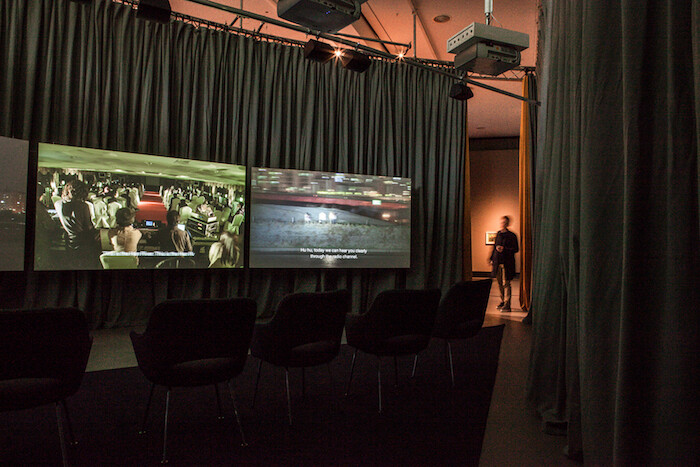
Though at present the concept of “media” is almost wholly equated with communication technologies, throughout the modern period this notion extended beyond the technological field, to include aesthetic and spiritual registers. In the late nineteenth century, a medium was someone with the alleged ability to act as a psychic conduit or transmitter, able to capture cosmic vibrations like a human radio frequency receiver. In the broadest sense, the term “media” introduces the concept of a coded mode of materiality—as W. J. T. Mitchell noted, the very notion of mediation “already entails some mixture of sensory, perceptual, and semiotic elements.” Marshall McLuhan’s notion of media, for instance, includes any “material in unfixed form, or even formless material, such as electricity,” and Friedrich Kittler generalized the concept of media to include all “domains of cultural exchange.” The body, or more accurately the nervous system, is the locus of interaction, the site upon which different media intersect. By emphasizing the notion of light as a medium—albeit one without any content—McLuhan underscores its power to shape the forms of human perception and interaction, socially as well as spiritually.
In the exhibition “2 or 3 Tigers,” curated by Anselm Franke and Hyunjin Kim for the Haus …
May 31, 2017 – Review
Eva Kot’átková’s “Diary of a stomach”
Ana Ofak

“What have you eaten today?” a metallic voiceover inquires. The reply, uttered by a child, hesitantly, is “nothing.” Yet in the course of the transitory interrogation that unfolds in the middle of Eva Kot’átková’s most recent film Stomach of the world (2017), currently being shown by the Polyeco Contemporary Art Initiative at the Benaki Museum in Athens, and related to an exhibition currently on view at Berlin’s Meyer Riegger, nothing becomes plenty of something. We listen to the child catalog thoughts and lost objects as if filling the void of sustenance. The empty stomach is repurposed into a container for the spam of life. Crammed with information, it becomes capable of expelling appetite and even anxiety from the system. Hunger, it seems to convey, is hunger for fabrication, not food.
Kot’átková’s installations tend to submerge the observer in such morbid enterologies of infant worlds. And infant worlds, we quickly gather, are no democratic assemblies. Working with collage, drawing, sculpture, film, and, lately, gallery walls, the artist has forged an idiosyncratic totality of these worlds over the years, which almost emulates an organism that sustains invariable aesthetics, yet generates ever-new contingencies connected to childhood. Kot’áková thereby characterizes childhood as a battery of …
May 2, 2017 – Review
Gallery Weekend Berlin
Sofia Lemos
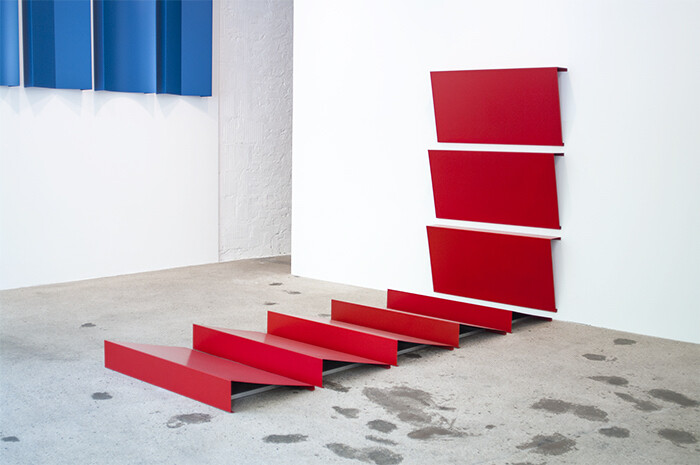
In the wake of the events of May 1968, German Minimalist Charlotte Posenenske wrote in Art International that “it is difficult for me to come to terms with the fact that art can contribute nothing to solving urgent social problems.”,” Art International no. 5 (May 1968), n.p.] Posenenske’s “‘Statement’ [Manifesto],” which initially meant to examine ownership and the reproducibility of her artworks, publicly announced the artist’s dismissal of the art world. Having retrained as a sociologist, Posenenske dedicated herself to working with labor unions and refused to show her work or visit any exhibitions until her death in 1985.
While gallery-goers shuttled through Berlin to the rhythm of scattered attention and market consumption, Posenenske’s show at Mehdi Chouakri set the tone for this year’s edition of Gallery Weekend Berlin. Selected galleries of all scales and scopes made a concerted effort to take up the conflated legacies of modernism, rationalized systems of language, and the critique of whiplash-paced figurations of the modern subject.
Mehdi Chouakri presents a series of abstract sculptures by Posenenske from 1967, as well as a selection of works on paper from the 1950s in their second space, also in Charlottenburg. Displayed in glass vitrines and hanging on the wall, …
February 16, 2017 – Review
Marcus Steinweg’s “For the Love of Philosophy”
William Kherbek
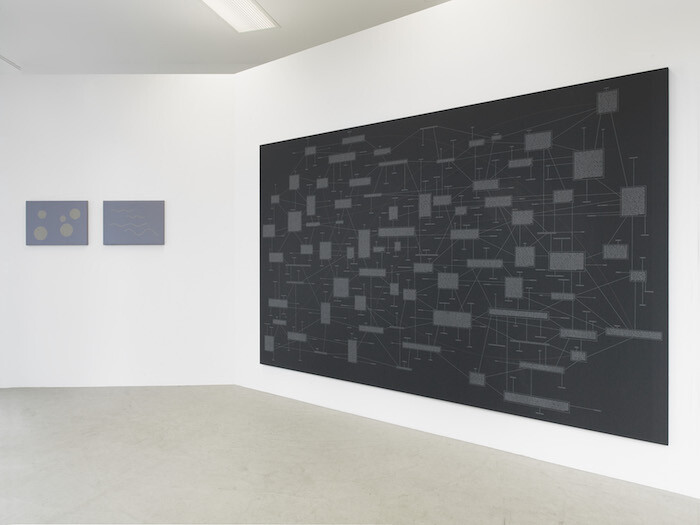
Descartes, Deleuze, Lacan, Nancy, Rilke, Weil, Heidegger (!) (just to name a few)—the gang’s all here at Marcus Steinweg’s new show at BQ, whose title, “For the Love of Philosophy,” certainly seems to ring true. “The self is the placeholder and performer of chaos. Descartes already knew this, that is why he wasn’t a Cartesian.” So reads one of the more gnomic assertions on Steinweg’s canvases. These works are positively overflowing with passion for his subject matter, and even if his references aren’t very geographically or culturally diverse, they are at least honestly engaged with, and speak of a deep and abiding commitment to the discipline and practice of philosophy. Steinweg’s canvas-as-parchment approach to the material, however, feels like a somewhat suboptimal marriage of form and content.
Steinweg presents 13 paintings from the series from which the exhibition takes its name. Cleaner and tighter than some of his earlier works on canvas, they feature sleek white digital letters printed on dark backgrounds, or a hide-and-seek of grey and yellow hues. Each presents a section of text, sometimes simply words, other times diagrams, or what might be regarded as a new sub-species of aesthetic literature, concrete philosophy: text arranged into layouts that …
January 25, 2017 – Review
Musa paradisiaca’s "Masters of Velocity"
Ana Teixeira Pinto
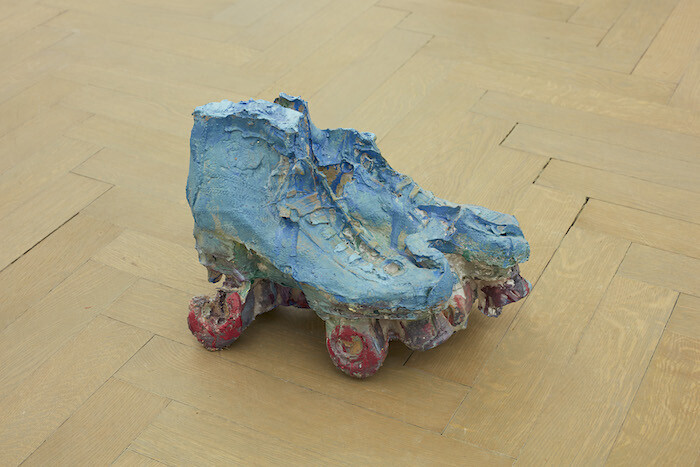
When writing the now-famous entry for the word informe (formless) in the surrealist journal Documents, Georges Bataille started by saying that “a dictionary begins when it no longer gives the meanings of words, but their tasks.” “Formless” is a word tasked with declassifying (déclasser), which in French also connotes degrading or debasing. Whatever gets called formless “has no rights of whatever kind and can get squashed at any moment, like a spider or an earthworm.”
Though Bataille had philosophical forms in mind—philosophy’s sole goal, he continued, is to dress in a formal frock coat everything that is—obsession with formal discipline extends beyond the philosophical register, to fields as diverse as visual art or biology. So much so that even formlessness has become a formal category. Amazon.com, for instance, presents Formless: A User’s Guide (1997) by Yve-Alain Bois and Rosalind Krauss—in which Bataille’s dictionary entry appears as an epigraph—as a “rich and compelling panorama of the formless”: a taxonomy of forms of formlessness, so to speak.
The work of Portuguese artist duo Musa paradisiaca (Eduardo Guerra and Miguel Ferrão) is closer to what Bataille originally intended by his definition. Formlessness, in their approach, is not category but a task—one could say form follows …
December 21, 2016 – Review
Spiros Hadjidjanos
Elvia Wilk

Spiros Hadjidjanos’s third solo show at Future Gallery is both technically and conceptually complex—it’s up to the viewer to decide how far down the rabbit hole to go. Yet each work functions on multiple levels, and is rewarding in equal proportion to how much time one dedicates to figuring it out. For instance, one could appreciate Hadjidjanos’s Network/ed Pillars (Taraxacum Officinale Arrangement) (2016) (part of the ongoing project “Network Time,” 2010–2016) installed in a new configuration in this untitled exhibition, solely on the level of aesthetic experience: in a darkened room of the gallery, a group of ten routers is arranged on the floor, each one with a fiber optic cable attached to a blinking LED light on its surface. The cables extend the lights up to the ceiling in long, bright vertical lines, creating a poetic visualization of their fluctuating signals.
Aesthetically seductive, this setup also illustrates several technical processes at work: each router generates an open wireless network and any device within range can automatically connect to one at random. So if someone in the room is connected to a network, the blinking of the respective router will change slightly, hinting at the action. This activity may be (barely) …
December 15, 2016 – Review
Dominique Gonzalez-Foerster’s “QM.15” and “Costumes & Wishes for the 21st Century”
Antje Stahl
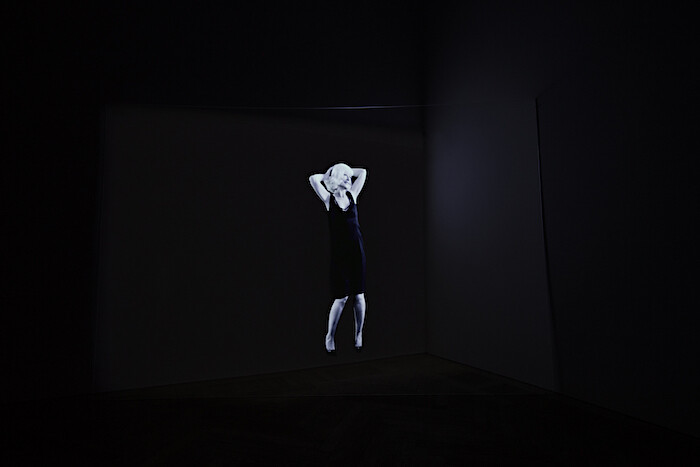
I was sent into darkness. I couldn’t see a single thing. There was a fuzzy light right behind the gallery door illuminating press releases laid out on a small table, and a gallery staffer equipped with a small flashlight. But she simply pointed into the dark: “That way.” That way was Dominique Gonzalez-Foerster’s exhibition “QM.15” at Esther Schipper in Berlin. That way felt like a ghost hall.
I heard a female voice singing an aria, but I had to pass by a life-sized moving image of a woman in a white uniform, fumbling my way along, before I fell over a rope that prevented me from reaching its source: an apparition of Maria Callas. A holographic illusion, to be more precise, of Dominique Gonzalez-Foerster playing Maria Callas: Opera (QM.15) (2016).
I don’t have a particular passion for being blindfolded. I hate ghosts, and I also hate costumes. A day before Halloween, Berlin’s Schinkel Pavillon organized an event for people who are, I guess, excited about these things: a costume party as part of an exhibition. Produced by the artist in collaboration with the Berlin fashion designers BLESS and design studio Manuel Raeder, “Costumes & Wishes for the 21st Century” could be considered …
July 29, 2016 – Review
Michael Rakowitz’s “The invisible enemy should not exist”
Ana Teixeira Pinto
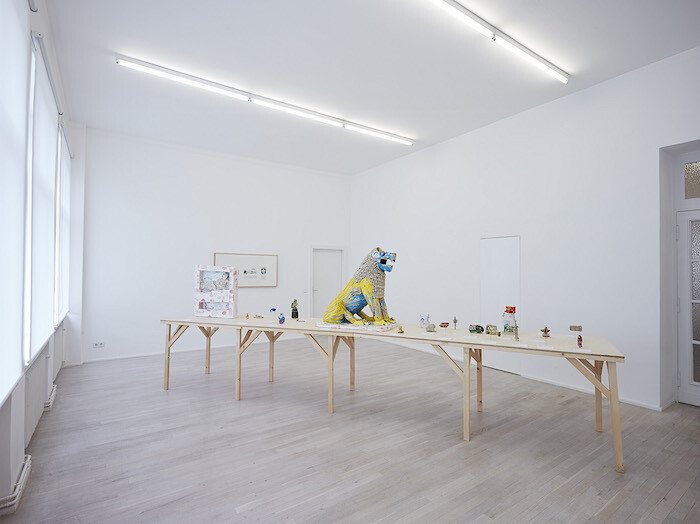
The Invisible Enemy Should Not Exist (Aj-ibur-shapu), from which Michael Rakowitz’s exhibition at Barbara Wien in Berlin borrows its name, was how the street which ran through the gate of Ishtar, in ancient Babylon, was known. Built around 575 BC under King Nebuchadnezzar II and dedicated to the goddess Ishtar, the gate was made of glazed brick covered in lapis lazuli and decorated with alternating rows of dragons and aurochs. Unearthed in 1899, the site where the gate originally stood was greedily excavated by German self-taught archaeologist Robert Koldewey, who lifted up the entire tower and shipped it to Berlin, where it still stands as the main attraction of the Pergamon Museum. Though Iraq repeatedly protested this heritage seizure, the gate—much like the ancient Greek Pergamon Altar, taken from present-day Turkey—was never returned.
In the nineteenth century, archaeology was a discipline mainly deployed in countries where its practitioners had no cultural relation to the population whose history they unearthed. When Europe elected Babylonia as the origin of (its) civilization, it did not simply appropriate its archaeological treasures, it also appropriated its history. Implicated in foundational myths and nation-building, archaeology became tied to colonial history: everyone has a claim to Babylon, except …
July 19, 2016 – Review
KwieKulik’s "The Monument Without a Passport"
Stefan Heidenreich
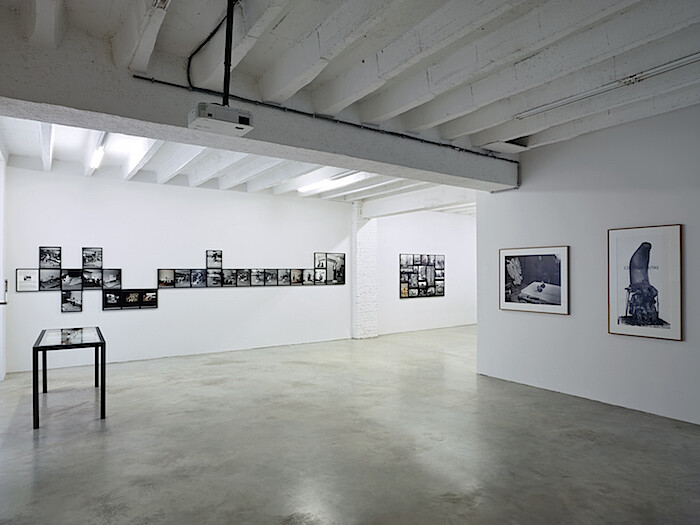
Resistance is a two-sided relation. It may also include more players, as we will discuss shortly. But losing its counterpart puts it in a difficult place. All political art has to deal with this dialectic entanglement.
In 1976, artists Zofia Kulik and Przemysław Kwiek were summoned to the Polish Ministry of Culture and Art in Warsaw. They were told that they were no longer allowed to represent Polish culture abroad. Their passports were withdrawn.
From 1971 onwards, both worked under the name KwieKulik. Until 1987, they produced what was considered one the most important bodies of political performances in Europe. In 2007, Documenta 12 showed Activities with Dobromierz (1972–74), a tableau of 48 black-and-white photographs documenting their newborn son surrounded by household objects, to be understood as a general reference to social relations and artistic practice. Then, in 2009, they were invited to the 11th Istanbul Biennial, and their work was rediscovered by a wider public.
The timing of their rediscovery—as much as the timing of the passport affair—is no coincidence. To understand the political aspects of KwieKulik’s work it is necessary to take a look at their resistance’s counterpart. In the mid-1970s, the Polish government (under First Secretary Edward Gierek, whose policy …
June 6, 2016 – Review
9th Berlin Biennale, “The Present in Drag”
Travis Diehl
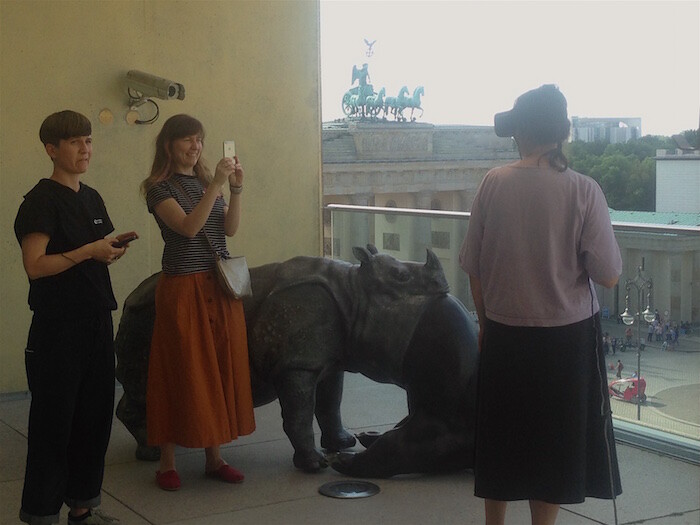
“Advertisting … is the only art form we [in the United States] ever invented.” Gore Vidal
The fourth floor of Berlin’s Akademie der Künste overlooks Pariser Platz: the Brandenburg Gate, the French embassy fringed with barricades, a teeming Starbucks. Tourists mill around the square, while up on the mezzanine, between a set of marble statues of animals improbably swallowing other animals, a queue forms behind an Oculus Rift rig: Jon Rafman’s View of Pariser Platz (2016). At first the rendered scene in the headset matches the architecture and sculptures. A dog gags on a lion, an iguana gulps a sloth. Slowly, the animals start swelling, expelling, gyrating; the view fills with fog. Human figures blow upwards like flapping skins. Soon the pavement and building break apart; the viewer freefalls among the debris, landing, after a moment, among ranks of featureless mannequins… Rafman’s technical hallucination takes roughly three minutes. For three minutes, the setting in all its very real paradox—a symbolic gateway between West and East, Reagan and Gorbachev, also known as the place where Michael Jackson dangled his baby from a balcony—falls away beneath an encompassing, scripted but nonreactive spectacle. Thus the city rebrands itself: a new ad on a …
June 4, 2016 – Review
9th Berlin Biennale, “The Present in Drag”
Tess Edmonson
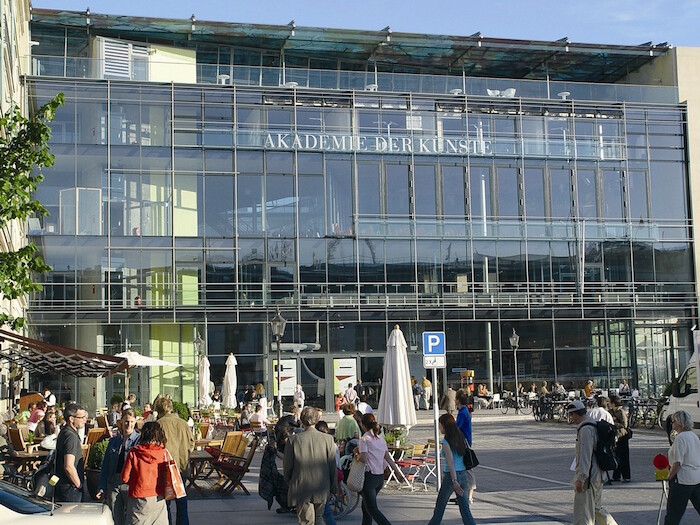
Berlin’s history of internecine violence is visible on its civic surface, a characteristic that holds currency in both mainstream and art tourism; what differentiates these two modes is a style rather than a politics. Who can say what a city means?
Gentrification mistakes lack of capital for lack of life, confuses the unexploited with the uninhabited. Over the course of its 18 years, the history of the Berlin Biennale has paralleled the drastic conversion of its symbolic center—the KW Institute for Contemporary Art and surrounding area on Auguststrasse—from post-GDR bohemia to a neoliberalism fully realized. For this year’s edition of the biennial, the ninth, curators Lauren Boyle, Solomon Chase, Marco Roso, and David Toro (known collectively as DIS) propose to orient audiences differently, moving the exhibition’s main venue to the Akademie der Künste on Pariser Platz, adjacent to the Brandenburg Gate, an area populated mostly by tourists, government officials employed in nearby offices, and police.
The appointment of DIS, best known as the publisher of the eponymous online magazine, exacerbated existing polarities among local artists and producers, where distrust of all that’s mediagenic, internet-literate, or American often barely disguises casual classism, or a nostalgia for the difference the city (and its art …
May 2, 2016 – Review
Gallery Weekend Berlin
Karen Archey
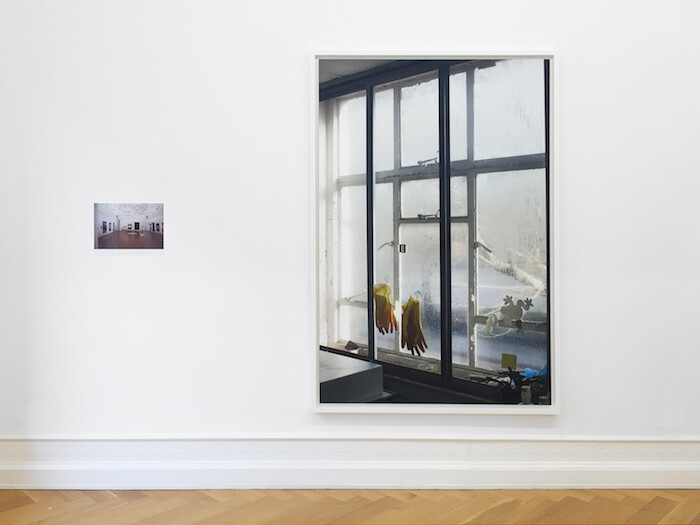
When the 7 percent value-added-tax rate on fine art went up to 19 percent in January 2014, it spelled to many the end of the Berlin art world. Proclamations followed that the market would dry up, and collectors would scatter to more cosmopolitan locales with less pricey export taxes. Without patrons or a steady stream of capital, how could Berlin’s artists thrive? The sheer volume of the jam-packed 2016 edition of Gallery Weekend Berlin suggests that the German capital’s art market is healthy as ever in its upper echelons, especially given the pricey 7,000-7,500 euro gallery participation fee, though younger galleries, perhaps hit hardest by the VAT rate update and who have largely figured these new expenses into the prices of their offerings, have seemingly responded with conservatism.
Two outliers to this trend are Aleksandra Domanović’s “Bull Without Horns” at Tanya Leighton and Alice Channer’s “Early Man” at Konrad Fischer. Domanović’s exhibition fills both of Leighton’s galleries, and includes her now-iconic sculptures featuring the Belgrade hand. Most unique in this exhibition are her new portraits of bulls that have been genetically modified to prevent them from growing horns. The large-scale, documentary-style photographs come off as earnestly tacky in a way that, …
April 11, 2016 – Review
Mary Reid Kelley’s “The Minotaur Trilogy”
Ana Teixeira Pinto
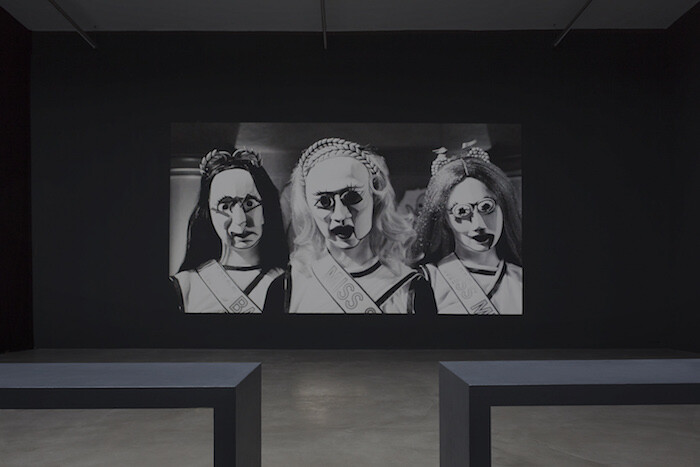
Pasiphae, the protagonist of Mary Reid Kelley and Patrick Kelley’s film series “The Minotaur Trilogy” (2013–15), was the queen of Crete, married to king Minos, the son of Zeus and Europa. Her story is a tale of offence and punishment, but not a straightforward one. Minos, who had just ascended to the throne, asked the god Poseidon for support. Poseidon sent him a white bull, which in Minoan mythology was no bull but the god himself in his pre-Olympian form. The bull was supposed to be sacrificed to Poseidon but Minos deviated from due observance and kept it instead. As a punishment, the god cursed the queen with the most unnatural lust: a sexual urge to mate with the nonhuman other, which was god and animal at once. In order to copulate with the bull, Pasiphae made Daedalus build her a casket in the form of a cow, with which she could arouse the bull’s libido. Mistaking it for a mate, the bull coupled with the man/machine contraption, impregnating the queen inside. Unfortunately for all involved, the materialization of Pasiphae’s monstrous desire was bound to be a monster: the Minotaur.
Mary Reid Kelley’s queen was inspired by, and partially adapted from …
December 22, 2015 – Review
“Ich kenne kein Weekend. Archive and Collection René Block” (Part III/III)
Eva Scharrer
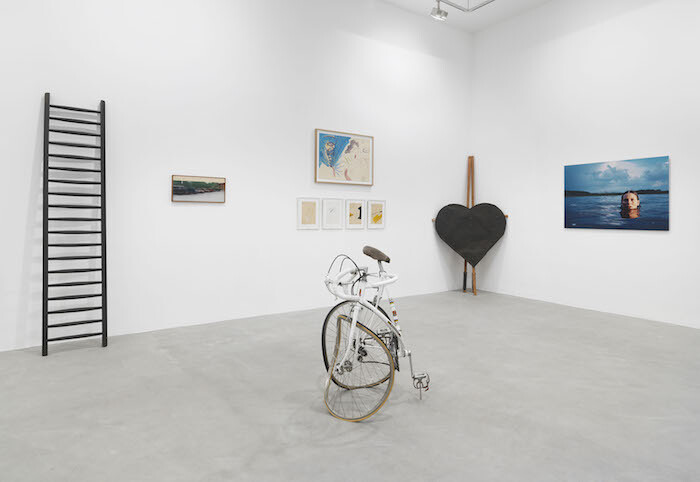
In tandem with “Ich kenne kein Weekend. Archive and Collection René Block,” a double-venue exhibition recognizing the work of gallerist, curator, and collector René Block organized in Berlin this autumn, art-agenda presents a three-part feature on Block. Parts I and II (available here and here) consist of an interview led by Luca Cerizza, while Part III, an introduction to the current Berlin exhibitions, written by Eva Scharrer, follows.
On September 15, 1964, René Block opened his gallery in West Berlin—thus opening a new chapter in art history. Fifty-one years later to the day, “Ich kenne kein Weekend. Archive and Collection René Block” is presented across two Berlin institutions: the Neuer Berliner Kunstverein and the Berlinische Galerie. Likely the first-ever retrospective of a curator, it looks back at more than five decades of exhibition-making between the art market and cultural politics. A publisher, dealer, facilitator, networker, pioneer of artists’ multiples, and curator, Block has organized more than 200 exhibitions and at least as many events, always shifting public perspective from the center to the margins.
Entering each exhibition, one first encounters an enlarged drawing, a mind map consisting of a series of big and small circles, connected by various single or reciprocal …
December 16, 2015 – Review
Peter Fend’s “to be built”
Elvia Wilk
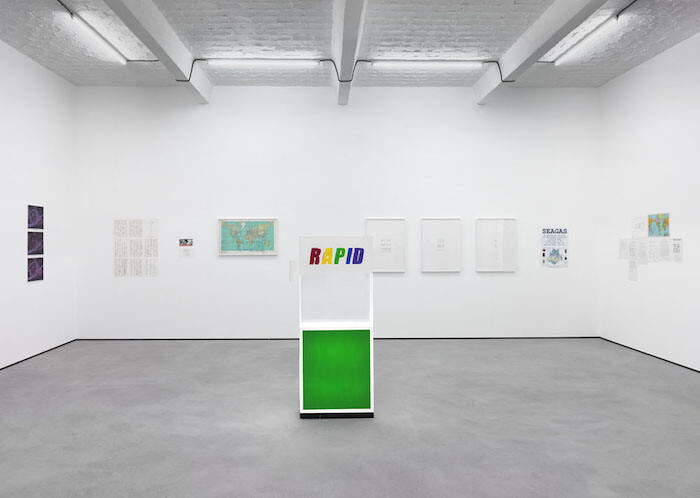
At first I had the feeling I was missing something when I encountered the documentation of unbuilt works by Peter Fend at his show “to be built” at Galerie Barbara Weiss, organized in collaboration with the project space Oracle. The drawings, prints, collages, and documents on display, mostly from the first 20 years of Fend’s practice, are billed as projects meant “to be built,” but if they’re really instructions, they’re hard to follow. For example, Delancey Street goes to the Sea, II, III, and IV, a series of quite beautiful collages from 1979, declares “CON ED / NO MAJOR GAS LINES DOWNTOWN,” with text overlaid on an aerial shot of lower Manhattan, followed by “SEA GAS INSTEAD,” the proposed solution. Red and orange lines drawn over the image demonstrate how waste pipes could be extended from Delancey Street across Brooklyn and into Jamaica Bay, and sea gas could be sent back again. Sounds like a good idea. But how, exactly, would sea gas get made from the waste? Could you really lay a pipeline in a straight shot across an entire borough? Who would finance the project? Wait, what’s sea gas again?
Fend is probably best known for his founding role …
December 8, 2015 – Review
The Gallerist: René Block and Experimental Music, 1965–1980 (Part I/III)
Luca Cerizza

In tandem with “Ich kenne kein Weekend: Archive and Collection René Block,” a double-venue exhibition recognizing the work of gallerist, curator, and collector René Block organized in Berlin this autumn, art-agenda presents a three-part feature on Block. Part I and II consist of an interview led by Luca Cerizza, while Part III is an introduction to the current Berlin exhibitions, written by Eva Scharrer. Part I follows, Part II will be published on December 15, and Part III on December 22, 2015.
The first time I met René Block with the proposal of writing a profile on his work as a gallerist for art-agenda, he mentioned a forthcoming exhibition and immediately took out a sheet of A4 paper on which he had drawn a colorful map. Composed of a series of circles of different colors connected by arrows, this sketch visualized 50 years of Block’s career, from the opening of Galerie Block in Berlin in 1964 to the planning stages, in 2014, of a double-venue Berlin exhibition on his life’s work. Almost one year later, on September 16, 2015, the Neuer Berliner Kunstverein (n.b.k.) and the Berlinische Galerie opened the two-part retrospective “Ich kenne kein Weekend: Archive and Collection René Block,” …
December 3, 2015 – Review
Hito Steyerl’s “Left To Our Own Devices”
Ana Teixeira Pinto
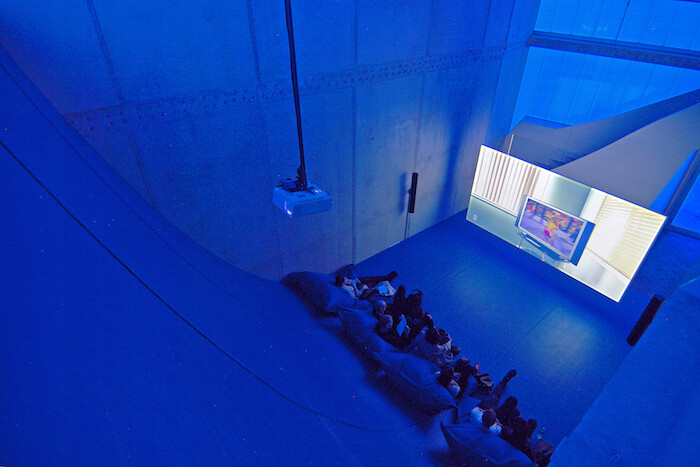
Entering the philosophical lexicon during the eighteenth century, the term “aesthetic” is predicated on a double negation: its object is neither an object of knowledge, nor an object of desire. By introducing the notion of disinterest, Kant brought the concept of taste into opposition with the concept of morality. At the beginning of his “Critique of Judgment,” he illustrates his reasoning with the example of a palace, in which aesthetic judgment isolates the form alone, disinterested in knowing whether a mass of working poor toiled to build it. The human toll must be ignored in order to aesthetically appreciate an artwork. Art forms, we are told, operate at a remove from social forms. But this remove needs manufacturing. This is the role of the institution and the social technologies it employs. In her video installation Guards (2012), German artist Hito Steyerl shows how this space of Innerlichkeit [inwardness] is built on the backs of those it excludes.
The museum guards who work for the Art Institute of Chicago are all African-American—a makeup indicative of the over-representation of the city’s black minority population in low-wage jobs. From the reports by head of security, Martin Whitfield, and fellow guard Ron Hicks, we can …
November 9, 2015 – Review
Slavs and Tatars’ “Dschinn and Dschuice”
Ana Ofak
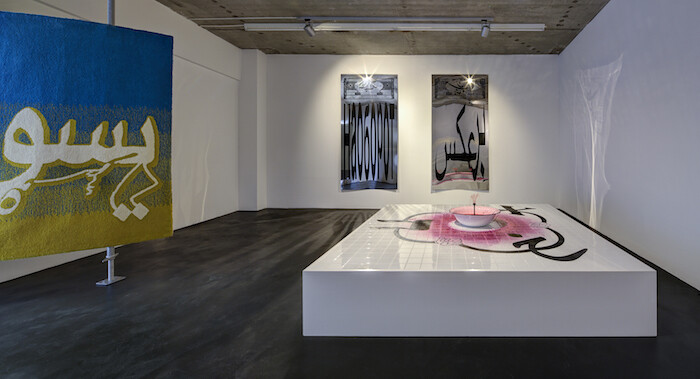
On the occasion of their nomination for the Preis der Nationalgalerie in 2015, Slavs and Tatars’ work can presently be viewed at two locations in Berlin. One is the Hamburger Bahnhof, the institution hosting the prize. There, books by the art collective are offered up for viewing in what looks like a swingers’ club for bookworms. By now, Slavs and Tatars have published ten books, making these the heart of their production. The other exhibition is at Kraupa-Tuskany Zeidler. Although the gallery show lacks the legs that lure and the dangling swings of the Hamburger Bahnhof presentation, it is far more daring. Together, the two sites unlock the universe of holistic heuristics Slavs and Tatars have been constructing for almost a decade. In this universe, the veils of obscurity that fell over the Eurasian territory, covering it in a neoliberal economy of uniform individualism, are lifted.
Slavs and Tatars are supreme wordsmiths. Hardly another letter in the pool of Slavic languages of Eurasia requires so much artistry in articulation or, for that matter, causes so much transcription trouble in the West as the Dž or Dż [d͡z] in the exhibition’s title. But “Dschinn and Dschuice” does not simply poke fun at …
September 18, 2015 – Review
abc art berlin contemporary
Tess Edmonson
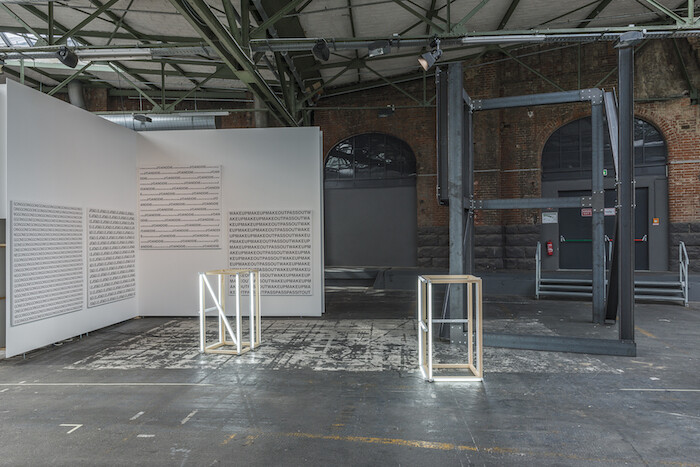
As with all art fairs, the advent of Berlin’s abc art berlin contemporary brings with it a smallish number of collectors and a torrent of platitudes, most of them having to do with how depressing it is to look at art as though shopping. I wonder if it might be productive, however, to confront the idea that any grouping of artworks—at an exhibition, a fair, or elsewhere—is just a mess of saleable objects, despite one’s best attempts, through critical discourses, to see them otherwise. Near to the fair’s entrance, for example, Berlin’s Galerie Neu has a presentation of works from Swedish-born local treasure Karl Holmqvist. The booth hosts four identically sized prints on square canvases bearing Holmqvist’s idiosyncratic caps-lock text (poetry?) in simple black block characters on white, maybe like a painting of an .rtf file. Untitled (J/O&D.I.E.) (2015) repeats the title’s parenthetical phrase in lengthy succession, while Untitled (GONEJ/OANDDIE) (2015) makes use of the same group of words in sequence with another: “GOINGGOINGGONE.” For all their simplicity, Holmqvist’s text prints reject an economy of language, using repetition and permutation to expand and multiply rich and slippery meanings. In Maggie Nelson’s The Argonauts, she writes (quoting poet Anne Carson in …
July 14, 2015 – Review
Thomas Locher’s "Post-Information"
Ana Teixeira Pinto

Long before post-internet aesthetics and ubiquitous networking began to overhumanize technology, men in gray flannel suits were the standard metaphor for the dehumanizing nature of corporate technocracy. This expression, which swiftly became vernacular, stems from a 1955 novel by Sloan Wilson, The Man in the Gray Flannel Suit, describing the search for purpose in a pre-digital context amongst those who perceived themselves as just an organic extension of managerial structures. “Post-Information,” Thomas Locher’s current exhibition at Silberkuppe, in Berlin, is all about men in gray flannel suits—or rather, their absence.
In “Post-Information,” the display mirrors the subject matter: the exhibition spans two soberly staged rooms, which are metaphorically sealed off by the strategic positioning of an aluminium, shelf-like sculpture, Gestell (1990), obstructing the gallery’s entrance/exit. The series “Politics of Communication” (2000), shown in the second room of the gallery, consists of five large-scale composites of image and text. The pictures are of office furniture ranging from sleek to functional—at times as individual items (office chairs), at times as complete ensembles (workstations, conference rooms, storage systems). Each grouping is accompanied by text captions, which either describe or examine the tenets of communication theory: the nature of information, message, code, medium, and meaning. …
July 7, 2015 – Review
Bojan Šarčević’s “In the Rear View Mirror”
Stefan Heidenreich
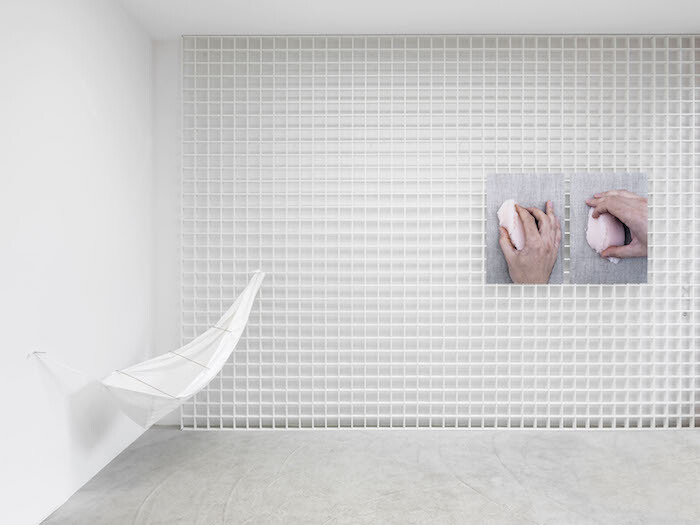
For this show, knowing too much before seeing may not be helpful, and may even spoil your viewing experience. Bojan Šarčević is an artist who doesn’t like to wrap his art in too much information. Objects and works are supposed to stand for themselves. At his show at Berlin’s BQ, no item bears a title. Press release and handout, both formats which have become standards of gallery communication, are missing. The spectator is left with what is there, and supposed to figure out what that is for herself. Šarčević’s refusal to give additional information reminds us of the degree to which we as observers have been lured into a position that makes us complicit in a certain game of producing and circulating meaning. Given all the research on art and the observer, I wonder if anyone ever cared to investigate the discursive role of metadata, the format of small texts accompanying works of art, and the paratext around exhibitions.
There was a time, at the peak of modernism, when artworks were meant to create a direct, non-verbal line of communication between the artist and the observer, free of references and full of subjectivity. Back then, artistic autonomy was taken for granted …
June 10, 2015 – Review
Kader Attia’s “Scarification, Self Skin’s Architecture”
Ana Teixeira Pinto
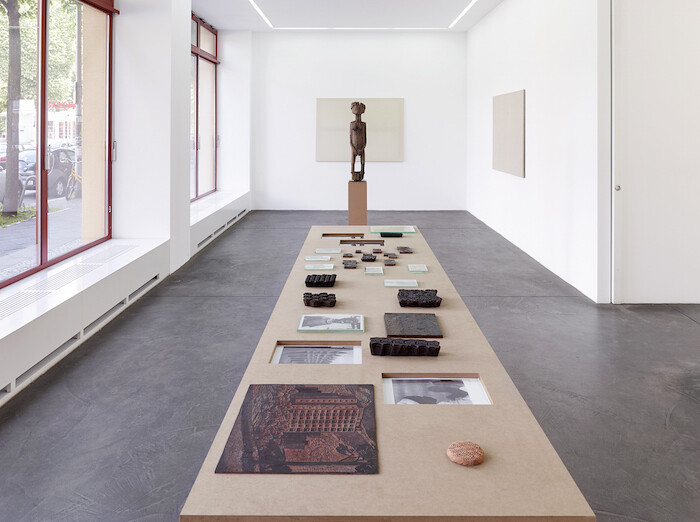
Kader Attia’s current exhibition, “Scarification, Self Skin’s Architecture” at Galerie Nagel Draxler, Berlin, is the latest iteration of a project the French-Algerian artist initiated with his installation The Repair from Occident to Extra-Occidental Cultures, presented at Documenta 13 in 2012. That first iteration could perhaps be described as an essay in comparative aesthetics written from the vantage point of the wretched of the West. Juxtaposing the disfigured faces of World War I soldiers against broken fetishes, fractured African masks, or stitched-up pieces of loincloth, the project described a narrative arc from the practical notion of repair—redefined as the practice through which colonized cultures appropriate the symbols of the colonizing powers into their own cultural idioms—to the juridical realm of “reparation,” as in the replenishment of a previously inflicted loss.
In “Scarification, Self Skin’s Architecture,” Attia returns to this dialectics of destruction and healing, this time through an inquiry into the at-times-material, at-times-metaphoric meaning of injury. The exhibition is staged upon and around a table, Self Skin’s Architecture (2015), surveyed by a wooden sculpture made by the Mahafaly (an ethnic group from Madagascar), severely scarred by horizontal splits. On the table, several photographs of African women with ritual scarifications on their torsos …
May 4, 2015 – Review
Gallery Weekend Berlin
Kirsty Bell
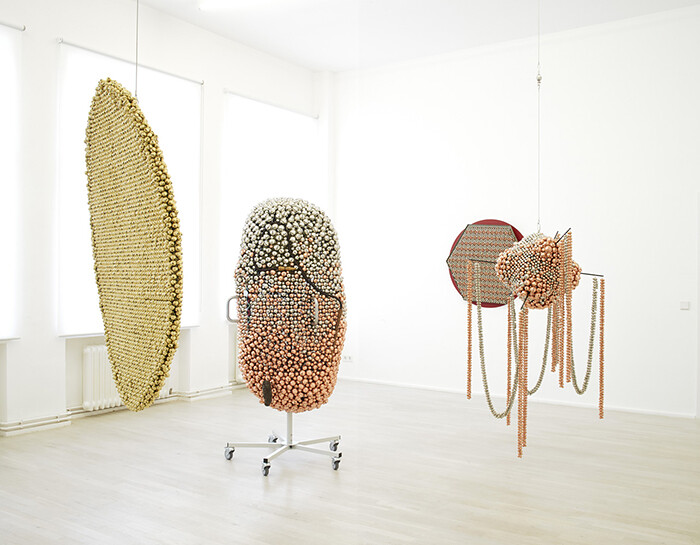
Gallery Weekend arrives just as the first green leaves appear to relieve the city’s relentless gray. This is Berlin at its best: colorful, uncharacteristically cheerful, and ready to welcome the influx of art tourists for its annual weekend of openings and attendant festivities. This year a total of 47 galleries are on the official list, but a host of the additional exhibitions, performances, conferences, and talks, all maddeningly crammed into a three-day period, makes the weekend denser than ever. The choices of what to see and what to skip become ever more critical. Haegue Yang’s endearing jingle bell sculptures at Wien Lukatsch? Tino Sehgal’s songstress ensconced in a flower garden at Johnen Galerie? Cyprien Gaillard’s nighttime forays in seductive 3D splendor at Sprüth Magers?
The result of such a jam-packed weekend is inevitably a list of things missed as well as things seen: I didn’t make it to “Ngorongoro,” a rambling exhibition of over 100 artists in a studio complex in the northern district of Weissensee; or the conference on the current “Zero” exhibition at the Martin-Gropius-Bau, which boasted an impressive lineup of high-caliber speakers; nor the above-mentioned Gaillard film, Nightlife (2015), given the impossibly long queue to get in. My …
March 4, 2015 – Review
Reena Spaulings’s “Later Seascapes”
Stefan Heidenreich
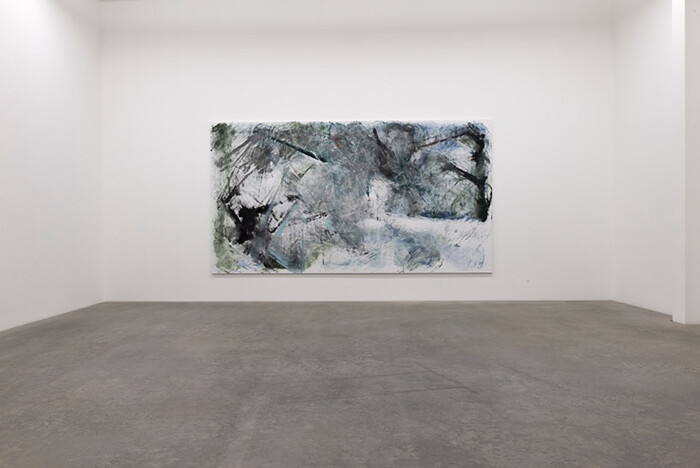
We are all told again and again that in a more or less distant future, machines will take over—either in the form of an inverted big bang, a type of singularity, or over the course of a gradual transition. Even creative jobs will not be safe from the robot’s omnipotence. But for now, machine intelligence still has its limits.
In her most recent exhibition at Galerie Neu, the fictional artist Reena Spaulings (a collective of artists including, in this exhibition, John Kelsey, Jutta Koether, and Emily Sundbladt) shows four large-format paintings. All of the canvasses were colored by a floor-scrubbing robot called Scooba 450 and using high-end decorative wall paint colors with names like “Mouse’s Back” or “Smoked Trout.” One of the paintings is titled Bohemian Groove (all works 2015), a pun on the famous Californian all-male VIP resort Bohemian Grove. The other three all are titled Later Seascape, a reference to works of William Turner, the nineteenth-century English painter whose works became almost abstract in his later period. All the paintings on display in the gallery—and even some more of the same series, not exhibited here—were produced during the week leading up to the opening.
The show is not Reena Spaulings’s …
February 25, 2015 – Review
Yael Bartana
Kirsty Bell
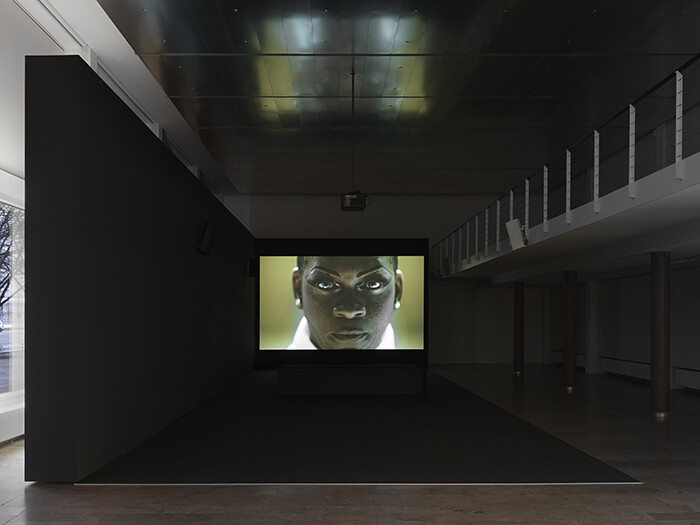
Having transformed Capitain Petzel’s glass showroom gallery into a dark, carpeted two-floor Kino, Yael Bartana went on to invert heaven and hell. Inferno (2013), screening on the ground floor, was all fire, brimstone, death and destruction, while True Finn (2014), in the basement below, was a peaceful haven of snowy landscapes and wood-paneled interiors, in which the workings of compromise, tolerance, and freedom of speech were played out. The first film is a mock biblical epic—a “historical pre-enactment” that fuses fact and fiction by staging the destruction of a replica of Solomon’s Temple which, incredibly enough, was recently built in downtown São Paulo by an evangelical Neo-Pentecostal church. In the second film, we follow the progress of eight Finnish participants from different ethnic backgrounds brought to a remote house in the countryside in order to determine which of them is the “True Finn.” Like the Israeli artist’s previous films, these works both traffic in polemic and provocation, but are nonetheless rooted in the political realities of their respective sites. In both, Bartana plays devil’s advocate, zeroing in on the nub of the dilemma—whether adversarial claims on religious history, or on national identity—and taking it to a logical, if extreme, conclusion. …
February 11, 2015 – Review
“SIGNS FICTION: Ruth Wolf-Rehfeldt” and “HOME ARCHIVES: Paulo Bruscky & Robert Rehfeldt’s Mail Art Exchanges from East Berlin to South America”
Doreen Mende
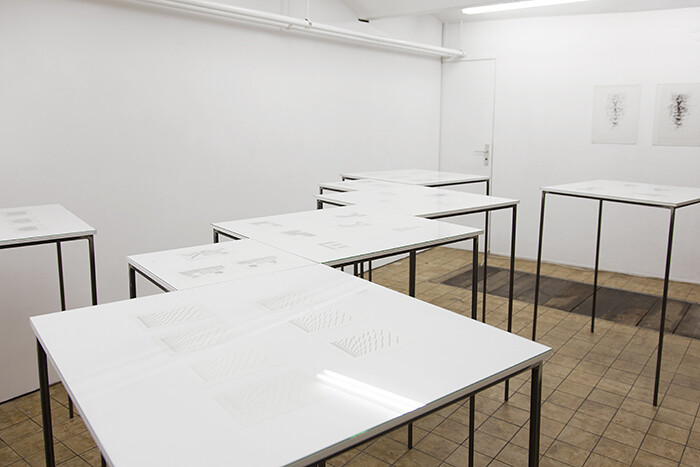
How can one detach oneself from the contemporary communicative capitalism that legitimizes the perpetual upgrading of governmental surveillance, as recently exemplified by certain state responses to the shootings at the offices of Charlie Hebdo in Paris? A valuable point of entry is the work of artists who lived under extreme conditions of state control, such as those instituted under the one-party socialism of the GDR or the military dictatorship in Brazil during the late Cold War—artists that defied massive national surveillance strategies while risking a systematic exclusion from institutional support. “SIGNS FICTION” and “HOME ARCHIVES,” two exhibitions at Chert, offer a compelling, non-historicizing insight into the capacity of artistic strategies with geo-poetic quality to move below monitoring powers.
Ruth Wolf-Rehfeldt (b. 1932) is one of these artists. Living in the Berlin neighborhood of Pankow (formerly of East Berlin) after World War II, Wolf-Rehfeldt made zincographic prints of visual poetry composed of typographic signs. Her “typewritings” from the early 1970s to the 1980s are presented here in a solo exhibition for the first time in decades. Presented in eight sections, with sets of A5 and A6 prints on tables designed specifically to correspond with the graphic layout of a particular work by …
December 22, 2014 – Review
Philippe Parreno’s “quasi-objects” and “How Can We Tell the Dancers from the Dance”
Ana Teixeira Pinto
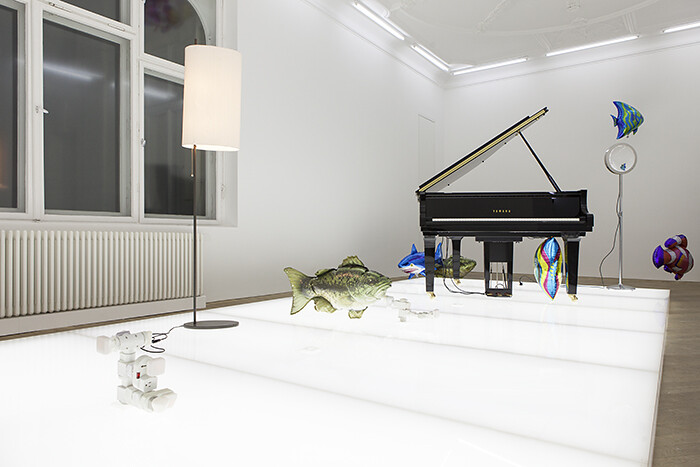
What do things want? The notion of animism is correlated with the problem of agency—who or what can be said to have volition. According to Norbert Wiener, “our consciousness of will in another person is just that sense of encountering a self-maintaining mechanism aiding or opposing our actions.” One can also define animism as a transfer of volition from the animate to the inanimate, through which life and liveliness shift from increasingly inert human bodies to increasingly energetic and inventive things.
Be it because of changes in pressure or temperature, the fish-shaped balloons in Philippe Parreno’s installation Quasi Objects: My Room is a Fish Bowl, AC/DC Snakes, Happy Ending, Il Tempo del Postino, Opalescent acrylic glass podium, Disklavier Piano (2014)—currently on view as a part of Parreno’s “quasi-objects” at Esther Schipper in Berlin—clearly want to escape. Sharks are the cheekiest: on the opening evening, one tried to follow us out, but was promptly captured by the doorman—that was his function, in fact, to make sure no fish would escape the premises. Another was found at the stairwell ceiling, apparently disillusioned with life on the run. The angelfish and the odd carp seemed to better conform, but maybe I am stereotyping.
“Quasi-objects” is …
December 18, 2014 – Review
“The Word Today Serves No One Except To Say To The Grocer Give Me A Pound Of Lentils”
Ana Ofak
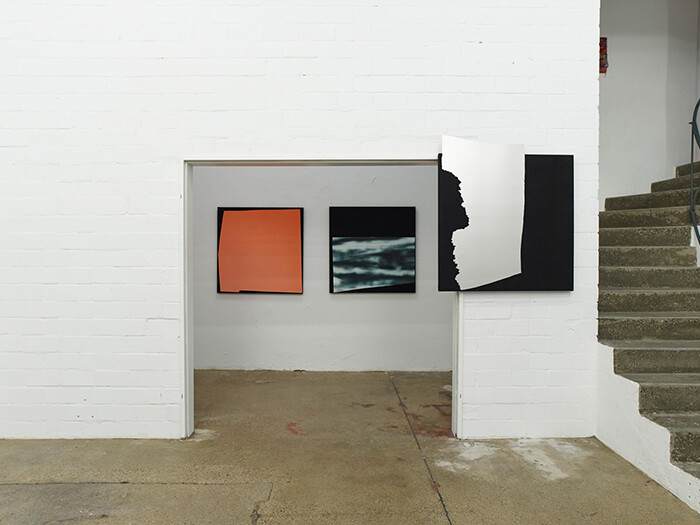
Los Angeles has long been pursuing the economies of pink, but it has been pursuing a phantom. Pink is a non-existent wavelength of light. We cannot perceive it, but literally imagine it. Its features disclose themselves in every BPA-free bottle of pink coconut water, in Lindsay Lohan’s strawberry blonde tresses starring in The Canyons (2013)—Paul Schrader and Bret Easton Ellis’s “acid-etched horror story” complete with a trailer by Kanye West—or ultimately in every smog-induced sunset spectacle off Santa Monica beach. A little bit like Ed Ruscha’s pastel-on-paper work Another Hollywood Dream Bubble Popped (1976), the economies of pink allow the space of representation, not the pictorial space to rule. About that space of representation, Michel Foucault wrote that it transpires “only on the surface, no more than a polished stone, bearing words and shapes: beneath, nothing […] a gravestone.”
Unsurprisingly, the asymptote of these economies runs along a vital art market. Ruscha’s slick aesthetic, boasting sharp edges and lurid gradients, shaped the idiom of pop by cutting through it with L.A. archetypes. In contrast, it is the gonzo debonair attitude of living and working in a garage in early sixties Venice—established by the artists gathered around Walter Hopps’s and Edward Kienholz’s …
October 20, 2014 – Review
“Let The Body Be Electric, Let There Be Whistleblowers”
Stefan Heidenreich
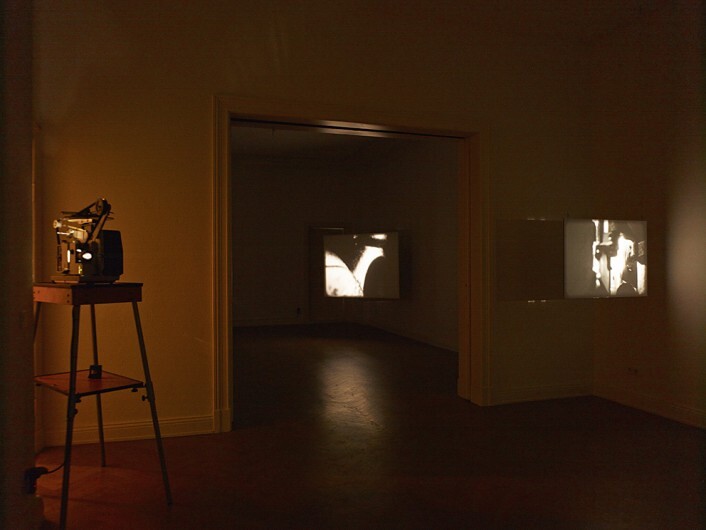
There is a problem facing the history of media: that time can not be represented independently of the technologies of information. We cannot simply write a historical account of technical inventions, because these inventions themselves structure the temporality of events and processes in our world. This is, at least, according to the adherents of media archeology, which, recently, with the appearance of English translations of the work of the media theorist Wolfgang Ernst, has gained some popularity. Using a combination of Foucault’s early writing and media theory, media archeology strives to literally excavate rusted and scrapped parts of computers, radios, or other gadgets—though not from the soil, but from dusty archives and collections of old machinery. Very much like real archeology, media archeology comes with a type of mysticism that positions the archaeologist as an adventurous time traveler. The expression Gleichursprünglichkeit [simultaneous originality] points to the idea that the origins of a technology are inscribed and remain present in it, as if the moment of invention would forever exert its structuring force.
“Let The Body Be Electric, Let There Be Whistleblowers,” curated by Heidi Ballet and Anselm Franke, gets as close to the mysticism of media archeology as can be. As …
September 19, 2014 – Review
abc art berlin contemporary
Judith Vrancken
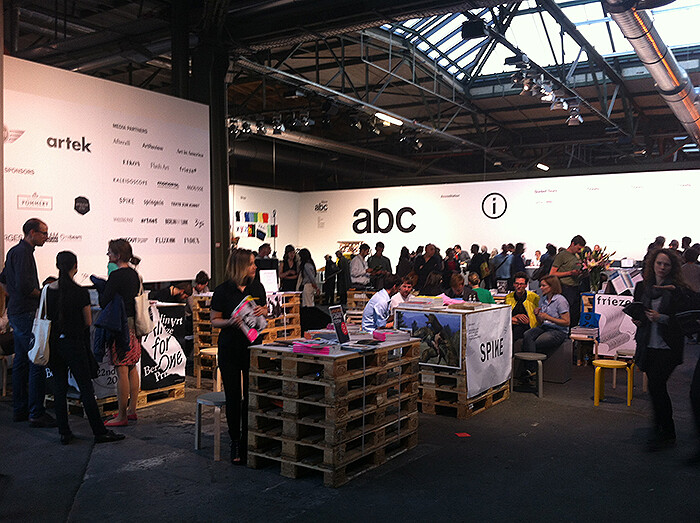
The 7th edition of abc art berlin contemporary, as in previous years, embodies the event of exhibition rather than the collective buying and selling of art. As the fair’s organizers have prominently emphasized, this year includes a vast program of 40 performances, lectures, readings, sound works, films, and theater productions: the fair as a stage.
Some of the exhibited works employ this analogy quite literally. Berlin’s Galerie Buchholz displays an actual stage by Julian Göthe. Black tubing outlines schematic shapes on a starkly white podium, creating architectural depth in its flat structure through a sort of trompe l’oeil effect. On the stage there are two black café chairs seemingly waiting for imaginary actors to sit on them. Or are these actors the visitors themselves?
This question arises on several occasions. For example, for a fair, there is a remarkable number of large-scale installation pieces. However, instead of walking around them, the audience is often invited to walk through them, as in Kerim Seiler’s piece Relay (Situationist Space Program) (2012) at Grieder Contemporary, Zurich. The large, wood-and-steel, house-like construction was originally installed on the roof of the exclusive Crystal Hotel in St. Moritz. It shows a complex of sculptural objects that resemble functional …
September 2, 2014 – Review
Zofia Kulik’s “Instead of Sculpture – Sequences 1968–71”
Karen Archey
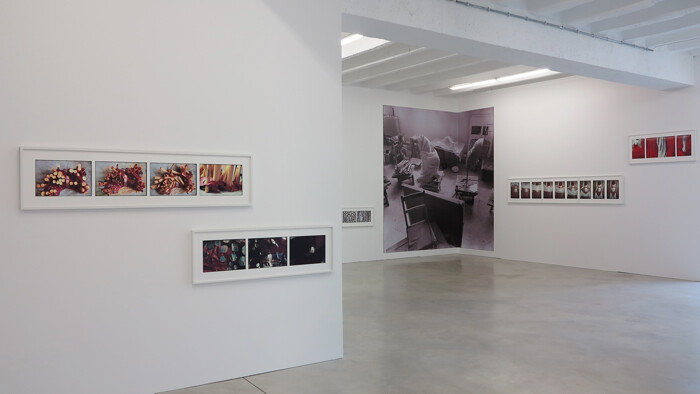
The resuscitation of older female artists’ careers has become so prevalent in recent years that it could now be seen as a trend. Take Etel Adnan (b. 1925), Judith Bernstein (b. 1942), Dorothy Iannone (b.1933), and Maria Lassnig (1919-2014), for example. And yet, we all know how the art world reacts to trends: it hops on board for about 30 months, then eventually disgruntled murmurs start rippling throughout Kaffeeklatches and drunken confessionals. The unusual thing about this trend is that the renewed—or completely new—attention being paid to long-accomplished female artists is almost entirely justified. It could even be thought of as a necessary historical corrective to the systematic elision of female voices from most art-historical narratives. (And it’s another question entirely if there’s a market-based impetus to uncover troves of available works.) However, it’s worth mentioning such a trend, even though doing so potentially conflates the work of these incredibly diverse and deserving artists under a single “New/Old Female Artist” heading.
Enter the incredibly forward-thinking and idiosyncratic work of Polish artist Zofia Kulik (b. 1947), who is currently the subject of a monographic exhibition at Berlin’s ŻAK | BRANICKA. Until now, Kulik has primarily been known for her collaborative work with …
July 30, 2014 – Review
"New Dawn"
Natasha Ginwala
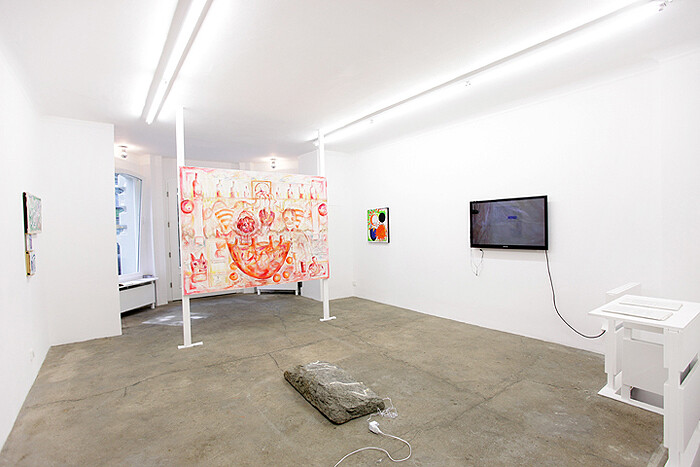
When foraging for food in the wild, orangutans conduct an intriguing ritual known as the “fruit stare.”(1) It unleashes a mimetic contract hinged upon intentionality and co-presence. What makes the tree surrender its fruit? The practiced stare of the orangutan coaxes it into interdependency—and possibly, divulgence—while registering a temporal circuit between hunger and satiation. Earlier this spring, “A Fruit Stare,” Leidy Churchman’s solo exhibition at Silberkuppe, relayed a murky trail of auctioneering, police patrol, and torn legalities. Eliciting an immersive look from the viewer, his work featured fleshy exposures of immanent violence, which mimetically suture culprit and prey.
Following up on this solo show, Churchman has curated “New Dawn,” Silberkuppe’s current group exhibition, which includes commissioned works from a good number of its 27 participating artists, filmmakers, designers, as well as essays by legal scholar-activist Dean Spade and sociologist and queer theorist Craig Willse. Michaela Eichwald’s painting AUKTION fuer Leidy (2014) is spread across the gallery façade, somewhat like a protest banner gesturing toward neoliberal society’s zealous adoption of every location as a potential marketplace, while also serving as a dedication to the artist-curator. This work, and the exhibition as a whole, positions painting as a mode of “performative utterance”—as a …
June 13, 2014 – Review
Geta Brătescu’s “Atelier Continuu”
Ana Ofak
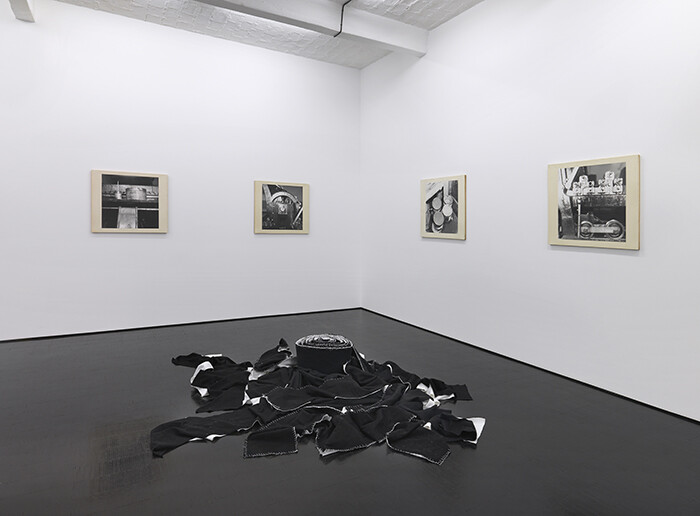
Benno von Archimboldi—the mythical writer in Roberto Bolaño’s 2004 novel 2666—used to draw algae as a child. The meticulousness with which the boy captured the greenish pulp he encountered on his prohibited dives in muddy waters extended into his writing as a grown man. None of this is known to the group of literary critics who devote their lives to Archimboldi. They roam the world in search of snippets of information that might enrich their meager outputs. No institution will ever come to help them. The fictive search mirrors contemporary aesthetic politics in an eerie way. After post-communism fell ill, when ideological etiquettes no longer fit Eastern Europe, the art world’s interest in the region’s manifold visual territories has grown in inverse proportion to the understanding of its context. Due to the homogenization of taste, Eastern Europe appears like a treasure trove, set apart from the corporate consolidation of aesthetics. One wonders if all of its Archimboldis will ever receive the attention they deserve.
Among the artists from Romania, Geta Brătescu (b.1926) is the grande dame of Conceptualism. Her work has established a discreet, object-bound, almost poetic presence in the country and elsewhere. It has been in the spotlight for several …
June 2, 2014 – Review
Berlin Documentary Forum 3
Ana Teixeira Pinto
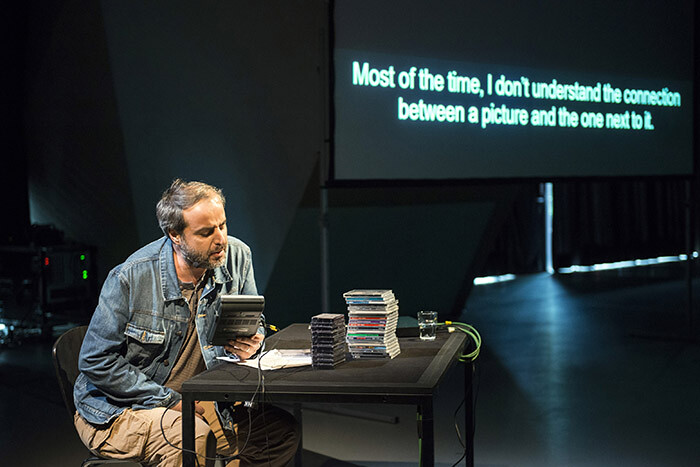
At times, history is anachronistic. Documentary practices define a film genre that existed before the invention of film. In a sense, the documentary impulse was what made film possible in the first place: workers leaving the factory, the rustling of leaves, a train entering the station, or a street scene can all be described as attempts to mobilize an equality of indifference against the hierarchies of representation. As French philosopher Jacques Rancière put it, only when the anonymous became the subject matter of art could the actualités [actuality films]—the act of recording such subject matter—become an art, instead of say a craft or technique. But though temporarily freed from the obligation to erect monuments to authority, the arts of mechanical reproduction emerged with trappings of their own making.
The non-fictional camera came to represent the conviction that unmediated access to reality was not only possible, but imperative—a conviction which peaked with Direct Cinema’s usage of hand-held cameras and synchronized sound (before the 1960s documentary sound was synced in post-production and relied heavily on Foley artists). Direct Cinema however—and one could add, most of the genre—tacitly ignores the conventions of realism, namely the technical synthesis that upholds its claims to observational truth. …
May 29, 2014 – Review
8th Berlin Biennale
Adam Kleinman

Riddled with countless tributaries, a map of the Amazon River and its drainage basin seemingly presents an image far too complex to be used as the basis of a mnemonic device; however, Emma Hart Willard (1787–1870), a radical American pedagogue and women’s rights advocate, turned explicitly to its topography in order to graph the history of the Roman Empire. Whether or not such didactic approaches assist in retaining cultural memory, Willard’s convoluted representation of a “canonical” history might also belie a subversive want and need to drown out reductive narratives. This year’s Berlin Biennale for Contemporary Art—in a vein not dissimilar to this parallel reading of Willard’s work which is featured in “Double Lives,” a kind of exhibition-within-the-exhibition curated by Artistic Team member Natasha Ginwala—ostensibly claims to redress a spate of historical revisionism found in Berlin today; however, it does so in a rather oblique manner.
Aside from the artworks on view, the implications of curator Juan A. Gaitán’s ambitions for the 8th Berlin Biennale can be parsed through his selection of three different exhibition sites: KW Institute for Contemporary Art, Museen Dahlem – Staatliche Museen zu Berlin, and Haus am Waldsee. Key amongst them, however, is the Museen Dahlem, a …
May 19, 2014 – Review
Friedrich Teepe
Judith Vrancken
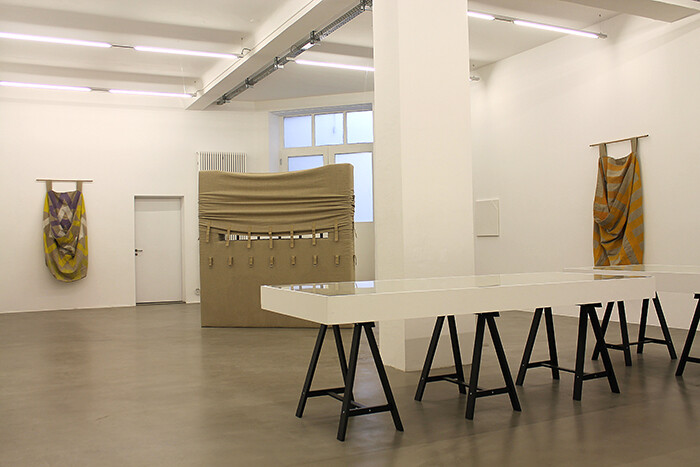
Entering ARRATIA BEER from the back doorway, one encounters a sculptural object, covered in raw canvas and impressive in size. Padded and rectangular, it obstructs the view of the entire gallery. Through its center, which is weighed down by an extra layer of fabric, there is a row of buckles, unfastened. 1980/10 (1980) is raw, uninviting, yet captivating at the same time.
For Berlin’s 2014 Gallery Weekend, ARRATIA BEER invited guest curator Eva Wilson to organize a show of work by fairly unknown, and now late, German artist Friedrich Teepe (1929–2012). The show marks Teepe’s first exhibition in 25 years and his first-ever solo show in Berlin. Though shying away from working exclusively as a professional artist, Teepe never stopped producing art alongside his career as a secondary school teacher in Osnabrück. So what could a young curator’s motivation be for interacting and promoting an artist who voluntarily stayed off the art world radar? Might it be an interest in his successful attempt to maintain a sense of autonomy by steering clear of the competitive art market? Or does this curatorial effort count as an exploration of art on the periphery in hopes of canonizing it?
Working with an artist’s oeuvre automatically …
May 5, 2014 – Review
Gallery Weekend Berlin
Astrid Mania
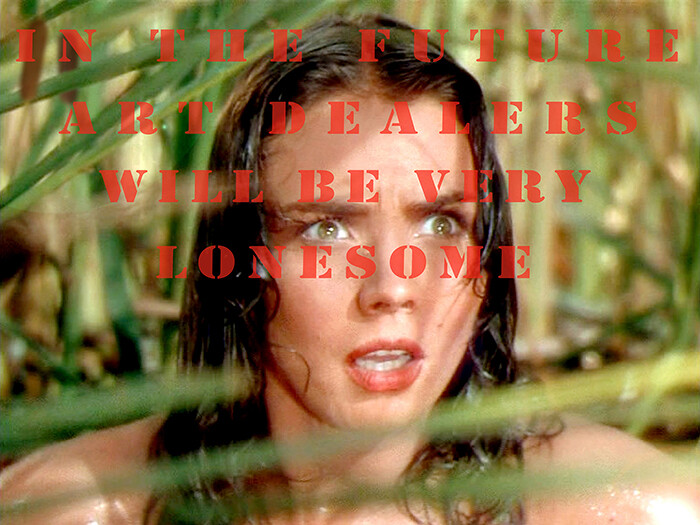
Klaus vom Bruch (b. 1952) is something like this Gallery Weekend’s wicked fairy godmother. Even though he and his gallery SASSA TRÜLZSCH were rightfully invited to participate in the event’s tenth anniversary, vom Bruch’s “In the Future …” series (2008–14) casts some rather sardonic prophesies upon the (art) world. In this utopia/dystopia, prospects are pretty grim for everyone. But after a tour around the galleries, you really hope he’s wrong, especially when he posits: “In the future art dealers will be very lonesome.” As in Berlin, it is still the dealers that dig out the treasures of recent art history and stage positions that you don’t see (enough of) in public institutions.
Just take the wonderful Zofia Kulik (b. 1947). ŻAK | BRANICKA made photographic prints from her 1970/71 diploma work, which were originally 35mm slides. Demonstrating the artist’s early and rigorous turn towards an art that takes the body as its material and starting point, this exhibition titled “Instead of Sculpture – Sequences 1968–71” features work made at a time when her native country of Poland was still under communist rule, and so was the art. Or Geta Brătescu (b. 1926) at Galerie Barbara Weiss who, under the rigid Ceaușescu …
April 10, 2014 – Review
Derek Boshier’s “Change”
Ana Teixeira Pinto
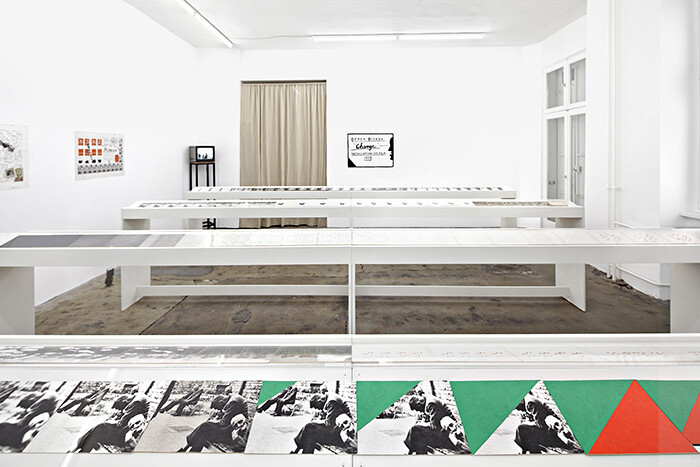
Before it became a commercially viable mode of artistic production celebrating the hegemony of the market over the social, Pop was—albeit briefly—an art of critique. When popular mass culture motifs where first adopted by contemporary artists in the early-1950s, they seemed to announce a revival of Dadaism. For Eduardo Paolozzi, the Independent Group, and Richard Hamilton, photocollage—a technique Dada invented—was the main mode of Pop production.
Emerging out of the horrors of trench warfare, Dada’s emphasis on rupture was not a mere aesthetic gimmick. Whereas the photographic montage commonly used in Victorian fantasy postcards fused all elements together to create an illusion of continuity, the Dadaist photocollages—which as Walter Benjamin noted, typically interrupted the context into which they were inserted—made the artifice visible by fully displaying the sutures and cuts to which their images were subjected. Reciprocating the lacerations inflicted by mortars and barbed wire, photocollages make manifest that the present is composed of manifold irreconcilable states—that every actual thing is a tangible unity of opposed determinations.
Derek Boshier—whose current exhibition at Tanya Leighton Gallery constitutes his first solo show in Berlin—belongs specifically to a British Pop tradition, which is to say, his work is perhaps closer to that of contemporary British …
March 5, 2014 – Review
“how to write III | artists read their texts”
Kirsty Bell
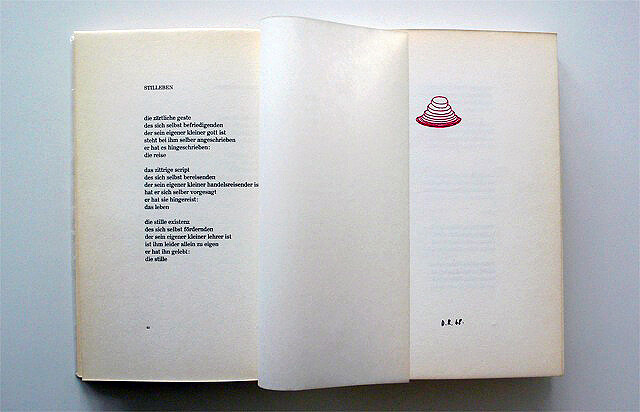
Even for art audiences who are by now used to all kinds of dematerialized art objects—performers in lieu of objects or sets of instructions replacing lists of media—this exhibition of four artist-writers at Galerie Wien Lukatsch sets the bar high. It consists solely of recorded voices with no visual props whatsoever, posing a challenge to attention spans atrophied by the constant state of distraction that appears to be the new norm.
There is nothing to see here but the walls and windows, radiators and parquet floors of Wien Lukatsch’s third floor apartment gallery, barely furnished with folding metal chairs, tatami mats, and speakers. Stripped of visual distractions, each separate room—dedicated to a single artist reading texts aloud—feels more like a West Berlin doctor’s office than an exhibition space. But what kind of ailments could be treated here? Chronic synaesthesia? Terminal Fluxus Wortspiel? As the spoken words evaporate in the surrounding air, language seems almost impossible to grasp, and meaning even more so. Most apparent, however, was the pointed absence of the speakers themselves, all of whom passed away in the past forty years.
Born in 1928, 1930, 1943, and 1925 respectively, Arthur Köpcke, Dieter Roth, Tomas Schmit, and Emmett Williams were contemporaries, …
January 31, 2014 – Review
Nina Beier’s “Office Nature Nobody Pattern”
Ana Teixeira Pinto
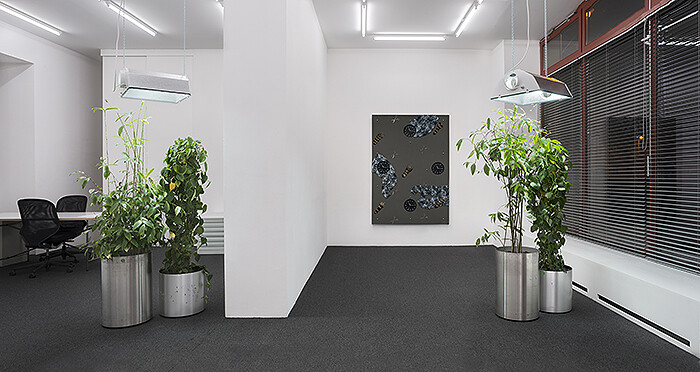
Remember Spellbound? In Alfred Hitchcock’s 1945 thriller, Gregory Peck stars as an amnesiac patient whose dreams were famously designed by Salvador Dali. Scissors, eyes, curtains, faceless men, decks of cards—a whole panoply of Surrealist tokens parade before the piercing intellect of Dr. Constance Petersen, played by Ingrid Bergman. Conflating Sigmund Freud and Sherlock Holmes—as Hollywood always does—she approaches the dream sequence as if it were a forensic theater whose clues, once properly deciphered, will identify the murderer. A contorted wheel stands for a gun barrel, while two parallel lines symbolize snow tracks, culminating in the big reveal: it was the hospital’s director, behind the chimney, with the revolver.
Nina Beier’s “Office Nature Nobody Pattern” at Croy Nielsen also plays with the unequivocal literalness of psychoanalytic symbols. In what one could call a portrayal of the “office unconscious,” the gallery’s off-white floor is covered in grey industrial carpet topped with large potted plants—which the artist, in collaboration with Simon Dybbroe Møller, repurposed from the auction of a bankrupt Danish bank’s assets. These stand under hanging lights, and PVC blinds cover the wide window. Aside from some vegetable crates, half-spilled, in the entrance, the room looks like an anonymous bank branch. Hung at …
January 9, 2014 – Review
Natalie Czech’s “I Cannot Repeat What I Hear”
Kerstin Stakemeier
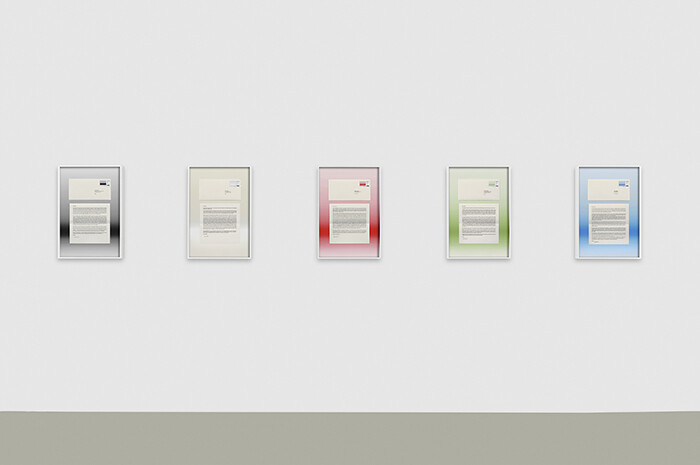
Natalie Czech’s first exhibition at Capitain Petzel is an exemplary case of thought rendered in the medium of photography. In her series “Poems by Repetition” and “Voyelles” (both 2013), Czech employs photography as a means of inhabiting a range of artistic literary genres—poetry, journalistic media, lyrics from popular music, and epistolary writing. Reaching beyond the modernist idea of a given genre’s imperative to immanent progress, she creates photographic works that are derived from text-based sources, and simultaneously diverge from strict photographic formalisms. The exhibition’s title, “I Cannot Repeat What I Hear,” stresses the visual embodiment of language against its audible forms.
Voyelles I and II (2013), shown in the upper gallery, each consist of five works. Here, Czech seems to test out a transfer of written synaesthesia into photography. The series title is taken from Arthur Rimbaud’s 1871 sonnet, which begins with the line: “A noir, E blanc, I rouge, U vert, O bleu: voyelles.” Assigning a color to each vowel, Rimbaud ferociously spelled out seen, felt, and lived intensities in the poem, expanding on those five synaesthetic modalities in its subsequent lines. Czech asked ten different authors, poets, curators, and artists to each write a one-page letter to themselves in …
December 4, 2013 – Review
"REMEMBER EVERYTHING: 40 Years Galerie Max Hetzler"
Kito Nedo
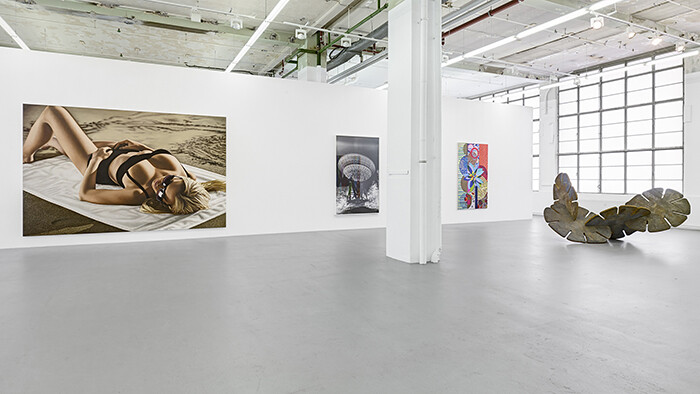
If someone ever wished to consider the effects of German reunification on the commercial art scene after 1990, Galerie Max Hetzler would make a perfect case study. Hetzler, who had already opened his first gallery in 1973 in Stuttgart, played a central role as an art dealer in Cologne during the 1980s before relocating his business east to Berlin, the new “old” capital, in 1994. During his decade in Cologne—at that time arguably the most important city for contemporary art in West Germany—Hetzler introduced the work of Jeff Koons to the German public, and the gallerist’s name became synonymous with the predominantly male artist-crowd orbiting around Martin Kippenberger and Albert Oehlen (“the Hetzler Boys”). Despite Hetzler’s relocations and the reshuffling of his program over the years, his business has endured. True to its origins, today Hetzler remains a gallery constantly on the move—a venerable standby where, over the years, the art of constant change has been quietly perfected. Case in point: this fall the gallery inaugurated not one but two spaces in the old and traditionally bourgeois western Berlin neighborhood of Charlottenburg, and next spring will see the opening of a new Hetzler satellite in Paris’s Marais district.
With a treasure …
November 14, 2013 – Review
Adrian Ghenie and Navid Nuur’s “On the Road to … Tarascon”
Judith Vrancken
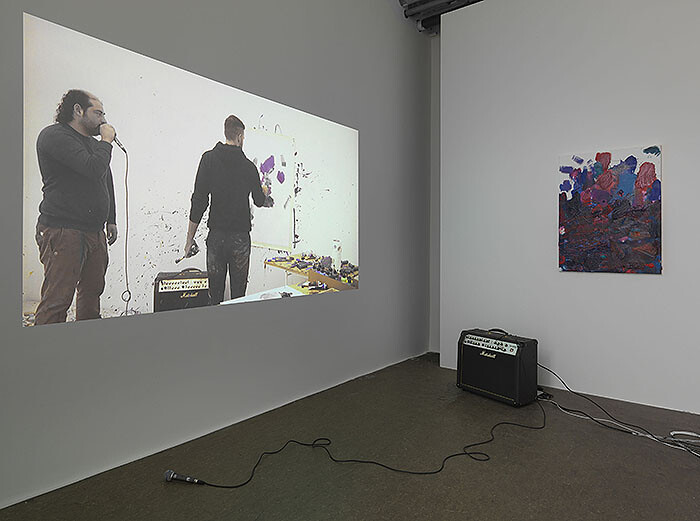
Two artists stand in a studio. One holds a brush, the other a microphone. Romanian painter Adrian Ghenie(1) feverishly walks back and forth between the canvas and his palette and seems completely undisturbed by the pervasive vocal interpretations Dutch-Iranian artist Navid Nuur makes of his rude brushstrokes. This work, The Possibility of Purple (2013), documents the making of five paintings in five separate videos, all approximately thirty minutes in length. Everything is shot from the same angle. Ghenie taps, draws, throws, and smears thick layers of red and blue paint on the canvas while Nuur growls, howls, and occasionally creates cartoon-esque “blub!” noises in response to each of Ghenie’s gestures. Yes, it’s very entertaining to watch, but above all, the extensive film turns out to be the key piece in this elaborate, two-person exhibition “On the Road to … Tarascon” at Galeria Plan B, which encompasses painting, video, performance, and sound. Transformed into a small replica of the video scene, the gallery space incorporates one of the paintings from the video series on the back wall; the microphone and Marshall amplifier that Nuur used is positioned to its left, and Ghenie’s white paint-mixing stand to the right.
For an exhibition that …
September 20, 2013 – Review
abc art berlin contemporary
Kito Nedo
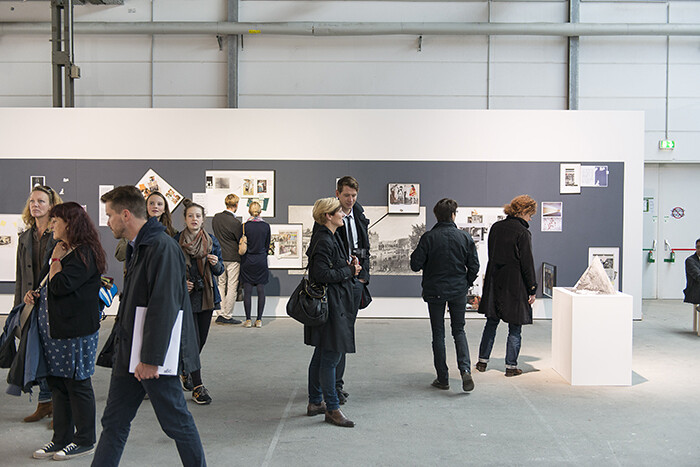
Considering that Berlin’s abc art berlin contemporary is only in its sixth year of existence, it already has a colorful past. Established by a small group of Berlin-based galleries in 2008 as an alternative to the more traditional (and waning) Art Forum Berlin art fair, it is now the center of the so-called Berlin Art Week, but still struggling to define its inner balance between commercial and cultural ambitions.
Case in point: the organizers continue to cautiously avoid the term “fair,” stressing the openness of the exhibition format instead. As the newly-appointed director Maike Cruse put it in an recent interview: “We still do not call abc an art fair as from the beginning it was our intention to develop an alternative more artist centered format and because we are a private initiative run by a small structure and tight budget and are not owned by a fair company or an investor.” In the past, abc did work with curators, such as Ariane Beyn (2008) or Marc Glöde (2011), but the engagement of Cruse marks another level of professionalization. The stamp of this former communications manager for Art Basel and sometime curator is instantly recognizable: Cruse gave the whole event, which …
July 24, 2013 – Review
"Double Bound Economies"
Stefan Heidenreich
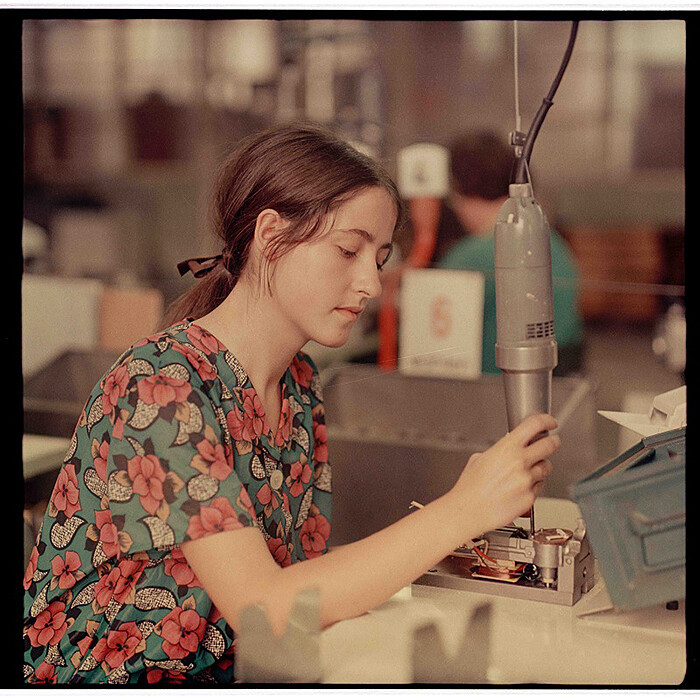
In the former German Democratic Republic (GDR), freelance work was tolerated in just a handful of professions. Reinhard Mende was one of the few who worked as a freelance photographer and his career nearly spans the life of the GDR as a state. His independence might be the reason his vast body of work remains intact. While many institutional archives were abandoned or destroyed after the fall of the Wall, private collections had a better chance of survival.
One of Mende’s regular jobs was to document the Leipzig Trade Fair, at that time the crucial hub for showcasing East Germany’s industrial production and, more importantly, selling it to the West for hard currency. His work around the fair included documenting official visits, depicting the products on display, and doing reportage work on production facilities. The worker’s portraits would afterward often be used for displays at the fair (and they occasionally reappear in the background of some of his pictures). To us, portraits of workers in factories placed next to the finished product look awkward; imagine seeing a picture of a Chinese assembly line at Foxconn next to an iPhone in an Apple store. Unthinkable, as it would be immediately associated with …
July 10, 2013 – Review
Amalia Pica’s “Low Visibility”
Ana Teixeira Pinto
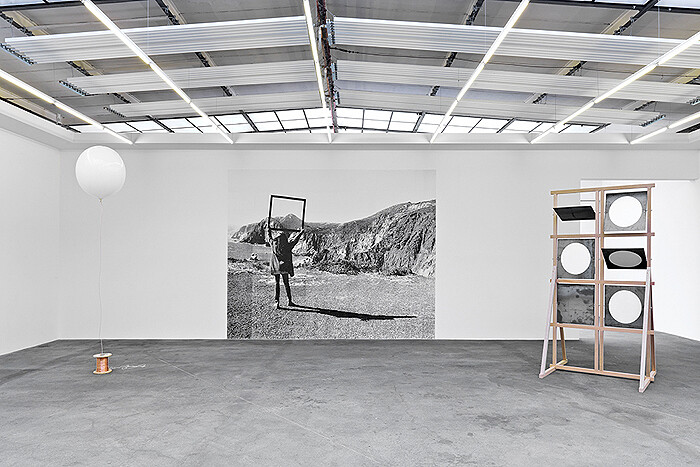
Strictly speaking, you cannot interpret information; you can only decode it. Information is technical in nature; it concerns the precision with which a series of symbols are transmitted across a medium. These symbols can consist of anything—black font on paper, electrical pulses, colored flags.
“Low Visibility,” the first Berlin solo show by Argentinean artist Amalia Pica, revisits several outmoded information technologies—a recurring theme in Pica’s work. Shutter Telegraph (as seen on TV) (2013), recreates a shutter telegraph, one of the methods for optical communication that preceded the invention of electrical telegraphy. Also known as the Chappe telegraph after its inventor Claude Chappe, who devised it in 1792, or the Napoleonic Semaphore, the telegraph operates through the use of pivoting shutters or blades, placed atop a transmitting tower. Though the system was extremely successful in conveying intelligence—at its height, France had 556 telegraph stations—it had obvious atmospheric limitations. The gallery’s staff, unschooled in Morse code, is supposed to operate the shutters during the show, producing inevitably incoherent messages. Information is a measure of the freedom of choice, which is available when aligning a string of symbols. If I choose to start a sentence with “the,” chances are a noun will follow. The …
June 21, 2013 – Review
Özlem Altin’s “Cathartic ballet”
Federica Bueti
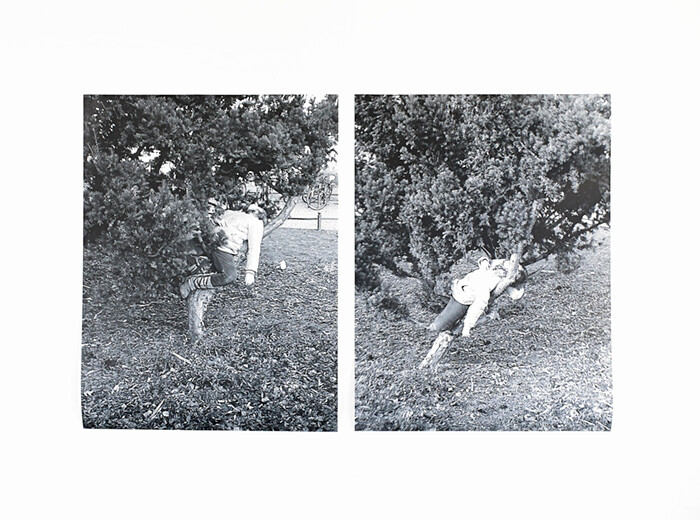
This is a silent party. Many guests have come here to celebrate the spring equinox. Spirits and things are freely circulating in the space. This is how it feels when entering Özlem Altin’s exhibition “Cathartic ballet” at CIRCUS. All is still, a perfect silence, yet something is happening.
At the entrance, the first “guest” you meet is Untitled (Mädchen im Baum) (2013), two black-and-white photographs of the body of a woman entangled between the branches of a big tree. Her legs clasped around the trunk, the head bent over, the torso stretched out as if in a gymnastic exercise. The images capture the figure from two different angles, two reverse perspectives: front and back. Rest and exhaustion. Comforting and disturbing. In this unnatural pose, hooked onto a tree, the figure looks like an abandoned object, her body torn like that of a broken doll. A doll on a tree like a body as a thing amongst things. It produces a sense of estrangement-empathy.
Altin has transformed the neutral space of the gallery into a place crawling with doll-like humans, human-like gestures, objects-like-poses, and bodies-like-rhythms that respond to each other and perform in synch to set the whole space in motion. Everybody is …
June 5, 2013 – Review
Eva Kotátková’s “They are Coming”
Kirsty Bell
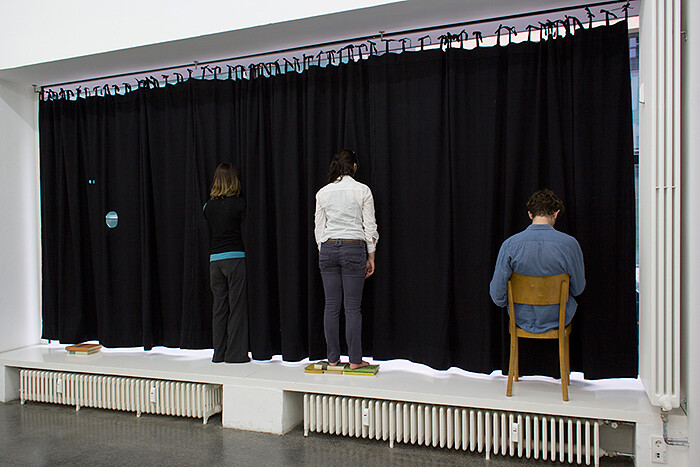
Passers-by who found themselves at the farthest reaches of Berlin’s Friedrichstrasse in late April may have been surprised to notice an array of animated body parts on display in a shop window. A pair of eyes, a pair of hands, a face, an arm, two knees and their feet protruded from a black curtain screening off the window. As an introduction to Eva Kotátková’s second solo exhibition at Meyer Riegger, the performative installation, Fragmented Body 1 (installation for a performance) (2013), paid tribute to the long-standing tradition of Prague’s National Black Light Theater Company, and spoke of the potential of gesture and the surprising liberation of physical fragmentation. For those who entered the gallery, however, the pantomime was quickly over, as the performers were revealed from the back in all their ordinariness, standing on the low window ledge with various limbs poking through holes in the black curtain. But in turning the window ledge into a stage, the gallery visitors were at once in the privileged position of being backstage. As a result, the other sculptures on show, such as the Theatre of Speaking Objects (black theatre props) (2013), on a platform which took up the entire floor space of …
May 15, 2013 – Review
Henri Chopin’s “La Crevette Amoureuse”
Vincenzo Latronico
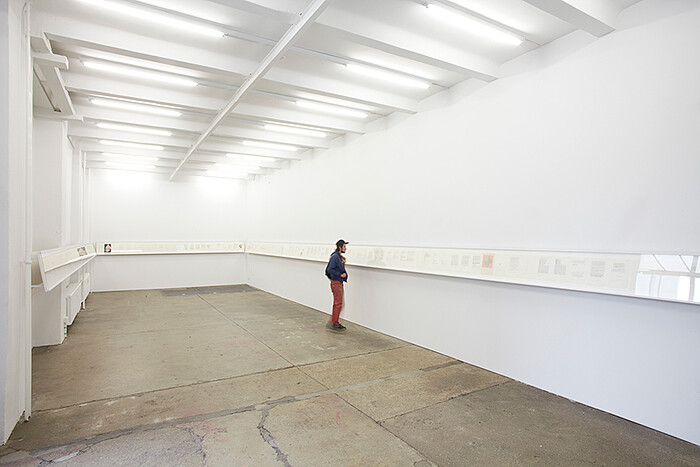
The traditional form of the novel, as we know it since the nineteenth century, seems oddly impervious to change. In comparison to the extraordinary evolutions undergone by art, very little has changed between today’s mainstream fiction and its Balzac, Austen, and James equivalents. Most of the novel’s purported evolutions have either proven to be barren (as Julio Cortázar’s 1963 Rayuela, a masterpiece which left in its wake a string of choose-your-own-ending fictions) or resorted to the more or less forceful insertions from other disciplines: pictures, traditionally, or sound and video in their most recent tablet incarnations. A text-based fiction, it would seem, has few places to go except where it already is.
This state of affairs is both questioned and affirmed by the work of the late Henri Chopin, whose, well, novel, La crevette amoureuse [The loving shrimp], (1967/1975)—is on show in Berlin at Supportico Lopez. Throughout most of the twentieth century Chopin has been a prominent experimental poet and performer (born in Paris in 1922, he remained productive until 2008, the year he died); one of the first and most prolific practitioners of concrete and sound poetry, Chopin was also a publisher of journals such as Cinquième Saison (1959–1963) and …
May 6, 2013 – Review
Aleksandra Domanović’s “The Future Was at Her Fingertips”
Stefan Heidenreich
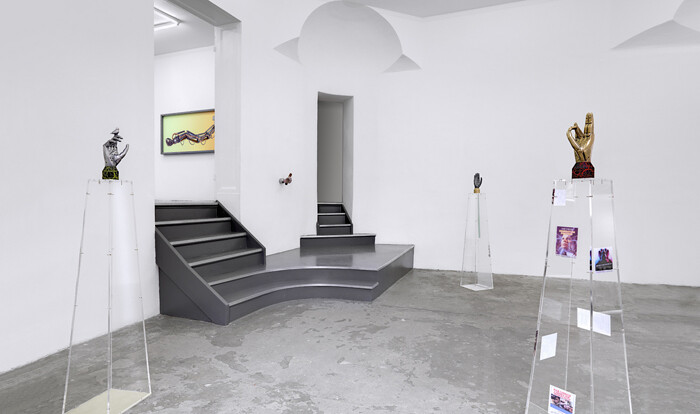
It was in 1843 that Ada Lovelace, daughter of Lord Byron and a friend of Charles Babbage, sketched out a concept for machine calculations. Today she is considered the first computer programmer. Lovelace’s claim to fame comes as the first entry in a timeline that is given as a handout to accompany Aleksandra Domanović’s exhibition.
“The Future Was at Her Fingertips” reads the title of the show, which leaves us with two questions: one is a matter of time, the other of agency. As the future “was,” is it now over? Or did it never happen? Furthermore, having had it at her fingertips, did she ever manage to grab it? Or did she let it escape? One thing is certain: we know from the phrase that it was a woman’s future.
In 2012, Domanović did an interview with the Slovenian computer scientist Borka Jerman Blažič. Back in 1991, Blažič had registered the domain .yu and introduced the first Internet services to the then Yugoslavia. One year later, the country began to violently tear itself apart. Domanović was born in the former Yugoslavia, in the Serbian city of Novi Sad, but grew up in the part of the country which later became …
April 29, 2013 – Review
Gallery Weekend Berlin
Kimberly Bradley
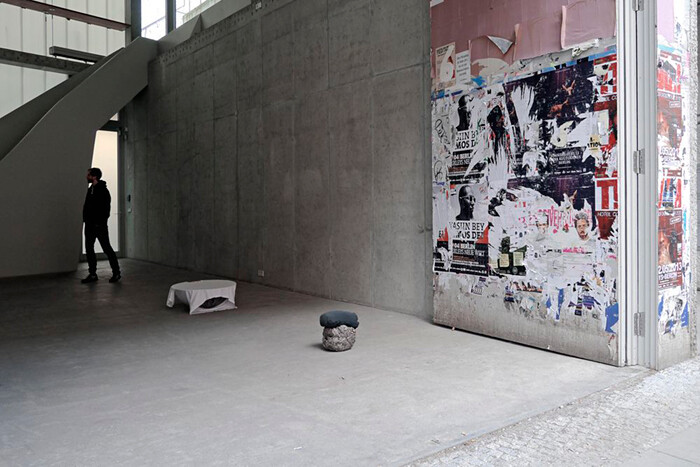
Berlin’s been looking downright spiffy lately. Design hotels (to host the import-export set), shiny office buildings (populated by “for rent” signs), and self-important artisanal coffee shops keep popping up. There’s a new Waldorf-Astoria. People dress better. These days, when you call a restaurant, store, or gallery, someone actually answers.
It wasn’t always this way. Berlin in general is “professionalizing” (though I hate that word) and gentrifying (so what else is new?), and its art world is no exception. For the first time in its nine-year history, Gallery Weekend Berlin—an event founded by a small group of gallerists to lure international collectors to the city for a springtime weekend—has appointed a general manager (the affable Cédric Aurelle). This year, nearly sixty drivers in black BMWs spirited VIPs from gallery to gallery. The fifty-one exhibitors ranged from emerging to established. It’s hard to quantify how many art lovers the event now draws, but “we think there were about 10,000 people here altogether,” Aurelle told me as he emerged on Saturday afternoon from the gallery VeneKlasen Werner, looking as if he’d just come from a calming spa treatment. Professional indeed.
As a local, it was the first time I’d done the whole (okay, almost whole) …
April 1, 2013 – Review
Ed Atkins’s “Warm, Warm, Warm Spring Mouths”
Kirsty Bell
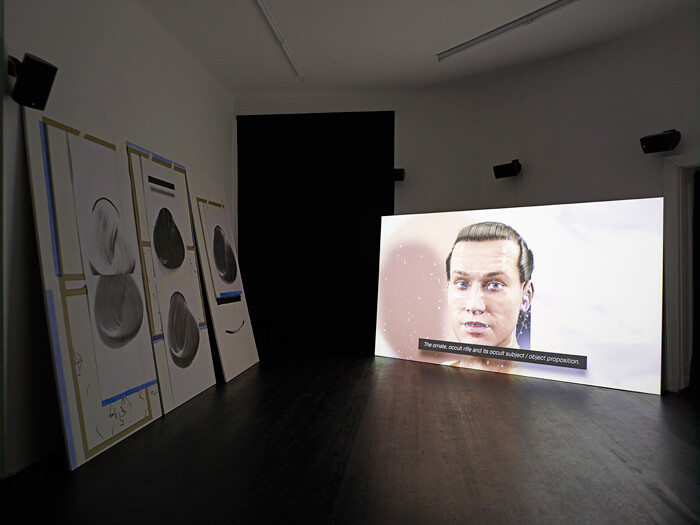
If you are looking for an artist who really confronts the so-called “Digital Divide” and asks “what it means to think, see, and filter affect through the digital” (to quote from a critical dispute that recently played out in the pages of Artforum), then British filmmaker Ed Atkins is your man. Born in 1982, he has age on his side when it comes to relating to the digital experience and its effects. The pair of films on show at Isabella Bortolozzi, Paris Green (2009) and Warm, Warm, Warm Spring Mouths (2013), parenthesize a four-year development. During this time, Atkins has moved from a production process still rooted in the real world (real-time footage of recognizable things) to its total consumption through the technological possibilities of the digital (all imagery now being produced within the interface of the computer.)
As tactile as its title may be, the new work, Warm, Warm, Warm Spring Mouths (2013), pictures the digitalization of existence from the inside, in all its cold alienating surrogacy. We see the head and taut, muscular torso of a man sitting on a chair in a digital no-space, with a mane of incredibly long straight hair, sometimes combed right over his face …
February 25, 2013 – Review
Karl Holmqvist’s “EQ UI LI BR IU M”
Ana Teixeira Pinto
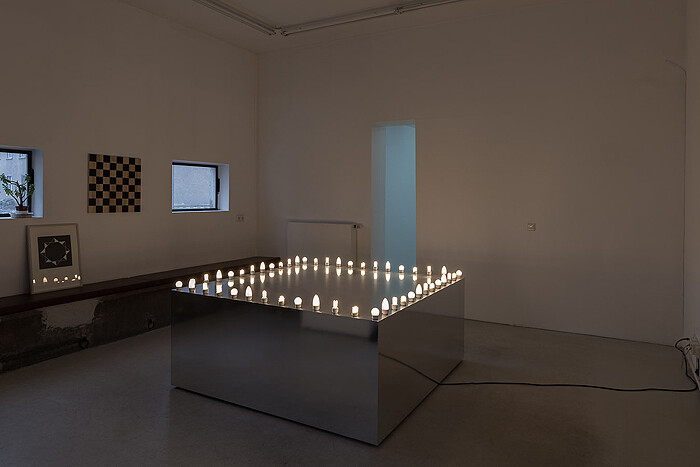
Repetition, as a meaning-production device, is overrated. Especially if you just spent half an hour on the subway on your way to see it. Karl Holmqvist’s latest solo show is two shows, or rather Karl Holmqvist’s two solo shows are one show, depending on your take. The two Berlin venues staging “EQ UI LI BR IU M,” Galerie Neu and MD72, are stocked with identical pieces: the same video, identical checkerboard paintings, and similar sculptures (with just slightly different dimensions and small variations in work titles). When it comes to Holmqvist, viewers often wonder whether his unassuming art works amount to a pop gesture or a poetic one. Or both. But Pop poetry is an oxymoron.
A is for A=R=A=K=A=W=A (2012)—a single-channel video showing mostly subtitles on a black background, read aloud by the artist in his trademark impassive style—is a succession of throwaway lines craftily lined up to never reach the punch. The text is composed mostly of stock phrases, generic formulations, advertising tropes, and hip-hop lyrics, whose strident flutter contrasts with Holmqvist’s deadpan rendition. The more boisterous catchphrases seem caged, penned down under the weight of lethargy, their shrieks benumbed. “Fitness first” (the name and slogan of a famous …
February 4, 2013 – Review
Gorgona’s “Please Attend”
Mara Traumane
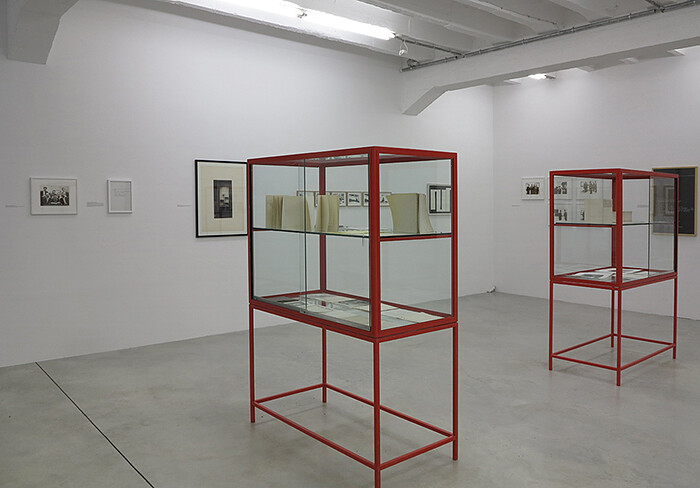
The current exhibition at ŻAK | BRANICKA introduces visitors to one of the most elusive and imaginative phenomena of the Eastern European neo-avant-garde: the creative quests of the Croatian artist group Gorgona. The show is indicative, indeed, of a new stage of recognition of regional avant-gardes from the 1960s–1970s, with exhibitions of Romanian artists Geta Brătescu and Paul Neagu (at Galerie Barbara Weiss) and Ion Grigorescu (at Galerija Gregor Podnar) to be seen in Berlin recently, posing questions, likewise, about productive ways of reconciling radical artistic gestures that were almost always conceived in disregard of the art market. In this respect, the exhibition “Please Attend” is an interesting case study.
Active between 1959 and 1966 in the former Yugoslavia, specifically Zagreb, Gorgona was made up of a group of loosely associated artists: Marijan Jevšovar, Julije Knifer, Đuro Seder, Josip Vaništa, and Ivan Kožarić; an architect, Miljenko Horvat; and art critics Dimitrije Bašičević (aka Mangelos), Matko Meštrović, and Radoslav Putar. Following the wave of contemporary formal and perceptual explorations of proto-conceptualists such as John Cage and Yves Klein, Gorgona’s invigorating creative search was injected with a good dose of tongue-in-cheek humor stemming from Dada and Surrealism. In fact, Gorgona anticipated some aspects …
January 18, 2013 – Review
Omer Fast
Maia Gianakos
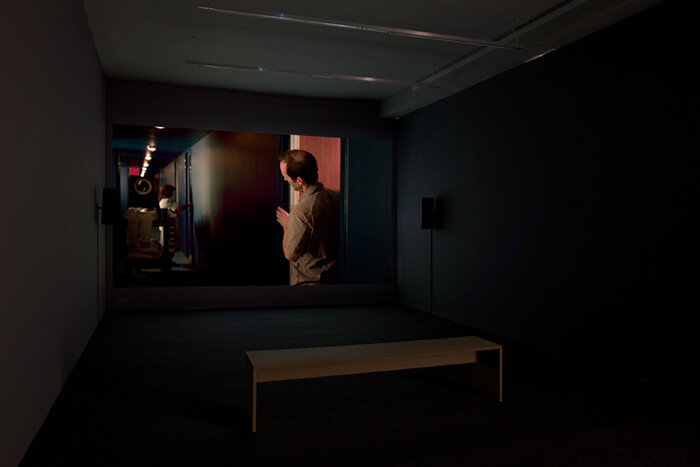
In a world mediated by images, where the brutality of remote events is diluted by means of oversaturation and repetition, how does the real endure? And in the space of the cinema, where narratives are taken as spellbinding truths, what constitutes the real? When entering into the cinematic contract, we often abandon ourselves to fiction, falling into a suspension of disbelief that prioritizes one reality over another. This tacit agreement is the very substance of 5,000 Feet Is the Best (2011) and Continuity (2012), two films by Omer Fast on view at Arratia Beer that focus on the topic of war—a reality that transcends cultural divisions and dominates the collective global conscience—to expose structures of representation and the dissemination of information.
Installed in opposite corners of the gallery’s exhibition space, the two films are separated by walls whose bare supports remain visible, a practical decision that conveniently echoes the pivotal structural reveal taking place within each filmic narrative. First shown at the 2011 Venice Biennale, 5,000 Feet Is the Best stems from a series of conversations Fast conducted with a US Air Force Predator drone operator, who reflects on his daily duties and the psychological effects of live-fire missions in Pakistan …
December 19, 2012 – Review
“Believers”
Kirsty Bell
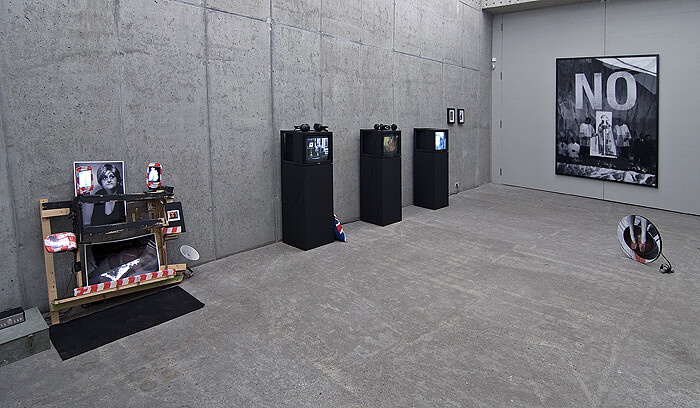
What does it mean to be a believer or a non-believer? Is belief essential for society’s wellbeing or is it merely divisive? And is there an alternative to this antagonistic binary opposition? The group exhibition “Believers” at Berlin’s KOW sets these questions and more in motion.
The notion of belief is, of course, most usually associated with religion and the exhibition takes this as its starting point: Santiago Sierra’s NO (Pope) (2011) a large-scale photograph in which the Pope is framed by the large projection of the word “NO” immediately greets the eye, as do works by that most garrulous of blasphemers, the late Christoph Schlingensief. In his Little Shrine (2006), images of an actress playing Princess Diana become stand-ins for an absent deity. Meanwhile, excerpts taken from an eight-part series he made for MTV, U3000 (2000), shot on board the Berlin U-Bahn, have Schlingensief himself center stage as moderator/provocateur. We see him here, face smeared red, in the throes of a voodoo-like frenzy and random trouser dropping, while interviewing fellow passengers. Ritualized improvisational chaos replaces the self-conscious codes of youth programming. Next to this, a monitor plays YouTube footage of Pussy Riot’s “Punk Prayer,” the band’s notorious impromptu performance in …
September 18, 2012 – Review
Mai-Thu Perret at Galerie Barbara Weiss, and Berlin Art Week Highlights
Ana Teixeira Pinto
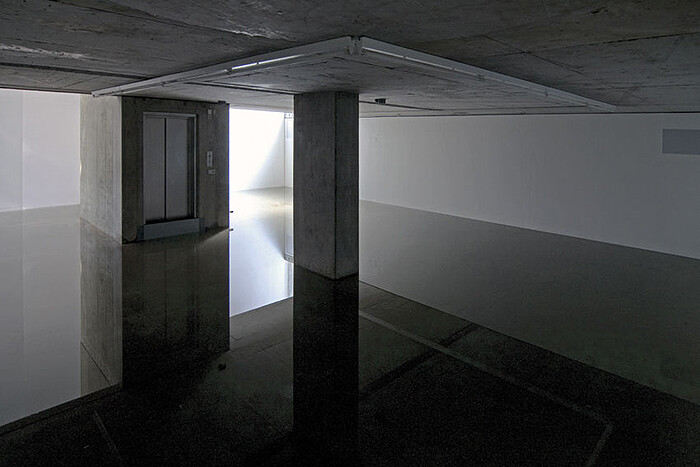
Brought to you by Kulturprojekte Berlin, the producers of last year’s “based in Berlin” survey, Berlin Art Week is a mayoral initiative funded by the Senate Chancellery for Economics and the Senate Chancellery for Cultural Affairs, which seeks to make up for the loss of the ill-fated Art Forum Berlin by labeling the week around abc (Art Berlin Contemporary) as if some sort of extra cultural activity is actually taking place. Most of the city’s institutions are listed on the Art Week’s website, but for anyone who lives in the city, it feels rather paltry to see announcements featuring shows which opened weeks, even months ago, re-branded to sound brand new. It would seem that pretty much everything else in the city, which is being radically redesigned for the benefit of the leisure classes, is being marketed to the occasional tourist or the potential investor.
But to begin rather with a nuanced comment on the city as a haven for real estate speculation, we recommend seeing how architect Arno Brandlhuber flooded the basement of his own signature building on Brunnenstrasse for the show at KOW, “Im Archipel,” which runs concurrently at n.b.k. (Neuer Berliner Kunstverein), in one of the few de …
September 14, 2012 – Review
abc—art berlin contemporary
Astrid Mania
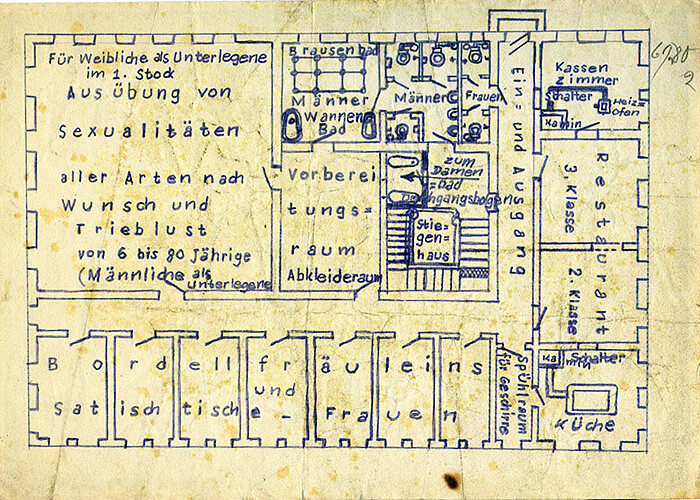
Many find the enigmatic or a little game of playing coy just irresistible. And what attracts people in humans also goes for, well, things arty. Why else would the question of whether abc—art berlin contemporary—is an art fair or not come up over and over again, since its foundation five years ago? This year’s opening press conference attempted to resolve this mystery once and for all: apparently, abc is a “new format” and a “private initiative,” or so say executive directors Alexander Schröder and Guido Baudach. In their words, abc is not a fair, as it is not embedded into a corporation or overarching fair organization. But regardless of whether it qualifies for the label “fair” or not—this year, abc is an attitude. It is a reflection, or rather a conjuring up of a particular Berlin spirit. Casual, cool, chaotic, international. Different.
Being different is key to abc. Not only is its organizational structure distinct from that of a “proper fair,” but so are its appearance and its concept. Founded by nine Berlin-based galleries as an alternative to the art forum (Berlin’s contemporary art fair, which after a fifteen year-long run, called it quits last year), abc came in the guise …
July 8, 2012 – Review
Yona Friedman’s "handbuch"
Kimberly Bradley

Seeing Yona Friedman’s tight, unpretentious exhibition Berlin is like scoring a perfect set of Cliffs Notes, a cheat sheet, to the oeuvre of a visionary thinker, avant-garde theorist, offbeat urban planner, and reluctant utopian.
The exhibition’s title “Handbuch” means “handbook,” and that’s exactly what this is: a how-to compendium of Friedman’s ideas and musings running through several decades and an overview of his mandate for people to think and act for and by themselves in civic situations and life in general. Friedman was born in Hungary in the late 1920s, fled to Israel to escape the Nazis, and relocated to Paris in the late 1950s. His oeuvre dates (mind-bogglingly) to that time—his seminal manifesto “L’Architecture Mobile” and the concept of La Ville Spatiale (Spatial City) were, after all, both published in 1958, proclaiming that architecture and city structures are merely a framework for human creativity and living. Friedman’s prescient concepts have inspired urban planners, architects, and artists ever since—Danish architect Bjarke Ingels, for instance, immediately comes to mind.
At Chert, visitors immediately encounter Friedman’s manuals (ah, handbooks) on display on the gallery’s front table. Using storyboard-like cartoons with pithy captions, the three thick volumes cover overreaching topics like urbanism, dwelling, and “thought,” …
May 21, 2012 – Review
Mark Dion’s “Twenty One Years of Think in Three Dimensions”
John Beeson

The title signals the conditions: the exhibition constitutes a loose survey of Mark Dion’s sculptural production dating back more than two decades. And, as evidenced by the ten three-dimensional works, Dion has arranged a world of found objects into scenarios investigating our reality in literal ways. But this description falters: “our reality” is a bit of a stretch, since Dion’s references span fields both broad and narrow—including primarily environmental but also social, political, and art-specific issues. Although the subject matter can feel a bit cumbersome for viewers attuned to sculptural traditions that use found objects in more abstract ways—either in terms of assemblage’s hectic reorganization of materials or the readymade gesture’s transformative effect on use and value—it can nevertheless be said that Dion has taken his responsibility as a critical member of society seriously and that his work, in some moments, offers curious aesthetic expressions.
Vocabulary Lesson for an Election Year (1988), the earliest work in the show, best exemplifies how Dion runs the risk of pedantry; however, the work could also be said to thematize that dynamic by addressing the viewer as a citizen and as a spectator. A notebook lies open on a schoolroom desk. The page is filled …
May 14, 2012 – Review
Dominique Gonzalez-Foerster’s “Return to Noreturn”
Kirsty Bell
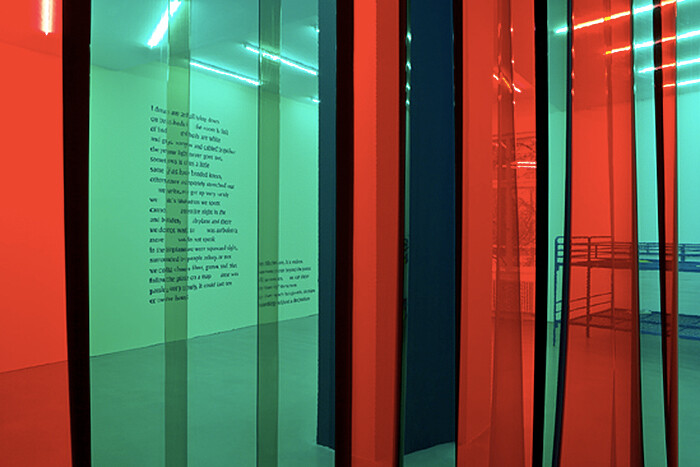
“Return to Noreturn” revisits Dominique Gonzalez-Foerster’s 2008 exhibition in the Turbine Hall of London’s Tate Modern. The anterior references and influences that are often implicated in her works are therefore doubled here, incorporating not only the original exhibition, but also the triggers—personal, literary, historical, cultural—that informed it. Add to this the fact that the Turbine Hall exhibition imagined a scenario projected 50 years into the future—its title was “TH 2058”—but that we are now invited to look back at it from the vantage point of 2012, and the complexity has been shifted up a gear: chronology seems to fold in on itself. With a characteristically light-fingered touch, Gonzalez-Foerster indicates this complexity without laboring it. And indeed for those viewers who, like me, had not seen the original exhibition, it has come to exist instead as a kind of dream-like shared memory.
The solipsistic title alone immediately establishes a framework of references for the exhibition, but rather than fixing intransient points, they work through concentrated evocation. A series of considered measures, or perhaps rather “moments” (a word the artist is fond of using), set the atmosphere. On entering the gallery, we are at once separated from the outside by passing through a …
April 27, 2012 – Review
7th Berlin Biennale
Ana Teixeira Pinto
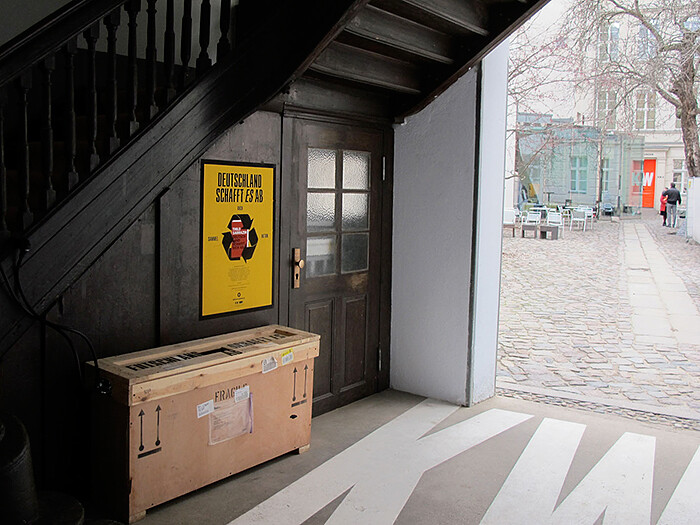
“Forget Fear!” could be the title of Die Hard’s next installment. But it’s actually the title of the 2012 Berlin biennial. The parallels with the “good cop gone rogue” idiom are not accidental. The 7th Berlin biennial, curated by Artur Żmijewski in collaboration with associate curators Joanna Warsza and the group known as Voina seems to be caught in a pragmatic contradiction: it stands for left-wing positions through the enactment of right-wing methods and “vigilante” rhetorics.
The curatorial statement, written by Żmijewski—keeping with the spirit of the communications the biennial has been releasing—begins with a litany of complaints about the inadequacy of art and the weakness of its positions, expressed in a disillusioned, confessional tone, which mirrors the television trope of a lone hero battling a multitude of soul-less bureaucrats and single-minded apparatchiks. “I have been working in art, and in its cause, for years. It has become a way of life for me, life itself, and a passion. For years I have been observing its possibilities and limitations. But a few years ago I stopped ‘needing’ it. I used to like visiting galleries, anticipating the thrill that comes when you see reality filtered though the mind of an artist. Today, …
April 22, 2012 – Review
Candida Höfer’s "Neues Museum Berlin"
Kimberly Bradley
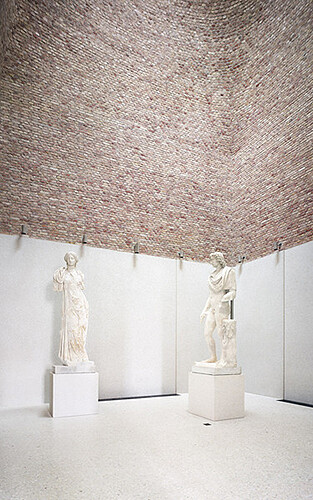
What could you possibly say about Candida Höfer that’s not been said before? The German photographer has been around for a long time, doing mostly one thing—shooting apparently flawless, always unpeopled images of monumental public interiors—since her career began in the 1970s.
As distant and calculated as they are breathtakingly detailed and often ornate, Höfer’s oversize photographs depict meticulously composed spaces, indeed, social spaces, such as museums and libraries emptied of their occupants. That’s how her pictures evoke almost ghostly atmospheres. But her methods are predictable—she tends to shoot smaller spaces on the diagonal; larger spaces straight on, and, in the latter case, with the horizon or focal point frequently just below the picture’s center. Her subjects range from the well-visited (the Louvre, Teatro la Scala, MoMA) to the obscure (the Viking Museum of Oslo). She’s big, bold, and Germanically cold, like her cohorts Thomas Ruff, Thomas Struth, and Andreas Gursky; the whole lot of whom studied, of course, at the Düsseldorf Art Academy under Bernd and Hilla Becher.
But we know all of this already. What we didn’t know upon entering Johnen Galerie in Berlin is what her take might be on the Neues Museum, the subject of her newest exhibition …
February 28, 2012 – Review
Alicja Kwade’s "In Circles"
Kimberly Bradley
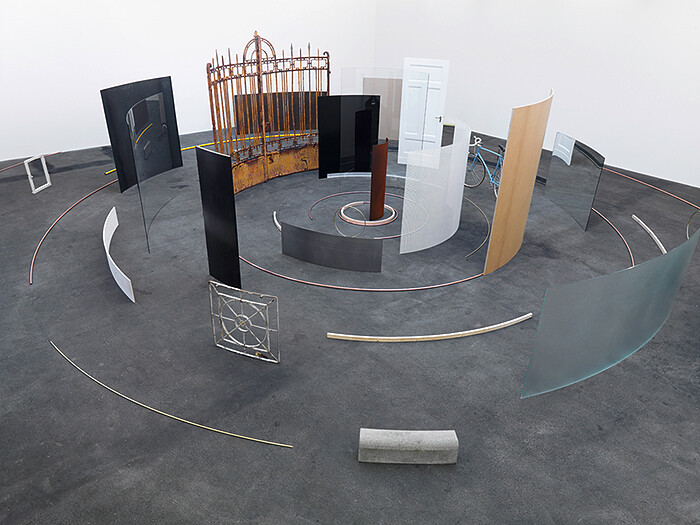
“Round and round she goes; where she stops, nobody knows.” This little rhyme popped into my mind as I entered Johann König’s gallery for Alicja Kwade’s current solo show, “In Circles.” A mad array of 54 industrial and everyday objects loosely arranged in concentric rings fills the gallery’s front space in a large-scale installation titled Die Gesamtheit aller Orte (2012), which beckons to the viewer walk along each ring to see what he or she can see.
It’s easy to trace the curves in Kwade’s perfectly placed bent tubing and piping, but it takes a second to realize that even the installation’s larger, solid objects—a door, a window, mirrors, iron gates, sheets of metal, and even a bicycle—not only travel on her orbits’ paths, but have also been altered (in some cases just barely) to conform to them. The white door’s slight curvature is hardly noticeable until you’re at close range. The imposing rusty gates are generously rounded. There’s an almost imperceptible bend to a door with an oval mirror. A few copper pipes in the outermost rings disappear into the gallery wall; in the very center of the installation, a two-euro coin, propped up on its rim, and a sharply …
January 13, 2012 – Review
Jos de Gruyter & Harald Thys’s "Im Reich der Sonnenfinsternis"
Ana Teixeira Pinto
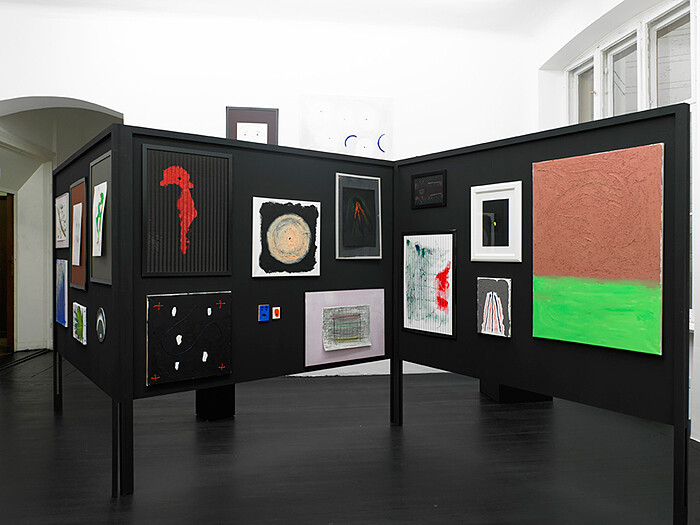
“Nothing is funnier than unhappiness.” After seeing “Im Reich der Sonnenfinsternis” the bleak exhibition by Jos de Gruyter and Harld Thys currently on display at Isabella Bortolozzi in Berlin, Beckett’s utterance comes to mind.
“Im Reich der Sonnenfinsternis” (In the Empire of the Solar Eclipse, 2011) is presented as the postmortem retrospective of a fictional character named Johannes, a middle-aged, middle-class, amateur painter who has recently taken his own life. Johannes, it appears, was a prolific painter, his oeuvre comprising some 120 small-scale works installed throughout the gallery and on free-standing display boards. Together with his wife Hildegard and his video-artist friend Fritz, Johannes is also a protagonist of the video Das Loch (The Hole, 2010) screened in the gallery’s back room.
Das Loch (The Hole) does its name justice and sitting through it is a daunting experience. All of the characters in the video are mannequins made of polystyrene foam. Yellow-faced Johannes appears in a beret and a rugged beard, Hildegard is a matronly spectacled old lady, and Fritz dons a goatee and sunglasses. The background is a barren grey and the props are paltry. They speak in the halting and toneless voices of speech software. Though their monologues are heartwrenching, …
December 14, 2011 – Review
Laura Horelli’s “The Terrace”
John Beeson

From the first, Laura Horelli’s exhibition “The Terrace” is a movement backwards; a complex history is laid out for us to enter and reconstruct. Along the wall leading away from the gallery’s entrance is a series of six images and texts entitled Terrace of European Single Person in Kileleshwa (2011), which reveal information progressively. The first photograph depicts a young girl entering from a terrace, where a woman sits on a wicker chair before a backdrop of exotic plants. To the left of that photograph is a text describing a house topographically, designating spaces as private, public, or those used by the domestic staff. To the left of that is the house’s architectural floor plan. Next is a black-and-white illustration from a book depicting that same terrace from the first photograph, but as seen from the garden beyond it. Then we see the original version of that photo in full color. Lastly, we encounter a text revealing that everything we have just seen pertains to the Finnish artist’s childhood home in Nairobi, Kenya. The series appears to have been developed from a method at once inquisitive and analytical, based on personal understanding as well as empirical research.
Such is the variable …
October 29, 2011 – Review
Bojan Sarcevic’s "At Present"
Ana Teixeira Pinto
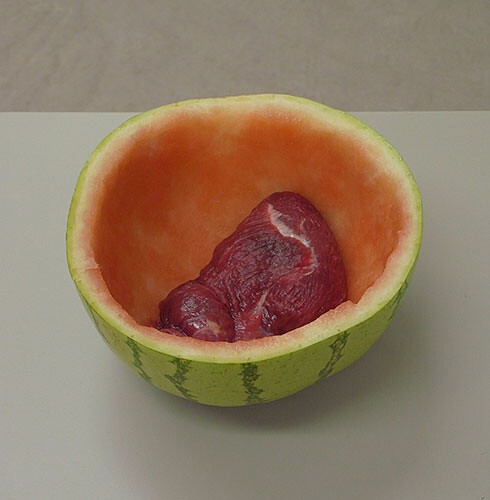
“At present,” everything is at steak [sic].
“One must dance until the music stops,” to quote the sentence made famous by a Citigroup manager in the aftermath of the financial crisis of 2008. The music, however, had long since stopped when he said it. There is a similar after-party feeling to Bojan Sarcevic’s “At Present” show at BQ gallery, Berlin. In an otherwise empty room, one finds a slab of steak inside a hollowed-out watermelon, like the leftovers of any given barbecue, hallowed atop a minimal plinth; and a photograph of a white Daihatsu Charade parked on a snowy street, with a PALESTINE decal in the rear window.
Are these downtrodden objects meant to symbolize a downtrodden people? Is the piece of meat an allusion to the “bare life” of the stateless Palestinians? Maybe. But the small Daihatsu Charade is not the only riddle in the room, and the divested state of the objects on display stands in stark contrast with the dynamism of the artist statement, which one finds near the entrance in lieu of a press release. With a series of open-ended questions, Bojan Sarcevic asks if we live in the most conformist phase of modern history, whether there can …
October 11, 2011 – Review
Blake Rayne’s "Shade Subscription"
Bruno Macaes
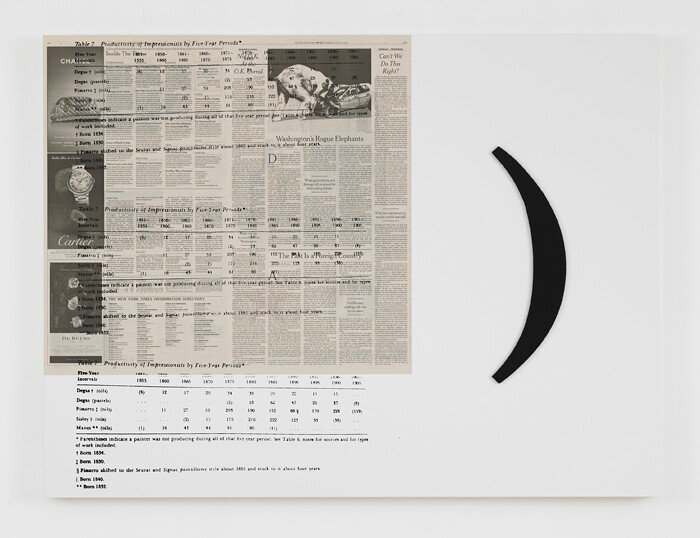
An autumnal smiley face—made out of two bicycle wheels, some tree twigs, and some dry leaves (freckles from summer?)—is the first thing greeting the viewer of Blake Rayne’s “Shade Subscription.” Once we go behind the wall abutting this work, named after the artist himself, Blake (2011), it seems only appropriate that we should now come upon the hapless bicycle frame, turned upside down: a true downer, a bike going nowhere.
The logic of the readymade dictates as much, as Rayne illustrates with his series of paintings Rest in Shade (2011). There are literally endless issues of the New York Times that could have been used here, a new one being produced every day. But Rayne has chosen to show us only the reverse side of the front page, which has its daily constants: Chanel, for instance, has a monopoly on the upper-left-hand corner of page two. But by superimposing these newspaper pages with a scholarly graph showing us the number of paintings produced each decade by some famous Impressionists, Rayne wants to suggest that the same logic—endless production across a spectrum of variations—was at play in their work. On this point the current show adds an intriguing suggestion. Perhaps there is …
September 9, 2011 – Review
"About Painting"
Ana Teixeira Pinto

The fourth edition of the ABC (Art Berlin Contemporary) is fated to be the most contentious: the show is being held against the background of Art Forum Berlin’s demise—the city’s official art fair that has ceased to exist after negotiations to merge the two events collapsed. While ABC began as a response to discontent with Art Forum Berlin, the shows had coexisted for some years—Art Forum Berlin as a traditional art fair venue and ABC taking a more experimental approach. But now ABC stands as Berlin’s lone trade fair. Art Forum Berlin’s cancellation announcement squarely blamed the organizers of ABC, who are accused of not committing to a joint venture. Yet placing decisions over its future in the hands of a dissident group reveals the weakened position from which Art Forum Berlin entered the negotiations. Berlin has been debating whether this represents a drawback: however, pitching Art Forum Berlin as an “open,” democratic event against ABC’s elitism is a faulty argument. Art Forum Berlin produced as much exclusion as any other art fair—and the plethora of satellite venues surely indicated this. The real issue is rather how inclusion is managed—unlike an art fair, ABC has no peer review admission system, …
June 11, 2011 – Review
"based in Berlin"
Michèle Faguet

As the debate over the alleged mishandling of the mysterious E. coli outbreak in Germany raged on in the local and international press, Berliners had their own little controversy to distract themselves with: the opening of the mega-exhibition “based in Berlin,” warily anticipated (and even boycotted) by many members of the local art community distrustful of the motives behind the project’s conception. First presented in October 2010 as a Leistungsschau (showcase) of the much-touted contemporary art scene in Berlin, this survey exhibition was headed up by Christine Macel, Hans Ulrich Obrist, and Klaus Biesenbach as the first step in a long-term initiative to eventually establish a permanent Kunsthalle in Berlin—a decades old issue that has become a significant part of the political agenda of Mayor Klaus Wowereit (of “poor but sexy” fame).
Protests were quick to follow the open-call for artists in Berlin to submit their portfolios, and soon thereafter a group of young “under-curators” (Angelique Campens, Fredi Fischli, Magdalena Magiera, Jakob Schillinger, Scott Cameron Weaver) were appointed to run around town doing the dirty footwork, hopping from studio to studio in a huff-and-puff attempt to get this (vaguely defined) show off the ground. A series of heated discussions hosted by …
May 12, 2011 – Review
Martin Creed’s "Paintings" at Johnen Galerie, Berlin
Kirsty Bell
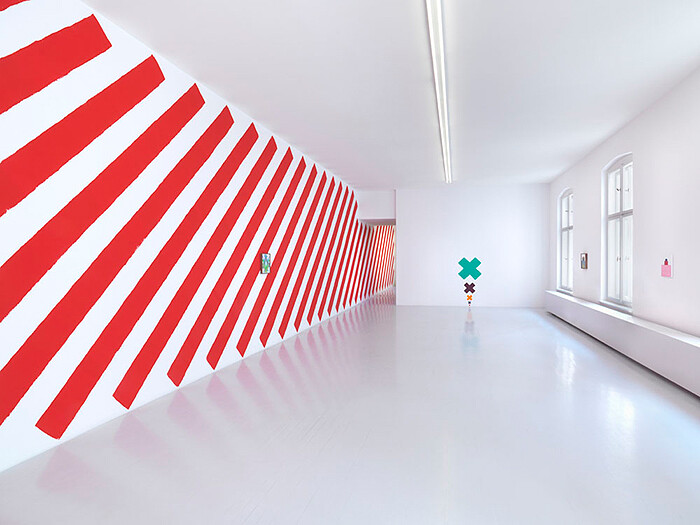
What should we make of paintings made by an artist whose self-declared maxim is “The Whole World + The Work = The Whole World”? Whether this stands for an expansive, optimistic “anything goes” or a reductively pessimistic hopelessness is largely a question of personal temperament, or indeed of momentary mood. The same goes for Martin Creed’s paintings. Just as the two-way perspective of expansion/reduction or optimism/pessimism informs the artist’s more well-known, equally binary works—the lights in a room going on and off, for instance, or a set of curtains automatically opening and closing—so these super simplistic, at times downright ugly paintings balance on a knife edge between the profound and the inane.
Though no doubt cannily aware of their painterly predecessors, Creed’s paintings have as little to do with a history of painting as his works on paper have to do with a tradition of drawing, be it an A4 sheet crumpled into a ball—folded up and opened out again—or covered all over with colored marker. Instead they make sense within Creed’s conceptual, or rather existential (compulsive, even?) approach to art-making as a means through which to determine and articulate order within the chaos and contradictions of the material world. As …
April 13, 2011 – Review
"The Bell Show" at Lüttgenmeijer and "The Gong Show" at Micky Schubert, Berlin
Ana Teixeira Pinto
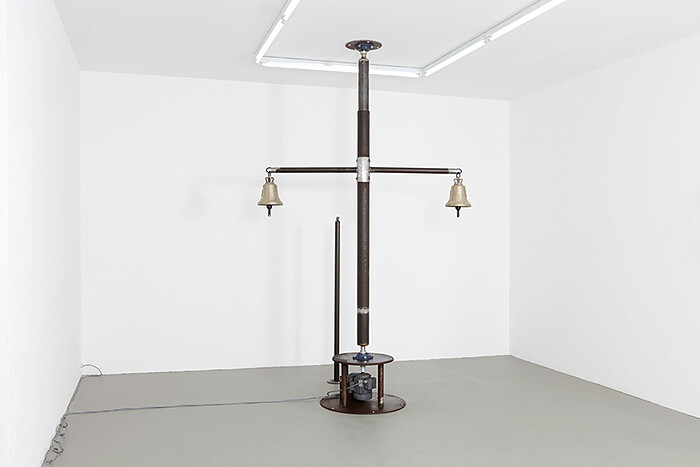
“The Bell Show” and “The Gong Show,” curated by Dieter Roelstraete, is a two-fold exhibition marking the second collaboration between adjacent galleries in the middle of Berlin Tiergarten, Micky Schubert and Lüttgenmeijer. Illustrating their titles, the shows respectively feature works concerning either gongs or bells.
In Lüttgenmeijer’s “The Bell Show” some works are grandiose, like the Teutonic Vertigo-Glocken (Vertigo Bells) (1997) by Carsten Höller. Some are disarmingly tender like The Step When I Forget What I Thought My Calling Was (2011) by Hadley+Maxwell, who also did the most allegorical work of the show, a cryptic memento mori, Away, as in “For Passing Away is the Figure of this World” (2010). Other works appear to be ironic juxtapositions of heroism and advertising imagery, like that of Ruth Ewan or Lothar Hempel. The selection has a histrionic and excessive touch.
“The Gong Show,” just next door, seemed to gather together works of refined containment and minimal nuance. Most are literal, like Wolfgang Tillmans’s Gong (2007); or Zin Taylor’s Black Stool (Darkened Lump) and Black Stool (Nub of Rug) (2011). A few are archival, like Pierre Bismuth’s A Brief Historical Survey of Continuity in the J. Arthur Rank Organization (2011) or Mark Soo’s Noisemaker No. …
March 23, 2011 – Review
James Franco’s "The Dangerous Book Four Boys" at Peres Projects, Berlin
Adam Kleinman
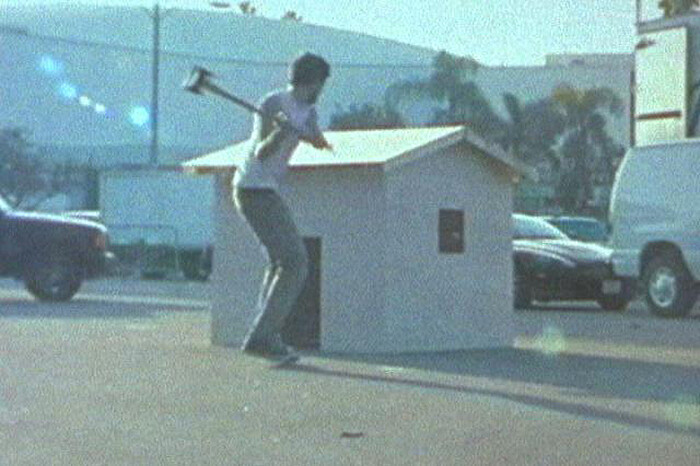
Parmenides once said, “nothing comes from nothing,” all matter is born of some other stuff, transformed. In parallel, ideas build off forbears. Thus, all art, as with all exchanges, is derivate, and at the same time, potentially transformative. Even so, there is a slight irritation when a new voicing resembles too closely an antecedent. To this end, critics have tried to define the difference between an inspiration and a copy by formulating the pejorative term “plagiarize” to denote theft—around the time the liberal idea of personal property was also in development. In suite, an academic calculus was set in place to regulate these moral issues in its closed system. However, no such measure exists in colloquial speech other than public opinion. In fact, in popular culture, the “transformative nature,” often the yardstick to defend allowable “borrowing,” tends not to be aimed at the work or ideas themselves, but at the ability for the performer to make the appropriation part of their persona. In other words, the transformation comes when the actor “owns it” by reaching a level of intrigue and publicity in an action, a use, or reuse of various forms. This acceptance becomes the transformative act itself; communication is …
March 10, 2011 – Review
Cerith Wyn Evans’s "Assemblage" at Galerie Neu, Berlin
Kirsty Bell

It is unusual that a work sums up an artist’s practice and sensibility so acutely and simply as the single piece exhibited in Cerith Wyn Evans’s “Assemblage” at Galerie Neu. Imagine the bling of an enormous Murano glass chandelier, blinking its way through a score of Bataille in Morse code, combined with the flash of a circle of words set in fireworks that blaze and burn out, and filtered through the fleeting gorgeousness of a thought in white neon (“Thoughts unsaid, now forgotten”) and you’ll get a sense of this work.
Wyn Evans is a practiced évocateur, bearing armfuls of weighty intellectual or cultural references (Pasolini, Stein, Debord, Mallarmé) while not shying from the seductive possibilities of their packaging: crystal chandeliers, fireworks, neon, mirrors, music, mobiles. Though the works themselves may appear like ephemeral thoughts suddenly clothed in three dimensions, they embody desire just as much, while revealing the impossibility of capturing either. Light, heat, reflection, sound, air: the qualities Wyn Evans employs to animate his works are themselves transient, determined by the perception of the viewer. In Assemblage, a lack of permanence permeates—and the essentially tragic passage of time, whether the simple fact of our mortality or the compound losses …
February 23, 2011 – Review
Olaf Nicolai and Annika Eriksson at "Symphony" a performance series by SOUNDFAIR at VeneKlasen/Werner in Berlin
April Lamm
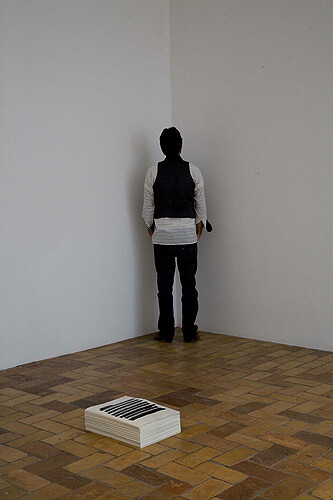
A heady gallery opening experience last October found a few scattered souls humming to themselves in a series of empty rooms. At that same gallery one month later, a man performed a pantomime of sorts on invisible strings. Standing over a block of wood with a radio antennae sticking out of the top, hands like marionettes, either he controlled or was controlled by the spooky sounds coming through the loudspeakers, providing comic relief for a town otherwise known for its techno. These two independently curious productions—by Olaf Nicolai and Annika Eriksson respectively—were orchestrated by Clara Meister, the curator ringmaster of music experiments in Berlin these days. Through the collaborative project Soundfair, Meister commissions artists to participate in the performance series “Symphony,” held sporadically at VW (VeneKlassen/Werner) over a period of 6 months. “Symphony,” thus, invites artists to step into the skin of a musician and, likewise, musicians to step into the bubble of a gallery space for an evening.
So to better clarify: Olaf Nicolai’s disparate hummers were not your usual repressed neurotic whistling types. They were performing, in all seriousness, Romanticist Robert Schumann’s direction to the musician, in-between the staves of his “Humoresque Op 20,” which reads, “innere Stimme” (inner …
February 7, 2011 – Review
Javier Téllez’s "O Rinoceronte de Dürer" at Arratia, Beer, Berlin
Ana Teixeira Pinto
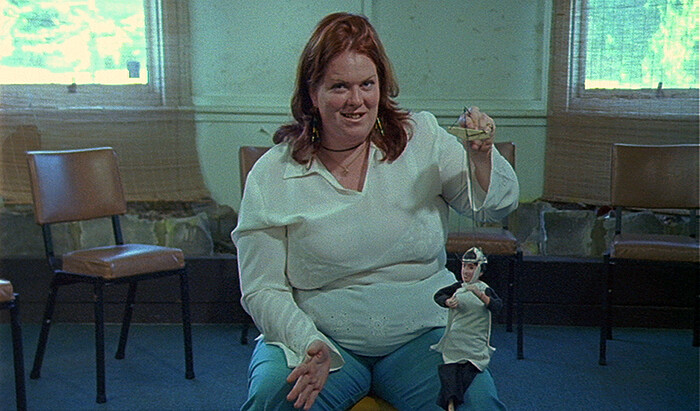
With both parents working as practicing psychiatrists, Javier Téllez tells us that early in life he found it difficult to distinguish the boundaries between normalcy and pathology. Having experienced the plight of mental patients from an all-too-personal perspective, he soon began to embrace collaborations with the mentally afflicted as his preferred working method. Though formally diverse, his films La Passion de Jeanne d’Arc - Rozelle Hospital, (2004), Caligari und der Schlafwandler, (2008) or Oedipus MarshallI, (2006) all share a common thread: Téllez actively engages patients of local clinical facilities in the structuring of each project. The acting thus becomes a poignant testimony to the dialectics of authoritarianism and disenfranchisement, making manifest how exclusion, abandonment, and poverty are determining features of the patients’ illnesses, from whose perspective society is a symptom and culture a communication code defined as much by what it excludes as by what it embraces.
His most recent show, “O Rinoceronte de Dürer” (Dürer’s Rhinoceros), at Arratia, Beer in Berlin, clearly elects the eponymous film Téllez shot in Lisbon in 2010 as its core piece. Originally commissioned by Isabel Carlos for CAM-Gulbenkian, the project was filmed at the panopticon of the Hospital Miguel Bombarda, built in 1896 and kept …
November 11, 2010 – Review
Thomas Struth at Galerie Max Hetzler, Berlin
Michèle Faguet
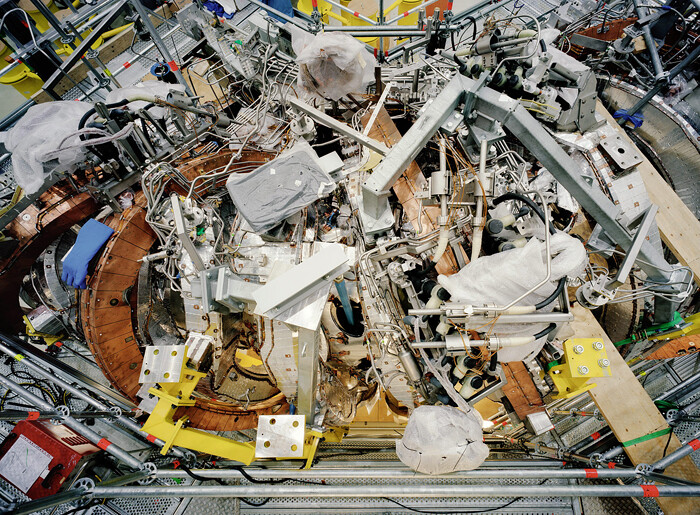
Like the images of empty streets of his hometown Düsseldorf, and the cities he visited and photographed as a young artist in the late 70s and early 80s—New York, Rome, Paris, Brussels—Thomas Struth’s recent group of photographs depict the landscapes of technological infrastructures in which the makers of these structures (i.e., human beings) are largely absent. With some of his largest works to date, this exhibition included fifteen exquisitely rendered documents from the artist’s travels to places like Geoje Island in South Korea or Cape Canaveral, Florida, as he visited research centers, laboratories, and construction sites dedicated to the development of new technologies but largely invisible to the collective imaginary.
Tangles of brightly colored cables and tubes, i.e., the innards of machines, have been shot from a proximity that inhibits a central perspective, making it impossible for any layperson to identify what they are seeing (or comprehend even after reading about them on the Internet) in works like Stellarator Wendelstein 7-X, Detail, Max Planck IPP, Greifswald or Tokamak Asdex Upgrade Periphery, Max Planck IPP, Garching (both 2009). The result is an experience of visual and conceptual vertigo, seductive in its dizzying capacity to make the viewer feel small and insignificant—an operation …
October 27, 2010 – Review
Danh Vo’s "All your deeds shall in water be writ, but this in marble" at Isabella Bortolozzi Galerie, Berlin
Ana Teixeira Pinto
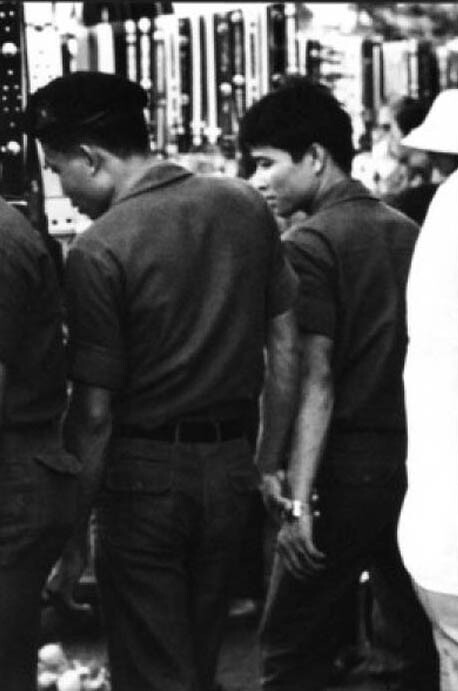
Born in Vietnam but raised in Denmark, Danh Vo is a “man without qualities.” “What he thinks of anything will always depend on some possible context – nothing is, to him, what it is; everything is subject to change, in flux, part of a whole, of an infinite number of wholes presumably adding up to a super whole that, however, he knows nothing about.” (Robert Musil). Or, as Vo himself put it, someone who sees the use of things when he can’t find the meaning in them.
Vo became known through a number of maverick projects. For his solo show “Not a Drop but the Fall” (2005) in gallery Klosterfelde, Vo duped both the Danish Art Council and his former boyfriend Michael Elmgreen into unwittingly supporting a fake application. Under the name of the famous art-duo Elmgreen & Dragset, he received funding to travel to Marfa, Texas, and document the opening of their Prada shop project, which he later showed together with the scam’s paper trail. In the ongoing project Vo Rocasco Rasmussen (2003-) Vo married and divorced several people in order to accumulate a succession of last names intended to bewilder customs’ officers.
For his graduate exhibition, Vo asked his family …
October 13, 2010 – Review
art forum berlin & abc art berlin contemporary: "light camera action"
Kirsty Bell
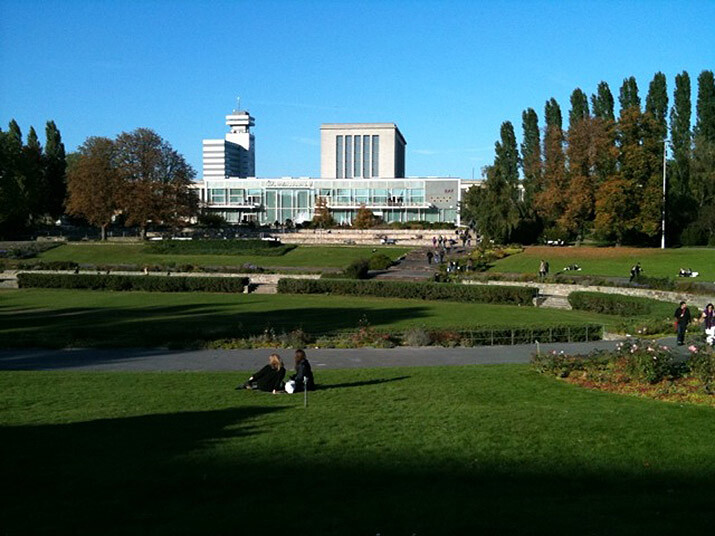
Strolling through the landscaped gardens—past elegant fountains and late blooming roses—that connect the light drenched 1930s halls staging Berlin’s art forum art fair and the abc art berlin contemporary exhibition in the 1950 Marshall Haus pavilion, it was easy to forget the gallery politics that have until this year separated the two. abc was founded in 2008 by the founders of Berlin’s popular “Gallery Weekend” event as a concurrent rival to the art fair, challenging the need for such a conventional sales platform in a city which may be the European capital of art production, but is definitively not a center of art collection. The alternative they came up with—a baggy exhibition of art works selected by individual galleries according to a chosen theme and installed in a large hall—was riddled with awkward ambiguities. Though insisting on its status as an independent exhibition, it was in effect an art fair without the booth walls, with gallerists hovering uncertainly near the large-scale works they had paid to have installed there. In its third incarnation, abc’s rather disingenuous self-promotion as an experimental “free” exhibition format seems even more strained, despite the smartly chosen theme of the influence of film on contemporary art …
September 23, 2010 – Review
Rashid Johnson’s "There are Stranger Villages" at Guido W. Baudach, Berlin
Kirsty Bell
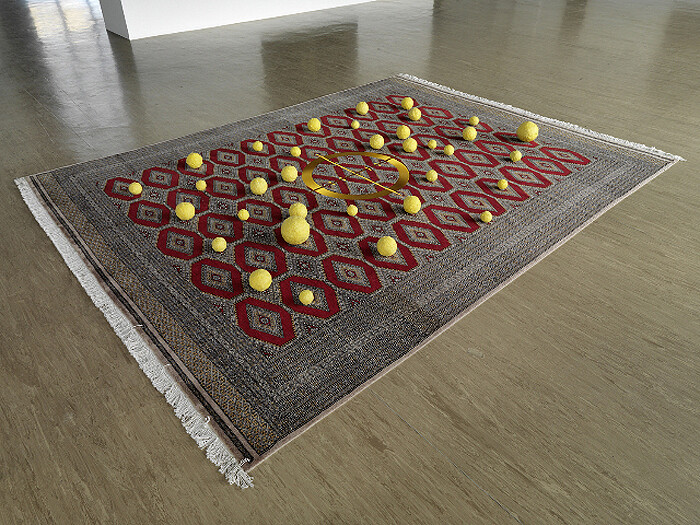
The title of Rashid Johnson’s first solo show in Berlin makes a sideways allusion to “Stranger in the Village,” an essay written in 1955 by American writer and civil rights activist James Baldwin. This is worth bearing in mind; not because the situation in Berlin mirrors that of the remote Swiss village in which Baldwin found himself as the first black man the astonished villagers had ever seen—as Johnson says, “there are stranger villages”—but nevertheless, the African-American experience of racism, inseparable as it is from the ugly legacy of slavery, hatred, and exploitation, has a different timbre to that in Europe. “I am a stranger here,” said Baldwin, “but I am not a stranger in America.”
Johnson’s works take up the question of African-American identity and present its symptoms in object form. Despite their local production—Johnson spent the summer living in Berlin to produce the exhibition—the works here revisit several of the artist’s now signature forms and themes. Large black wall-mounted panels with perpendicular shelves supporting various objects such as house plants, books, record covers or small bronze sculptures; black-and-white portrait photographs with a nineteenth-century feel; small paintings with dense black and white cosmologies arrived at by covering the canvas with …
September 10, 2010 – Review
Temporäre Kunsthalle Berlin
Michèle Faguet
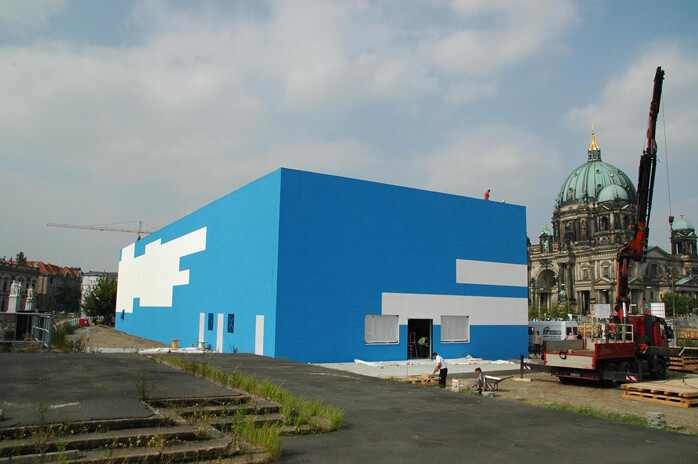
Sometime in the wee hours of September 1, 2010, the Temporäre Kunsthalle Berlin, true to its name, permanently closed its doors. Initially weary of its program, the TKB’s audience had become massive—if not always enthusiastic—during the course of the institution’s brief, yet tumultuous, history. Over 200,000 visitors drawing both from the city’s cultural set (artists, curators, writers) as well as its sizeable tourist population (flocking from Museum Island directly across the road) attended the nine exhibitions and five project room shows (with many more thousands seeing the three façade projects)—impressive numbers that nevertheless fell short of patron Dieter Rosenkranz’s much publicized wish for 1,000 visitors daily to the (million-Euro) white cube his private foundation, Stiftung Zukunft Berlin, had made possible.
The story has been told countless times in the local press and goes something like this. During the last days of the iconic Palast der Republik—a GDR cultural center and former home to the East German parliament, demolished in 2008 amidst a slew of controversy—the skeleton of the building served as a makeshift venue for events. Most notable was the DIY week-long exhibition “36x27x10,” curated by Thomas Scheibitz, featuring a vast line-up of international artists residing in Berlin, many of whom …
July 14, 2010 – Review
Liam Gillick’s "1848!!!" at Esther Schipper, Berlin
Kirsty Bell
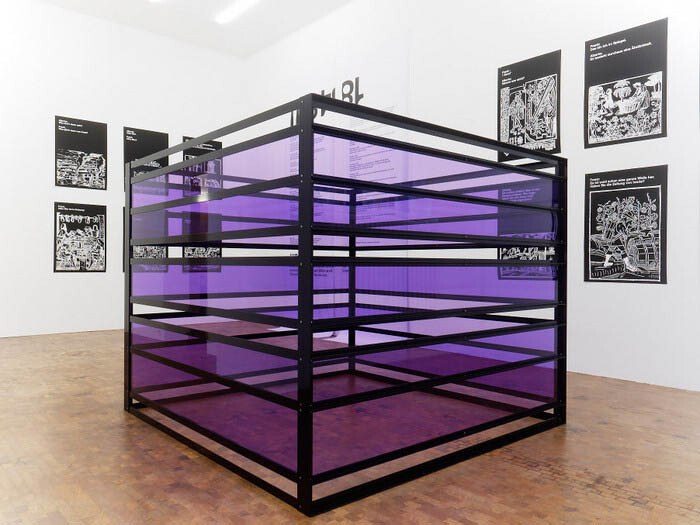
With an exhaustive monographic exhibition currently on show in Bonn, a lengthy touring retrospective recently over, and last year’s opinion-dividing outing in the Venice Biennale’s German Pavilion, not to mention the reams of printed matter and symposia that make up the productive phenomenon that is Liam Gillick, what can a small-scale gallery show have to offer?
“Three key components” of Gillick’s work, or so the press release tells us: “The beginning of a new research process; the re-presentation of an event and a new physical structure.” That the three components themselves appear baffling (at least to the uninitiated) is not unusual with Gillick’s work. It is essentially a given that the visible works, despite their glossy physical character, function rather as stand-ins for a discourse going on elsewhere: a broad, circling, theoretical mesh of questions, quotations, references, and collaborations. Although it is true to say that the exhibition consists of a series of black-and-white inkjet prints, an aluminum and Plexiglass structure, a large paper banner advertising a film, and a film projected large, this fact, it seems, largely misses the point.
This situation is immediately apparent when faced with the works themselves. Each of the black-and-white prints, for instance, combines an image …
July 5, 2010 – Review
John Smith’s "Flag Mountain/Black Tower" at Tanya Leighton Gallery, Berlin
Ana Teixeira Pinto
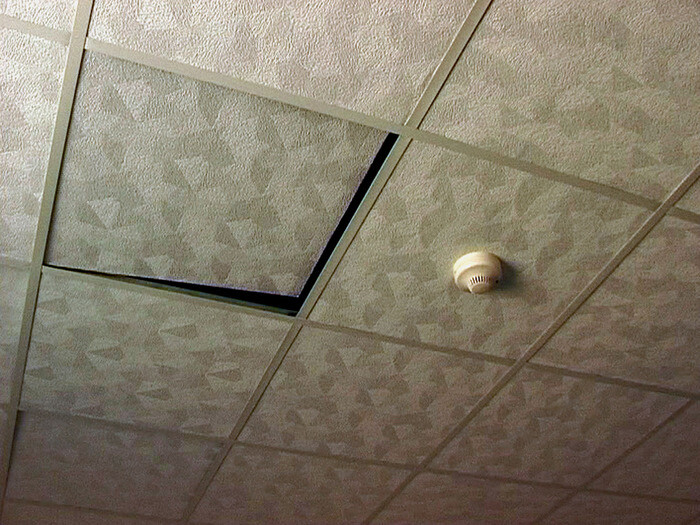
The reason why things don’t remain the same is because they were never thus. Everything contains manifold dialectical possibilities. A man’s home might be his castle, yet no castle is a monolith. No hotel room is a monolith either. In the Bethlehem Inn, the drop ceiling above John Smith’s head flutters in the blowing breeze. The artist films the flapping panels while telling us that the hotel where he is now staying was requisitioned by the military and hastily renovated thereafter. The window has a privileged view over the Israeli-built West Bank wall, which looks as shoddy as the room’s ceiling. Precariousness is the handmaid of oppression. Nothing does a better job at disrupting communal ties than the wasteland of a terrain vague, be it in the Middle East or in East London.
Part of the “Hotel Diaries” series, the aforementioned video, Dirty Pictures (2007) is one of three films currently on display at Tanya Leighton Gallery. Together with The Black Tower (1985-87) and Flag Mountain (2010) they represent some of the recurring and resurfacing motifs of John Smith’s cinematography.
From 1993 to 1996, John Smith worked on Home Suite and Blight, both films about the construction of the M11 Link Road …
June 13, 2010 – Review
6th Berlin Biennale, Part 2
Michèle Faguet
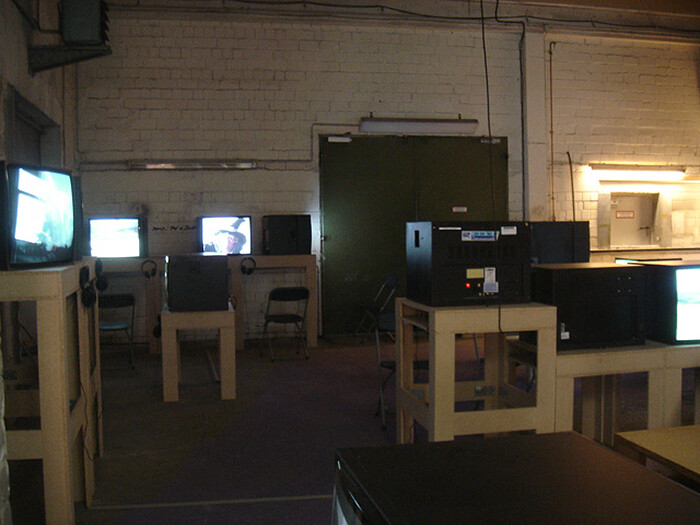
Days 2-3: Thursday, June 10th & Friday, June 11th
Day two began at a nondescript warehouse at Mehringdamm 28 to see an installation of George Kuchar films (selected by film curator Marc Siegel) and a brick, (oddly) chapel-like construction housing new sculptural work by Cameron Jamie. Nestled between parking lots and car-repair shops in an industrial patch that has survived the gentrification of the now semi-posh (and ultra-boring) Bergmannkiez section of Kreuzberg, this venue reminded me of summer in Chelsea in the mid-90s, especially given the rapidly rising heat and humidity, which, as the day wore on, made art-viewing increasingly challenging in a city unprepared for such temperatures. There were twenty-three Kuchar films on view—one of the absolute highlights of this biennale—many of them from his “Weather Diary” series (from the 1980s) that combine cleverly edited footage of approaching tornados outside Kuchar’s cheap motel room with his intuitive and funny commentary. A few hundred meters away, the Cameron Jamie installation consisted of two pitch-black rooms lit only by lanterns provided to a restricted number of visitors allowed to enter at any given time. Jamie himself happened to be around and I overheard him warning one of his companions about the spooky …
June 10, 2010 – Review
6th Berlin Biennale, Part 1
Michèle Faguet
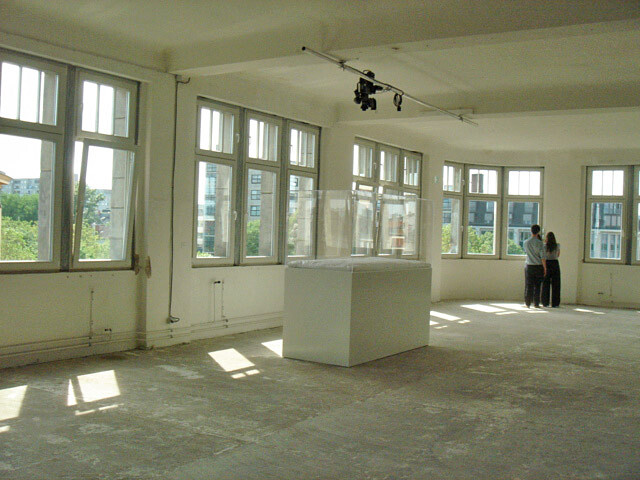
Day 1: Wednesday, June 9th
Curated by Kathrin Rhomberg, the sixth edition of the Berlin Biennale seeks to examine the manner in which art negotiates “reality”—a loaded term, described rather abstractly in the curatorial statement—in a time of historical crisis and renegotiation that begins with the fall of communism and is marked, most recently, by September 11 and the collapse of financial capitalism. With works by forty-five artists from almost twenty countries (the vast majority from Western Europe and the U.S. but with a sizeable number from Eastern Europe), the exhibition is spread out among various venues, most of them in Kreuzberg, in a gesture surely welcomed by many, and consistent with the Berlin art world’s gradual move in the last few years from Mitte (now hopelessly gentrified) to other neighborhoods of the city.
Press accreditation took place in a courtyard lit by unseasonably strong early morning sunshine and was followed by a press conference in which Artistic Director of the German Federal Cultural Foundation Hortensia Völckers candidly discussed the difficulties of finding appropriate venues (the subject of much gossip and speculation in the months preceding the Biennale). Rhomberg expanded on her curatorial premise—abstractly again, although maybe it was the simultaneous translation …
June 10, 2010 – Review
Sex and Sound "Works by Michael Snow: Piano Sculpture and Sex" at Klosterfelde
Ana Teixeira Pinto
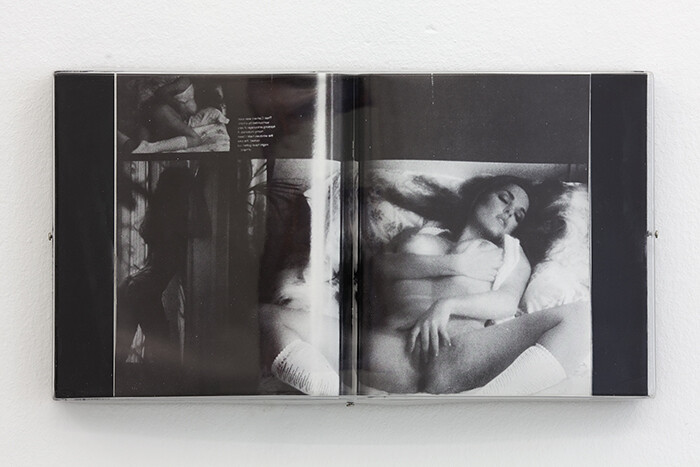
“this freaks me out for some reason”
–TheCGIMaster, comment posted on YouTube, 9 months ago
Klosterfelde gallery’s exhibition of Michael Snow, the poster child for experimental media, perfectly mirrors the maze of his artistic life. Almost an attempt at a comprehensive retrospective, the show spans through several decades of no less diverse production.
In the first room is a work from 1986, Revue: a series of re-photographed Penthouse centerfolds, which were then published in another magazine and photographed again, while making sure the pictures still index the haptic aspects of the open page, like the center crease and the distorted curve. Immediately opposite one can see one of the cut-out women belonging to the Waking Woman series (1961-67), Michael’s Snow signature work for over a decade. The work would create a perfect symmetry with Projection – a 1970 lithographic print of an erected penis penetrating the voided space of its female negative – were it not disrupted by the intruding presence of a gigantic canvas visible through the door to the adjacent room: Paris de judgement Le and/or State of the Arts (2006), in which three naked women obstruct the view of Cézanne’s Bathers (1898-1905). The Rubenesque materiality of their bodies yields a …
Load more